Sercomm RV180W Wireless-N Multifunction VPN Firewall User Manual rv180w admin
Sercomm Corporation Wireless-N Multifunction VPN Firewall rv180w admin
Sercomm >
Contents
- 1. User Manual
- 2. User Manual - Statements
User Manual
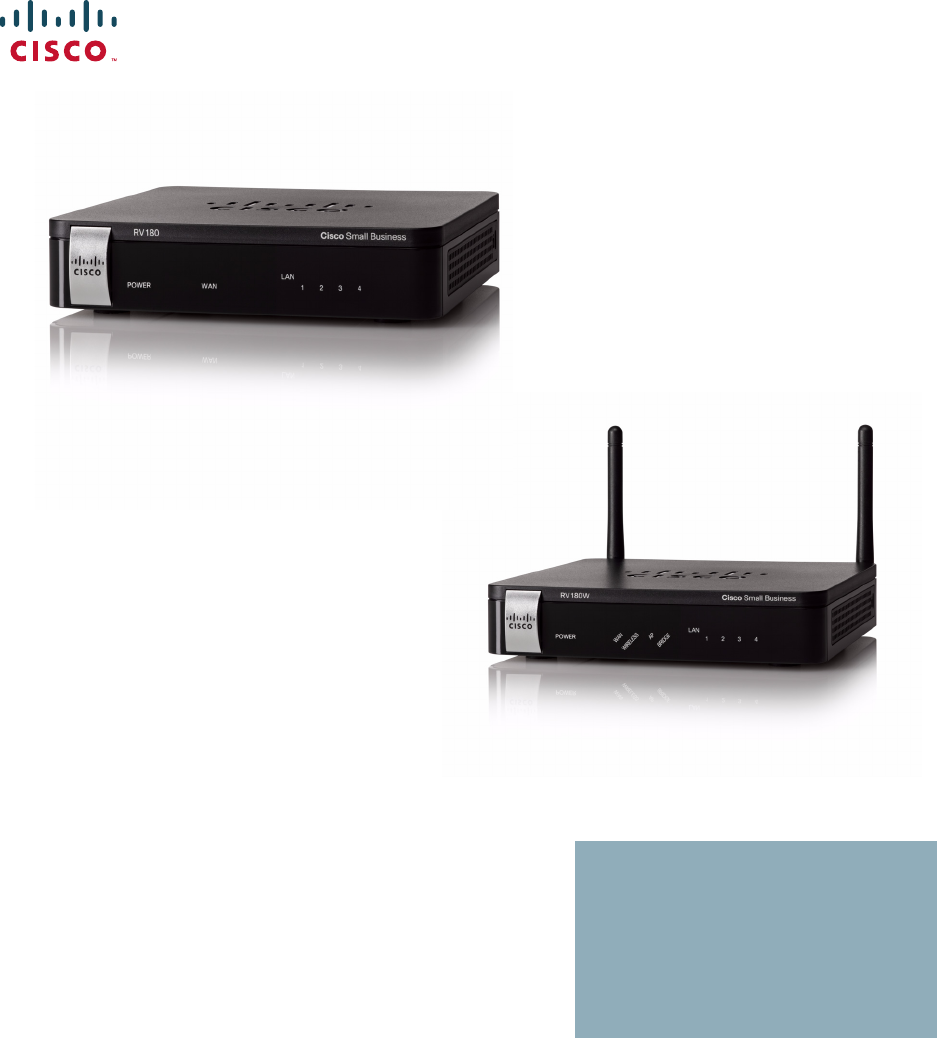
Cisco Small Business
RV180/RV180W Multifunction VPN Firewall
ADMINISTRATION
GUIDE

© 2011 Cisco Systems, Inc. All rights reserved. OL-25662-01
November 2011
Cisco and the Cisco Logo are trademarks of Cisco Systems, Inc. and/or its affiliates in the U.S. and other countries. A listing of Cisco's trademarks can be found
at www.cisco.com/go/trademarks. Third party trademarks mentioned are the property of their respective owners. The use of the word partner does not imply
a partnership relationship between Cisco and any other company. (1005R)

Cisco RV180/RV180W Administration Guide 1
DRAFT - CISCO CONFIDENTIAL
Contents
Chapter 1: Introduction 1
Product Overview 1
LAN Ethernet Interfaces 2
Wireless Access Point (Cisco RV180W) 2
Firewall and VPN Client Access 2
Wireless Distribution System (Cisco RV180W) 2
Virtual Networks 2
Wireless Security (Cisco RV180W) 3
Quality of Service (Cisco RV180W) 3
Configuration and Administration 3
Getting to Know the Cisco RV180 4
Front Panel 4
Back Panel 5
Getting to Know the Cisco RV180W 6
Front Panel 6
Back Panel 7
Mounting the Cisco RV180/RV180W 8
Installation Guidelines 8
Wall Mounting 8
Connecting the Equipment 9
Setting Up the Cisco RV180/RV180W Using the Setup Wizard 13
Using the Getting Started Page 14
Navigating through the Pages 16
Saving Your Changes 18
Viewing the Help Files 19
Connecting Devices to Your Wireless Network 19
Configuration Next Steps 20
Chapter 2: Configuring Networking 24
Configuring the WAN (Internet) Settings 24
Configuring the IPv4 WAN (Internet) 25

Cisco RV180/RV180W Administration Guide 2
DRAFT - CISCO CONFIDENTIAL
Contents
Configuring Automatic Configuration (DHCP) 25
Configuring Static IP 26
Configuring PPPoE 26
Configuring PPTP 27
Configuring L2TP 28
Configuring MTU Settings 29
Configuring the MAC Address 29
Configuring PPPoE Profiles 30
Configuring the LAN (Local Network) Settings 32
Configuring IPv4 LAN (Local Network) Settings 32
Configuring the Host Name 32
Configuring the IP Address 32
Configuring DHCP 33
Configuring the DNS Proxy 35
Configuring Virtual LAN (VLAN) Membership 35
Enabling VLANs 35
Creating a VLAN 35
Configuring Multiple VLAN Subnets 36
Configuring Static DHCP 37
Configuring Advanced DHCP Settings 38
Configuring Automatic Configuration Download 38
Adding a DHCP Client to Configuration File Map 39
Viewing DHCP Leased Clients 39
Configuring RSTP (Cisco RV180W) 39
Configuring Jumbo Frames 40
Configuring Routing 41
Choosing the Routing Mode 41
Viewing Routing Information 42
Configuring Static Routes 43
Adding a Static Route 44
Configuring Dynamic Routing 45
Configuring Port Management 46
Configuring Dynamic DNS (DDNS) 47
Configuring IPv6 48
Configuring the IP Mode 48

Cisco RV180/RV180W Administration Guide 3
DRAFT - CISCO CONFIDENTIAL
Contents
Configuring IPv6 WAN Settings 48
Configuring IPv6 LAN Properties 50
Configuring IPv6 Routing 51
Configuring Static Routing 51
Adding a Static Route 52
Configuring Tunneling 53
Adding an ISATAP Tunnel 53
Configuring Router Advertisement 54
Configuring Router Advertisement Prefixes 55
Chapter 3: Configuring the Wireless Network
(Cisco RV180W) 58
A Note About Wireless Security 58
Wireless Security Tips 59
General Network Security Guidelines 60
Understanding the Cisco RV180W’s Wireless Networks 61
Configuring Basic Wireless Settings 61
Configuring Security 63
Configuring MAC Filtering 65
Configuring Wi-Fi Multimedia 66
Configuring Wireless Network (SSID) Scheduling 67
Configuring Advanced Wireless Settings 68
Configuring Rogue Access Point Detection 69
Enabling Rogue AP Detection 69
Authorizing a Rogue AP 69
Adding and Editing Authorized APs 70
Configuring Wi-Fi Protected Setup 70
Configuring a Wireless Distribution System (WDS) 71
Configuring Load Balancing 72
Chapter 4: Configuring the Firewall 74
Cisco RV180/RV180W Firewall Features 74
Configuring Access Rules 76

Cisco RV180/RV180W Administration Guide 4
DRAFT - CISCO CONFIDENTIAL
Contents
Creating an Access Rule 77
Configuring Attack Prevention 80
Configuring Content Filtering 81
Configuring URL Blocking 83
Configuring Port Triggering 84
Adding a Port Triggering Rule 84
Configuring Port Forwarding 85
Adding a Port Forwarding Configuration 86
Configuring a DMZ Host 89
Configuring Advanced Firewall Settings 89
Configuring One-to-One Network Address Translation (NAT) 90
Adding a One-to-One NAT Rule 90
Configuring MAC Address Filtering 91
Configuring IP/MAC Address Binding 92
Creating Custom Services 92
Creating Firewall Schedules 93
Configuring Sessions 94
Configuring Internet Group Management Protocol (IGMP) 95
Adding Allowed Networks 95
Configuring LAN (Local Network) Groups 96
Enabling Session Initiation Protocol Application-Level Gateway (SIP ALG) 96
Firewall Configuration Examples 97
Chapter 5: Configuring Virtual Private Networks (VPNs) and Security 103
Configuring VPNs 103
Creating Cisco QuickVPN Client Users 103
Configuring a Basic VPN 104
Viewing the Default VPN Settings 105
Configuring Advanced VPN Parameters 105
Configuring IKE Policies 105
Configuring VPN Policies 109
Configuring VPN Clients 114

Cisco RV180/RV180W Administration Guide 5
DRAFT - CISCO CONFIDENTIAL
Contents
Monitoring VPN Tunnel Status114
Configuring VPN Users 115
Configuring VPN Passthrough 116
Configuring Security 117
Using SSL Certificates for Authentication 117
Uploading a Trusted Certificate 118
Generating New Certificate Requests 118
Viewing a Self Certificate Request 119
Exporting a Self Certificate Request 119
Uploading a Self Certificate 119
Exporting the Router’s Current Certificate 120
Using the Cisco RV180/RV180W With a RADIUS Server 120
Adding a RADIUS Server Configuration 120
Configuring Captive Portal 121
Configuring 802.1x Port-Based Authentication 122
Chapter 6: Configuring Quality of Service (QoS) 123
Configuring WAN QoS Profiles 123
Configuring Profile Binding 125
Configuring CoS Settings 126
Mapping CoS Settings to DSCP Values 127
Chapter 7: Administering Your Cisco RV180/RV180W 128
Configuring Language 129
Configuring Password Rules 129
Using the Management Interface 129
Configuring Web Access 129
Configuring User Accounts 131
Setting the Session Timeout Value 132
Configuring Network Management 132
Configuring SNMP 132
Editing SNMPv3 Users 132
Adding SNMP Traps 133
Configuring Access Control Rules 134

Cisco RV180/RV180W Administration Guide 6
DRAFT - CISCO CONFIDENTIAL
Contents
Configuring Additional SNMP Information 134
Configuring the WAN Traffic Meter 135
Using Network Diagnostic Tools 136
Capturing and Tracing Packets 137
Configuring Logging 138
Configuring Logging Policies 138
Configuring Firewall Logs 138
Configuring Remote Logging 140
Configuring the Discovery Settings 141
Configuring Bonjour 141
Configuring UPnP 142
Configuring Time Settings 143
Backing Up and Restoring the System 143
Importing CSV Files 145
Upgrading Firmware 145
Rebooting the Cisco RV180/RV180W 146
Restoring the Factory Defaults 146
Choosing the Device Mode (Cisco RV180W) 146
Chapter 8: Viewing the Cisco RV180/RV180W Status 148
Viewing the Dashboard 148
Viewing the System Summary 151
Viewing the Wireless Statistics (Cisco RV180W) 154
IPsec Connection Status 155
Viewing VPN Client Connection Status 156
Viewing Logs 157
Viewing Available LAN Hosts 157
Viewing Port Triggering Status 158
Viewing Port Statistics 159
Viewing Open Ports 160

Cisco RV180/RV180W Administration Guide 7
DRAFT - CISCO CONFIDENTIAL
Contents
Appendix A: Using Cisco QuickVPN for Windows 7, 2000, XP, or Vista 162
Overview 162
Before You Begin 162
Installing the Cisco QuickVPN Software 163
Installing from the CD-ROM 163
Downloading and Installing from the Internet 163
Using the Cisco QuickVPN Software 164
Appendix B: Where to Go From Here 166

1
Cisco RV180/RV180W Administration Guide 1
DRAFT - CISCO CONFIDENTIAL
Introduction
This chapter describes the features of the Cisco RV180/RV180W, guides you
through the installation process, and gets you started using the Device Manager, a
browser-based utility for configuring the Cisco RV180/RV180W.
•Product Overview, page 1
•Getting to Know the Cisco RV180, page 4
•Getting to Know the Cisco RV180W, page 6
•Mounting the Cisco RV180/RV180W, page 8
•Connecting the Equipment, page 9
•Setting Up the Cisco RV180/RV180W Using the Setup Wizard, page 13
•Using the Getting Started Page, page 14
•Navigating through the Pages, page 16
•Saving Your Changes, page 17
•Viewing the Help Files, page 18
•Connecting Devices to Your Wireless Network, page 18
Product Overview
Thank you for choosing the Cisco Small Business RV180/180W Multifunction VPN
Firewall.
The Cisco RV180/RV180W is an advanced Internet-sharing network solution for
your small business needs. It allows multiple computers in your office to share an
Internet connection through both wired and wireless connections. The Cisco
RV180/RV180W’s 10/100 Ethernet WAN interface connects directly to your
broadband DSL or Cable modem.

Introduction
Product Overview
Cisco RV180/RV180W Administration Guide 2
1
DRAFT - CISCO CONFIDENTIAL
LAN Ethernet Interfaces
Both the Cisco RV180 and Cisco RV180W models provide four full-duplex 10/100
Ethernet LAN interfaces that can connect up to four devices.
Wireless Access Point (Cisco RV180W)
The Cisco RV180W model provides a wireless access point that supports the
802.11n standard with MIMO technology, which multiplies the effective data rate.
This technology provides better throughput and coverage than 802.11g networks.
Firewall and VPN Client Access
The Cisco RV180/RV180W incorporates a Stateful Packet Inspection (SPI)-based
firewall with Denial of Service (DoS) prevention and a Virtual Private Network
(VPN) engine for secure communication between mobile or remote workers and
branch offices.
The Cisco RV180/RV180W supports up to ten gateway-to-gateway IP Security
(IPsec) tunnels to facilitate branch office connectivity through encrypted virtual
links. Users connecting through a VPN tunnel are attached to your company’s
network with secure access to files, e-mail, and your intranet as if they were in the
building.
You can also use the VPN capability to allow users on your small office network to
securely connect out to a corporate network
Wireless Distribution System (Cisco RV180W)
The Cisco RV180W’s wireless access point supports Wireless Distribution
System (WDS), which allows the wireless coverage to be expanded without wires.
Virtual Networks
The access point also supports multiple SSIDs for the use of virtual networks (up
to 4 separate virtual networks), with 802.1Q-based VLAN support for traffic
separation.

Introduction
Product Overview
Cisco RV180/RV180W Administration Guide 3
1
DRAFT - CISCO CONFIDENTIAL
Wireless Security (Cisco RV180W)
The Cisco RV180W implements WPA2-PSK, WPA2-ENT, and WEP encryption,
along with other security features including the disabling of SSID broadcasts,
MAC-based filtering, and allowing or denying “time of day” access per SSID.
Quality of Service (Cisco RV180W)
The Cisco RV180W supports Wi-Fi Multimedia (WMM) and Wi-Fi Multimedia
Power Save (WMM-PS) for wireless Quality of Service (QoS). It supports 802.1p,
Differentiated Services Code Point (DSCP), and Type of Service (ToS) for wired
QoS, which can improve the quality of your network when using delay-sensitive
Voice over IP (VoIP) applications and bandwidth-intensive video streaming
applications.
Configuration and Administration
With the Cisco RV180/RV180W’s embedded web server, you can configure the
firewall’s settings using the browser-based Device Manager. The Cisco RV180/
RV180W supports Internet Explorer, Firefox, and Safari web browsers.
The Cisco RV180/RV180W also provides a setup wizard. The setup wizard allows
you to easily configure the Cisco RV180/RV180W’s basic settings.

Introduction
Getting to Know the Cisco RV180
Cisco RV180/RV180W Administration Guide 4
1
DRAFT - CISCO CONFIDENTIAL
Getting to Know the Cisco RV180
Front Panel
POWER—The Power LED lights up green to indicate the device is powered on.
Flashes green when the power is coming on or software is being upgraded.
WAN LED—The WAN (Internet) LED lights up green when the device is connected
to your cable or DSL modem. The LED flashes green when the device is sending
or receiving data over the WAN port.
LAN—These four LEDs correspond to the four LAN (Ethernet) ports of the Cisco
RV180. If the LED is continuously lit green, the Cisco RV180 is connected to a
device through the corresponding port (1, 2, 3, or 4). The LED for a port flashes
green when the Cisco RV180 is actively sending or receiving data over that port.
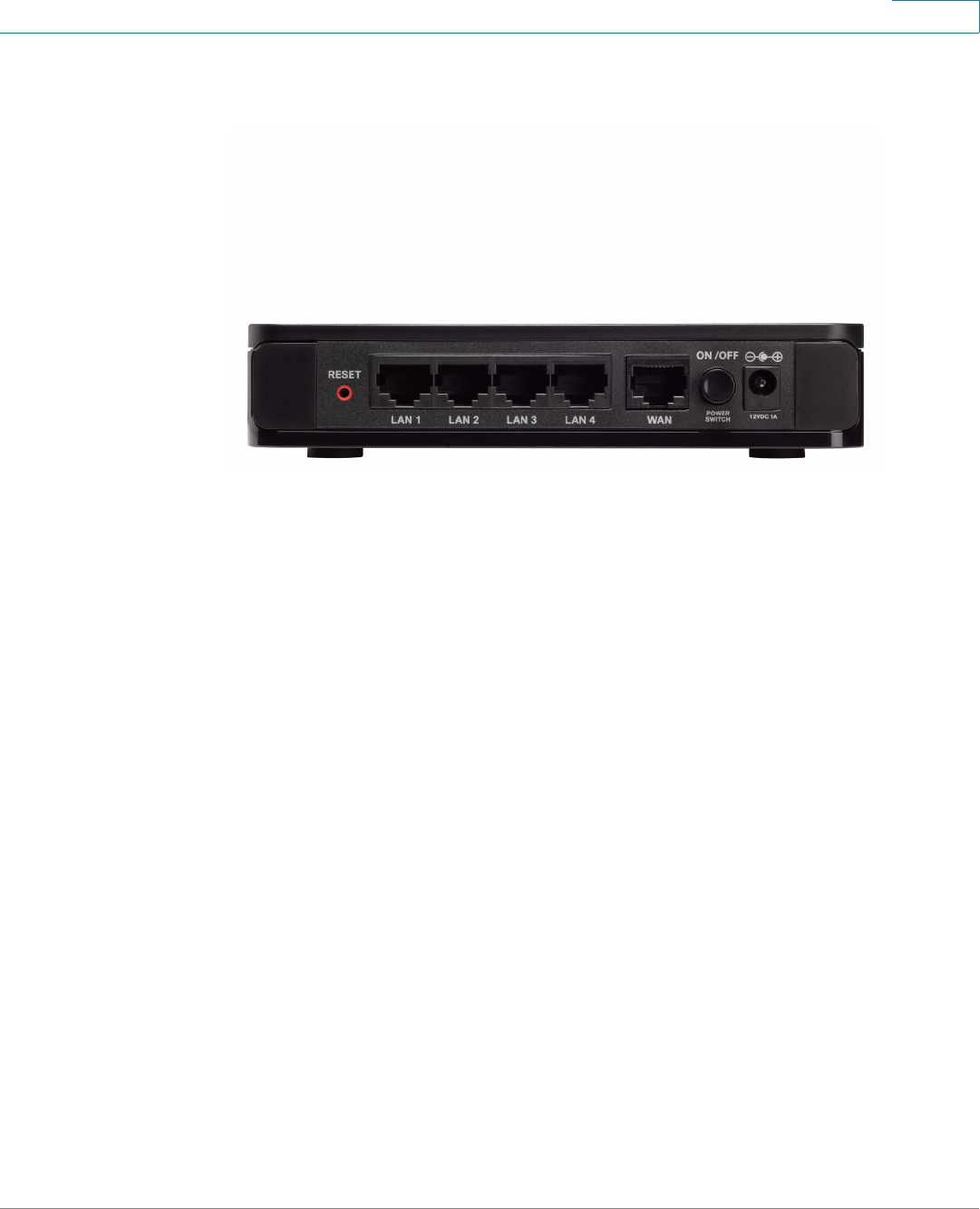
Introduction
Getting to Know the Cisco RV180
Cisco RV180/RV180W Administration Guide 5
1
DRAFT - CISCO CONFIDENTIAL
Back Panel
RESET Button—The Reset button has two functions:
•If the Cisco RV180 is having problems connecting to the Internet, press the
RESET button for less than five seconds with a paper clip or a pencil tip.
This is similar to pressing the reset button on your PC to reboot it.
•If you are experiencing extreme problems with the Cisco RV180 and have
tried all other troubleshooting measures, press and hold in the RESET
button for 10 seconds. This will restore the factory defaults and clear all of
the Cisco RV180 settings.
LAN Ports (1-4)—These ports provide a LAN connection to network devices,
such as PCs, print servers, or additional switches.
WAN Port—The WAN port is connected to your Internet device, such as a cable or
DSL modem.
ON/OFF Power Switch—Press this button to turn the Cisco RV180 on and off.
When the button is pushed in, power is on.
Power Port—The power port is where you connect the AC power cable.
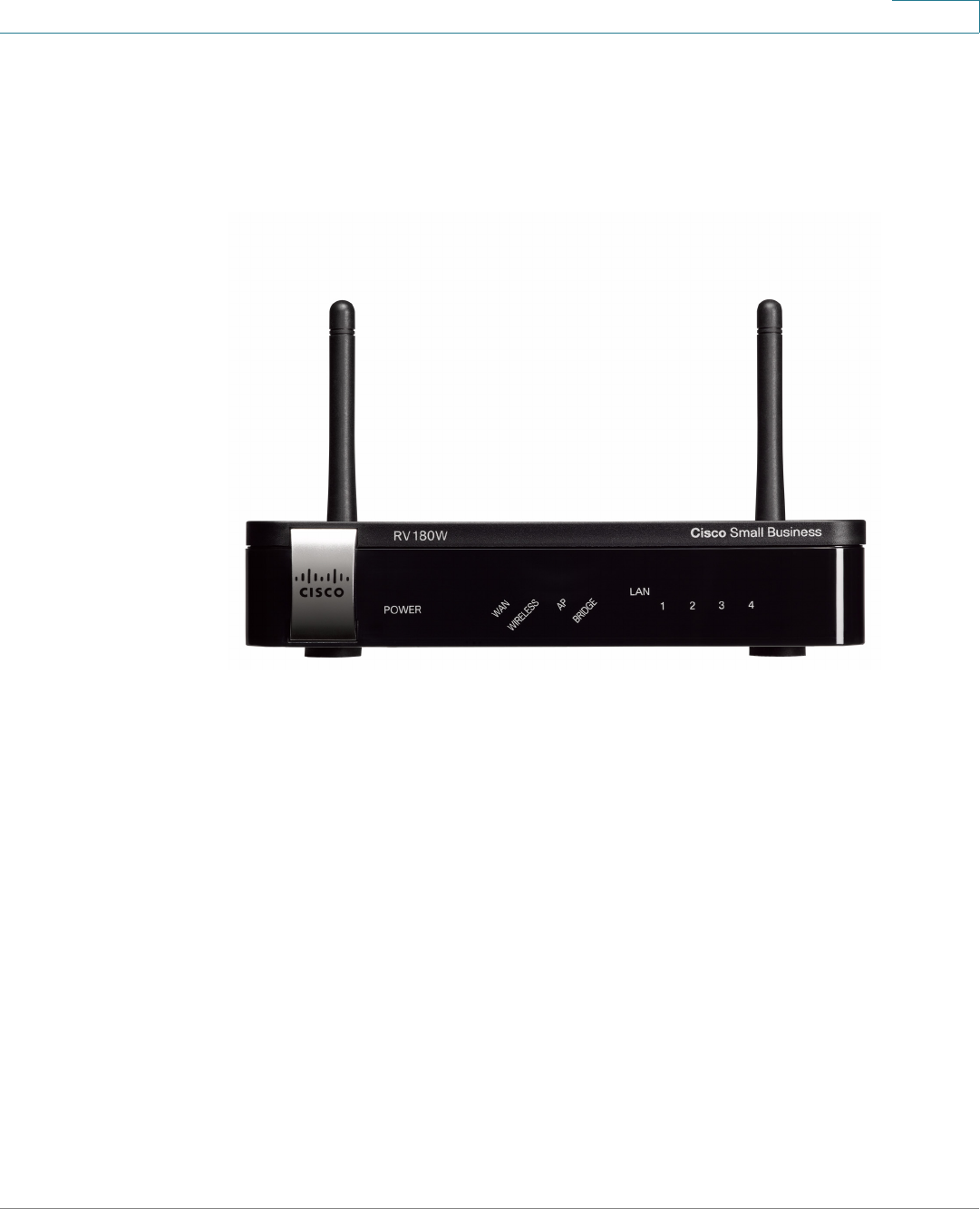
Introduction
Getting to Know the Cisco RV180W
Cisco RV180/RV180W Administration Guide 6
1
DRAFT - CISCO CONFIDENTIAL
Getting to Know the Cisco RV180W
Front Panel
POWER—The Power LED lights up green to indicate the device is powered on.
Flashes green when the power is coming on or software is being upgraded.
WAN LED—The WAN (Internet) LED lights up green when the device is connected
to your cable or DSL modem. The LED flashes green when the device is sending
or receiving data over the WAN port.
WIRELESS—The Wireless LED lights up green when the wireless module is
enabled. The LED is off when the wireless module is disabled. The LED flashes
green when the device is transmitting or receiving data on the wireless module.
AP—The AP LED lights up green when the Cisco RV180W is in access point mode.
BRIDGE—The BRIDGE LED lights up green when the Cisco RV180W is in bridge
mode.
LAN—These four LEDs correspond to the four LAN (Ethernet) ports of the Cisco
RV180/RV180W. If the LED is continuously lit green, the Cisco RV180W is
connected to a device through the corresponding port (1, 2, 3, or 4). The LED for a
port flashes green when the Cisco RV180W is actively sending or receiving data
over that port.
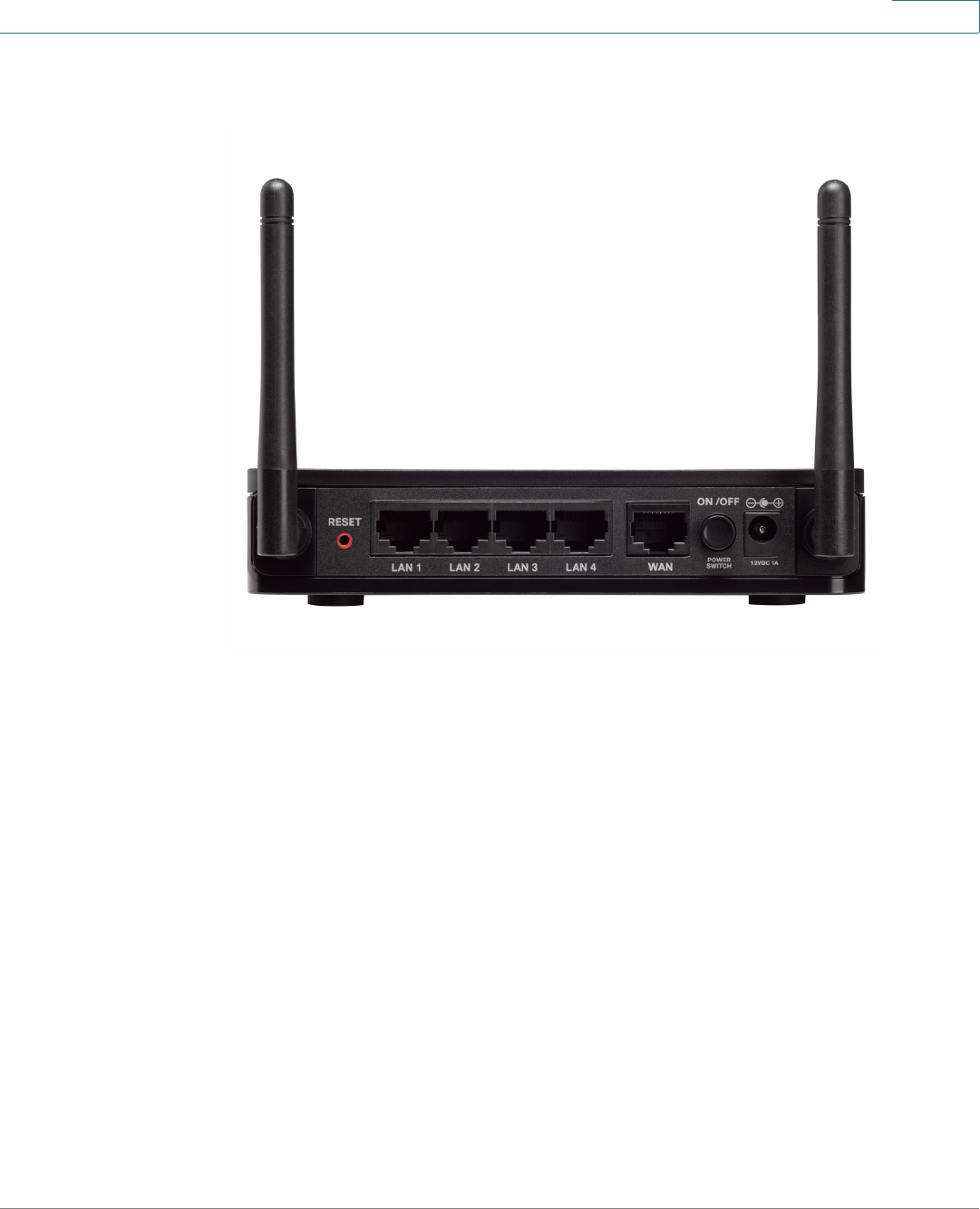
Introduction
Getting to Know the Cisco RV180W
Cisco RV180/RV180W Administration Guide 7
1
DRAFT - CISCO CONFIDENTIAL
Back Panel
RESET Button—The Reset button has two functions:
•If the Cisco RV180W is having problems connecting to the Internet, press
the RESET button for less than five seconds with a paper clip or a pencil tip.
This is similar to pressing the reset button on your PC to reboot it.
•If you are experiencing extreme problems with the Cisco RV180W and have
tried all other troubleshooting measures, press and hold in the RESET
button for 10 seconds. This will restore the factory defaults and clear all of
the Cisco RV180W settings.
LAN Ports (1-4)—These ports provide a LAN connection to network devices,
such as PCs, print servers, or additional switches.
WAN Port—The WAN port is connected to your Internet device, such as a cable or
DSL modem.
ON/OFF Power Switch—Press this button to turn the Cisco RV180W on and off.
When the button is pushed in, power is on.

Introduction
Mounting the Cisco RV180/RV180W
Cisco RV180/RV180W Administration Guide 8
1
DRAFT - CISCO CONFIDENTIAL
Power Port—The power port is where you connect the AC power cable.
Mounting the Cisco RV180/RV180W
You can place your Cisco RV180/RV180W on a desktop or mount it on a wall.
Installation Guidelines
•Ambient Temperature—To prevent the device from overheating, do not
operate it in an area that exceeds an ambient temperature of
104°F (40°C).
•Air Flow—Be sure that there is adequate air flow around the device.
•Mechanical Loading—Be sure that the device is level and stable to avoid
any hazardous conditions.
For desktop placement, place the Cisco RV180/RV180W device horizontally on a
flat surface so that it sits on its four rubber feet.
Wall Mounting
STEP 1 Determine where you want to mount the device and install two screws (not
supplied) that are 2-7/16 in. apart (approximately 61 mm). Mounting screws should
have a head that is approximately 5.5 mm in diameter and 2 mm deep, with a shaft
that is at least15.5 mm long and approximately 3.5 mm wide. (Your wall may
require shorter or longer screws, or drywall anchors.)
Do not mount the screw heads flush with the wall; the screw heads must fit inside
the back of the device.
STEP 2 With the back panel pointing up (if installing vertically), line up the device so that
the wall-mount slots on the bottom of the device line up with the two screws.

Introduction
Connecting the Equipment
Cisco RV180/RV180W Administration Guide 9
1
DRAFT - CISCO CONFIDENTIAL
STEP 3 Place the wall-mount slots over the screws and slide the device down until the
screws fit snugly into the wall-mount slots.
Connecting the Equipment
Before you begin the installation, make sure that you have the following equipment
and services:
Required
•Functional Internet Connection (Broadband DSL or cable modem).
•Ethernet cable for WAN (Internet) connection.
•PC with functional network adapter (Ethernet connection) to run the Setup
Wizard or the Device Manager. The Setup Wizard is supported on Microsoft
Windows 2000, Windows XP, Windows Vista, and Windows 7. The Device
Manager is supported on the following web browsers:
-Microsoft Internet Explorer 6.0 and later
-Mozilla Firefox 3.0 and later
-Apple Safari 3.0 or later.
•Ethernet cable (provided) to connect the firewall to a PC for configuration.
Optional
•Uninterruptible Power Supply (UPS) to provide backup power to essential
devices (strongly recommended).
•Ethernet cables for LAN interfaces, if you want to connect additional
devices to the firewall’s LAN ports.

Introduction
Connecting the Equipment
Cisco RV180/RV180W Administration Guide 10
1
DRAFT - CISCO CONFIDENTIAL
To connect your firewall to the Internet:
STEP 1 Power off all equipment, including the cable or DSL modem, the PC you will use to
connect to the RV180/RV180W, and the RV180/RV180W.
STEP 2 Use an Ethernet cable to connect the WAN port of the Cisco RV180/RV180W to
your cable or DSL modem.

Introduction
Connecting the Equipment
Cisco RV180/RV180W Administration Guide 11
1
DRAFT - CISCO CONFIDENTIAL
STEP 3 Connect one end of a different Ethernet cable to one of the LAN (Ethernet) ports on
the back of the RV180/RV180W. (In this example, the LAN 2 port is used.) Connect
the other end of the cable to an Ethernet port on the PC.
STEP 4 Power on the cable or DSL modem and wait until the connection is active.

Introduction
Connecting the Equipment
Cisco RV180/RV180W Administration Guide 12
1
DRAFT - CISCO CONFIDENTIAL
STEP 5 Connect the power adapter to the Cisco RV180/RV180W power port (12VDC).
!
CAUTION Use only the power adapter that is supplied with the device. Using a different
power adapter could damage the device.
STEP 6 Plug the other end of the adapter into an electrical outlet. You may need to use a
specific plug (supplied) for your country.

Introduction
Setting Up the Cisco RV180/RV180W Using the Setup Wizard
Cisco RV180/RV180W Administration Guide 13
1
DRAFT - CISCO CONFIDENTIAL
STEP 7 On the Cisco RV180/RV180W, push in the ON/OFF power button.
The power light on the front panel is green when the power adapter is connected
properly and the unit is turned on.
Setting Up the Cisco RV180/RV180W Using the Setup Wizard
With the RV180/RV180W powered on and connected to a PC, use the Setup
Wizard to configure the Cisco RV180/RV180W.
To use the Setup Wizard:
STEP 1 Start the PC connected to the RV180/RV180W. Your computer becomes a DHCP
client of the RV180/RV180W and receives an IP address in the 192.168.1.xxx
range.
STEP 2 Launch a web browser and enter 192.168.1.1 in the Address field. This is the
default IP address of the RV180/RV180W.

Introduction
Using the Getting Started Page
Cisco RV180/RV180W Administration Guide 14
1
DRAFT - CISCO CONFIDENTIAL
A message appears about the site’s security certificate. The RV110W uses a self-
signed security certificate and this message appears because the firewall is not
known to your computer.
STEP 3 Click Continue to this website (or the option shown on your particular web
browser) to go to the web site.
The firewall’s default IP address is 192.168.1.1. If there is another device connected
to the network that is acting as a DHCP server, that device may assign a different
address to the RV180/RV180W. If so, use that IP address to connect to the RV180/
RV180W.
STEP 4 When the login page appears, enter the user name and password. The default
user name is cisco. The default password is cisco. Passwords are case sensitive.
To protect your router, change the default user name and password as soon as
possible. See the “Configuring User Accounts” section on page 131.
STEP 5 Click Log In. The Setup Wizard starts.
STEP 6 Follow the Setup Wizard’s on-screen instructions to set up the RV180/RV180W.
The Setup Wizard tries to automatically detect and configure your connection. If it
cannot, the Setup Wizard may ask you for information about your Internet
connection. You may need to contact your ISP to obtain this information.
After the Setup Wizard is done configuring the RV180/RV180W, the Getting
Started page appears. See Using the Getting Started Page, page 14 for more
information.
Using the Getting Started Page
The Getting Started page displays the most common Cisco RV180/RV180W
configuration tasks. Use the links on this page to jump to the relevant configuration
page.
By default, this page appears when you start the Device Manager. However, you
can change this behavior by checking Don’t show this on start up at the bottom
of the page.
Initial Settings
Run Setup Wizard Click this link to launch the Setup Wizard.

Introduction
Using the Getting Started Page
Cisco RV180/RV180W Administration Guide 15
1
DRAFT - CISCO CONFIDENTIAL
Quick Access
Device Status
Configure WAN
(Internet) Settings
Click this link to open the Internet Setup page.
See Configuring the IPv4 WAN (Internet),
page 25.
Configure LAN
(Local Network)
Settings
Click this link to open the LAN Configuration page.
See Configuring IPv4 LAN (Local Network)
Settings, page 32.
Configure Wireless
Settings (RV180W only)
Click this link to open the Basic Settings page.
See Configuring Basic Wireless Settings,
page 61.
Add VPN Clients See Configuring VPN Users, page 115.
Upgrade Device
Firmware
Click this link to open the
Firmware Upgrade page.
See Upgrading Firmware, page 145.
Backup/Restore
Settings
Click this link to open the
Backup and Restore page.
See Backing Up and Restoring the System,
page 143
Configure Site to Site
VPN
Click this link to open the Basic VPN Setup page.
See Configuring a Basic VPN, page 104.
Configure Web Access Click this link to open the Web Access page.
See Configuring Web Access, page 129.
Dashboard Click this link to open the Dashboard page.
See Viewing the Dashboard, page 148.
System Summary Click this link to open the System Summary page.
See Viewing the System Summary, page 151.

Introduction
Navigating through the Pages
Cisco RV180/RV180W Administration Guide 16
1
DRAFT - CISCO CONFIDENTIAL
Other Resources
Navigating through the Pages
Use the navigation tree in the left pane to open the configuration pages.
Wireless Status
(RV180W only)
Click this link to open the Wireless Statistics page.
See Viewing the Wireless Statistics (Cisco
RV180W), page 154.
VPN Status Click this link to open the IPsec Connection Status
page.
See IPsec Connection Status, page 155.
Support Click this link to open Cisco’s support page.
Forums Click this link to visit Cisco’s online support forums.

Introduction
Navigating through the Pages
Cisco RV180/RV180W Administration Guide 17
1
DRAFT - CISCO CONFIDENTIAL
Click a menu item on the left panel to expand it. Click the menu names displayed
underneath to perform an action or view a sub-menu.

Introduction
Saving Your Changes
Cisco RV180/RV180W Administration Guide 18
1
DRAFT - CISCO CONFIDENTIAL
Saving Your Changes
When you finish making changes on a configuration page, click Save to save the
changes, or click Cancel to undo your changes.

Introduction
Viewing the Help Files
Cisco RV180/RV180W Administration Guide 19
1
DRAFT - CISCO CONFIDENTIAL
Viewing the Help Files
To view more information about a configuration page, click the Help link near the
top right corner of the page.
Connecting Devices to Your Wireless Network
To connect a device such as a PC or printer to your wireless network, you must
configure the wireless connection on the device using the security information you
configured for the Cisco RV180/RV180W:
•Network name or Service Set Identifier (SSID). The default SSID is
ciscosb-1.
•If applicable, the encryption type and security key.

Introduction
Configuration Next Steps
Cisco RV180/RV180W Administration Guide 20
1
DRAFT - CISCO CONFIDENTIAL
Configuration Next Steps
Although the Setup Wizard automatically configures the RV180/RV180W, we
recommend that you change some default settings to provide better security and
performance.
In addition, you may need to manually configure some settings. A suggested
outline of steps follows:
•Change the administrator name and password—See “Configuring User
Accounts” on page 131.
•Change the idle timeout value—By default, The Device Manager logs you
out after 10 minutes of inactivity. This can be frustrating if you are trying to
configure your device. See “Setting the Session Timeout Value” on page
132.
•(Optional) If you already have a DHCP server on your network, and you do
not want the Cisco RV80/1RV180W to act as a DHCP server, see
“Configuring the LAN (Local Network) Settings” section on page 32.
•(Cisco RV180W) Configure your wireless network, especially wireless
security. See Chapter 3, “Configuring the Wireless Network (Cisco
RV180W).”
•Configure your Virtual Private Network (VPN) using QuickVPN. The
QuickVPN software is found on the documentation and software CD that
shipped with your firewall. See Appendix A, “Using Cisco QuickVPN for
Windows 7, 2000, XP, or Vista.”

Introduction
Configuration Next Steps
Cisco RV180/RV180W Administration Guide 21
1
DRAFT - CISCO CONFIDENTIAL

Introduction
Configuration Next Steps
Cisco RV180/RV180W Administration Guide 22
1
DRAFT - CISCO CONFIDENTIAL

Introduction
Configuration Next Steps
Cisco RV180/RV180W Administration Guide 23
1
DRAFT - CISCO CONFIDENTIAL
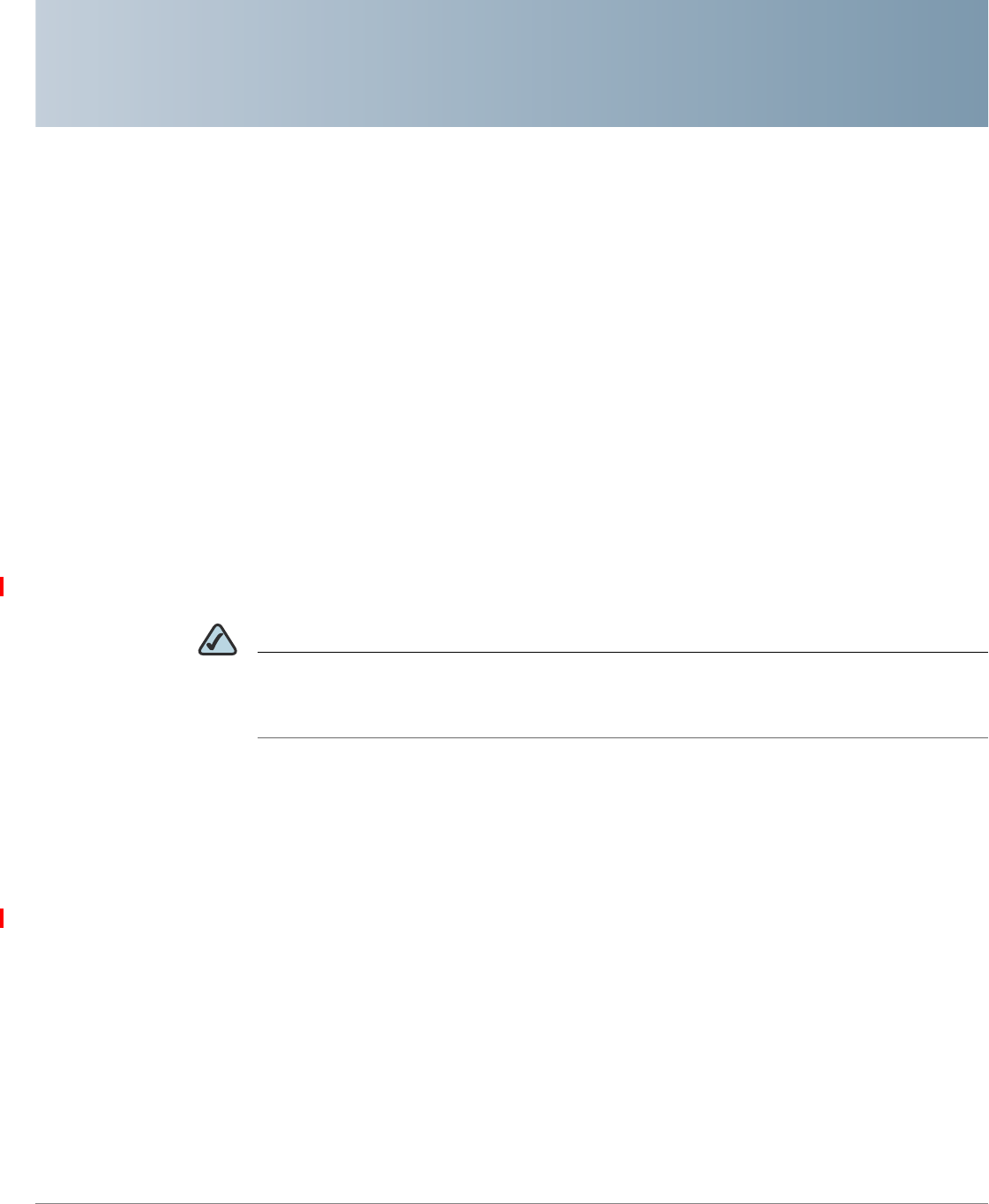
2
Cisco RV180/RV180W Administration Guide 24
DRAFT - CISCO CONFIDENTIAL
Configuring Networking
The networking page allows you to configure networking settings. This chapter
contains the following sections:
•Configuring the WAN (Internet) Settings, page 24
•Configuring the LAN (Local Network) Settings, page 32
•Configuring Routing, page 41
•Configuring Port Management, page 46
•Configuring Dynamic DNS (DDNS), page 47
•Configuring IPv6, page 48
NOTE Cisco recommends you use the Setup Wizard to configure basic networking on the
Cisco RV180/RV180W. You can then make changes and provision advanced
features using the Device Manager.
Configuring the WAN (Internet) Settings
If you have an IPv4 network, use these sections to configure your network. If you
have an IPv6 network, see Configuring IPv6, page 48.

Configuring Networking
Configuring the WAN (Internet) Settings
Cisco RV180/RV180W Administration Guide 25
2
DRAFT - CISCO CONFIDENTIAL
Configuring the IPv4 WAN (Internet)
STEP 1 Choose Networking > WAN (Internet) > IPV4 WAN (Internet).
STEP 2 Choose the type of Internet connection you have. The type of connection you have
determines the rest of the information you need to enter. See the sections below
for more information:
•Configuring Automatic Configuration (DHCP), page 25
•Configuring Static IP, page 26
•Configuring PPPoE, page 26
•Configuring PPTP, page 27
•Configuring L2TP, page 28
Configuring Automatic Configuration (DHCP)
If your Internet Service Provider (ISP) uses the Dynamic Host Configuration
Protocol (DHCP) to assign you an IP address, you receive a dynamic IP address
from your ISP.
To configure DHCP WAN settings:
STEP 1 Choose Networking > WAN (Internet) > IPv4 WAN (Internet).
STEP 2 From the Internet Connection Type drop-down menu, choose
Automatic Configuration - DHCP.
STEP 3 Enter MTU information. (See Configuring MTU Settings, page 29.)
STEP 4 Enter MAC Address information. (See Configuring the MAC Address, page 29.)
STEP 5 Click Save.

Configuring Networking
Configuring the WAN (Internet) Settings
Cisco RV180/RV180W Administration Guide 26
2
DRAFT - CISCO CONFIDENTIAL
Configuring Static IP
If your ISP assigned you a permanent IP address, perform the following steps to
configure your WAN settings:
STEP 1 Choose Networking > WAN (Internet) > IPv4 WAN (Internet).
STEP 2 From the Internet Connection Type drop-down menu, choose Static IP.
STEP 3 Enter this information:
STEP 4 Enter MTU information. (See Configuring MTU Settings, page 29.)
STEP 5 Enter MAC Address information. (See Configuring the MAC Address, page 29.)
STEP 6 Click Save.
Configuring PPPoE
If you have a Point-to-Point Protocol over Ethernet (PPPoE) connection to the
Internet:
STEP 1 Choose Networking > WAN (Internet) > IPv4 WAN (Internet).
STEP 2 From the Internet Connection Type drop-down menu, choose PPPoE.
STEP 3 From the PPPoE Profile Name drop-down menu, choose a PPPoE profile.
If no profile is listed, click Configure Profile to create a new profile.
To see the details of available profiles, choose
Networking > WAN (Internet) > PPPoE Profiles. See Configuring PPPoE
Profiles, page 30 for more information.
IP Address Enter the IP address of the WAN port.
Subnet mask Enter subnet mask of the WAN port.
Default Gateway Enter the IP address of the default gateway.
Primary DNS Server Enter the IP address of the primary DNS server.
Secondary DNS Server (Optional) Enter the IP address of the secondary
DNS server.

Configuring Networking
Configuring the WAN (Internet) Settings
Cisco RV180/RV180W Administration Guide 27
2
DRAFT - CISCO CONFIDENTIAL
STEP 4 Enter MTU information. (See Configuring MTU Settings, page 29.)
STEP 5 Enter MAC Address information. (See Configuring the MAC Address, page 29.)
STEP 6 Click Save.
Configuring PPTP
If you have a Point-to-Point Tunneling Protocol (PPTP) connection to the Internet:
STEP 1 Choose Networking > WAN (Internet) > IPv4 WAN (Internet).
STEP 2 From the Internet Connection Type drop-down menu, choose PPTP.
STEP 3 Enter this information:
STEP 4 Enter MTU information. (See Configuring MTU Settings, page 29.)
User Name Enter your username assigned to you by the ISP.
Password Enter your password assigned to you by the ISP.
MPPE Encryption If your ISP supports Microsoft Point-to-Point
Encryption (MPPE), check to enable MPPE
encryption.
Connection Type Choose the connection type:
•Keep connected—The Internet connection is
always on.
•Idle Time—The Internet connection is on only
when traffic is present. If the connection is
idle—that is, no traffic is occurring—the
connection is closed. You might want to
choose this option if your ISP charges based
on connection time.
Idle Time If you choose Idle Time as the connection type,
enter the number of minutes after which the
connection terminates. The valid range is 5–999.
My IP Address Enter the IP address assigned to you by your ISP.
Server IP Address Enter the IP address of the PPTP server.

Configuring Networking
Configuring the WAN (Internet) Settings
Cisco RV180/RV180W Administration Guide 28
2
DRAFT - CISCO CONFIDENTIAL
STEP 5 Enter MAC Address information. (See Configuring the MAC Address, page 29.)
STEP 6 Click Save.
Configuring L2TP
If you have a Layer 2 Tunneling Protocol (L2TP) connection to the Internet:
STEP 1 Choose Networking > WAN.
STEP 2 From the Internet Connection Type drop-down menu, choose L2TP.
STEP 3 Enter this information:
STEP 4 Enter MTU information. (See Configuring MTU Settings, page 29.)
User Name Enter your username assigned to you by the ISP.
Password Enter your password assigned to you by the ISP.
Secret (Optional) Enter your secret phrase. This phrase is
known to you and your ISP for use in authenticating
your logon.
Connection Type Choose the connection type:
•Keep connected—The Internet connection is
always on.
•Idle Time—The Internet connection is on only
when traffic is present. If the connection is
idle—that is, no traffic is occurring—the
connection is closed. You might want to
choose this option if your ISP charges based
on connection time.
Idle Time If you choose Idle Time as the connection type,
enter the number of minutes after which the
connection terminates. The valid range is 5–999.
My IP Address Enter the IP address assigned to you by your ISP.
Server IP Address Enter the IP address of the L2TP server.

Configuring Networking
Configuring the WAN (Internet) Settings
Cisco RV180/RV180W Administration Guide 29
2
DRAFT - CISCO CONFIDENTIAL
STEP 5 Enter MAC Address information. (See Configuring the MAC Address, page 29.)
STEP 6 Click Save.
Configuring MTU Settings
The Maximum Transmission Unit (MTU) is the size of the largest packet that can be
sent over the network. The default MTU value for Ethernet networks is usually
1500 bytes and for PPPoE connections, it is 1492 bytes.
To configure the MTU settings:
STEP 1 Choose Networking > Choose Networking > WAN (Internet) > IPv4 WAN
(Internet).
STEP 2 Choose the MTU type:
•Default—Unless a change is required by your ISP, we recommend that you
choose Default in the MTU Type field. The default MTU size is 1500 bytes.
•Custom—If your ISP requires a custom MTU setting, choose Custom and
enter the MTU size in the MTU Size field.
STEP 3 Click Save.
Configuring the MAC Address
The Cisco RV180/RV180W has a unique 48-bit local Ethernet hardware address.
In most cases, the default MAC address is used to identify your Cisco RV180/
RV180W to your ISP. However, you can change this setting if required by your ISP.

Configuring Networking
Configuring the WAN (Internet) Settings
Cisco RV180/RV180W Administration Guide 30
2
DRAFT - CISCO CONFIDENTIAL
To configure the MAC address settings:
STEP 1 Choose Networking > WAN (Internet) > IPv4 WAN (Internet).
STEP 2 From the MAC Address Source drop-down menu, choose one of these options:
•Use Default Address—(Recommended) choose this option to use the
default MAC address.
•Use This Computer's Address—Choose this option to assign the MAC
address of your computer.
•Use This MAC—Choose this option if you want to use the MAC address of
the PC on which you are connecting to the Device Manager.
STEP 3 Click Save.
Configuring PPPoE Profiles
If you have a PPPoE connection to the Internet, you can create profiles for multiple
PPPoE accounts. This can be useful if you connect to the Internet using different
service provider accounts.
STEP 1 Choose Networking > WAN (Internet) > PPPoE Profiles.
STEP 2 Click Add to create a new profile.
STEP 3 Enter the following information (you may need to contact your ISP to obtain your
PPPoE login information):
Profile Name Enter the name of the profile.
Username Enter your username assigned to you by the ISP.
Password Enter your password assigned to you by the ISP.

Configuring Networking
Configuring the WAN (Internet) Settings
Cisco RV180/RV180W Administration Guide 31
2
DRAFT - CISCO CONFIDENTIAL
STEP 4 Click Save. The profile is added to the Profile Table.
To edit a PPPoE profile listed in the Profile Table, select the profile and click Edit.
To delete selected profiles, click Delete.
Authentication Type Choose the authentication type from the
drop-down menu:
•Auto-negotiate—The server sends a
configuration request specifying the security
algorithm set on it. Then, the Cisco RV180/
RV180W sends back authentication
credentials with the security type sent earlier
by the server.
•PAP—The Cisco RV180/RV180W uses the
Password Authentication Protocol (PAP) to
connect to the ISP.
•CHAP—The Cisco RV180/RV180W uses the
Challenge Handshake Authentication
Protocol (CHAP) when connecting with the
ISP.
•MS-CHAP or MS-CHAPv2—The Cisco
RV180/RV180W uses Microsoft Challenge
Handshake Authentication Protocol when
connecting with the ISP.
Connection Type Choose the connection type:
•Keep connected—The Internet connection is
always on.
•Idle Time—The Internet connection is on only
when traffic is present. If the connection is
idle—that is, no traffic is occurring—the
connection is closed. You might want to
choose this option if your ISP charges based
on connection time.
Idle Time If you choose Idle Time as the connection type,
enter the number of minutes after which the
connection terminates. The valid range is 5–999.

Configuring Networking
Configuring the LAN (Local Network) Settings
Cisco RV180/RV180W Administration Guide 32
2
DRAFT - CISCO CONFIDENTIAL
Configuring the LAN (Local Network) Settings
If you have an IPv4 network, use these sections to configure your LAN settings. If
you have an IPv6 network, see Configuring IPv6 LAN Properties, page 50.
Configuring IPv4 LAN (Local Network) Settings
If you have an IPv4 LAN, you can configure the following settings:
•Host name—Configuring the Host Name, page 32
•IP Address—Configuring the IP Address, page 32
•DHCP—Configuring DHCP, page 33
•DNS Proxy—Configuring the DNS Proxy, page 35
Configuring the Host Name
To configure the host name of the Cisco RV180/RV180W:
STEP 1 Choose Networking > LAN (Local Network) > IPv4 LAN (Local Network).
STEP 2 In the Host Name field, enter the host name of the Cisco RV180/RV180W. You can
use only alpha-numeric characters and the hyphen.
The default hostname (for example, “router9BA120”) consists of the word “router”
followed by the last 3 bytes of firewall’s LAN MAC address (in Hex-decimal form).
This format allows the FindIT application to use Bonjour to identify Cisco Small
Business devices on the LAN.
STEP 3 Click Save.
Configuring the IP Address
You might want to change the default IP address if that address is assigned to
another piece of equipment in your network.

Configuring Networking
Configuring the LAN (Local Network) Settings
Cisco RV180/RV180W Administration Guide 33
2
DRAFT - CISCO CONFIDENTIAL
To configure the IP address of the Cisco RV180/RV180W:
STEP 1 Choose Networking > LAN (Local Network) > IPv4 LAN (Local Network).
STEP 2 Enter this information:
STEP 3 Click Save.
After changing the Cisco RV180/RV180W’s LAN IP address, your PC is no longer
connected to the Cisco RV180/RV180W.
STEP 4 To reconnect your PC to the Cisco RV180/RV180W:
•If DHCP is configured on the Cisco RV180/RV180W, release and renew your
PC’s IP address.
•If DHCP is not configured on the Cisco RV180/RV180W, manually assign an
IP address to your PC. The address must be on the same subnet as the Cisco
RV180/RV180W. For example, if you change the Cisco RV180/RV180W’s
IP address to 10.0.0.1, assign your PC an IP address in the range of 10.0.0.2
to 10.0.0.254.
STEP 5 Open a new browser window and enter the new IP address of the Cisco RV180/
RV180W to reconnect.
Configuring DHCP
By default, the Cisco RV180/RV180W functions as a DHCP server to the hosts on
the Wireless LAN (WLAN) or LAN network and assigns IP and DNS server
addresses.
IP Address Enter the LAN IP address of the RV180/RV180W.
Make sure the address is not in use by another
device on the same network. The default IP
address is 192.168.1.1.
Subnet mask Choose the subnet mask for the new IP address
from the drop-down menu. The default subnet is
255.255.255.0.

Configuring Networking
Configuring the LAN (Local Network) Settings
Cisco RV180/RV180W Administration Guide 34
2
DRAFT - CISCO CONFIDENTIAL
With DHCP enabled, the firewall's IP address serves as the gateway address to
your LAN. The PCs in the LAN are assigned IP addresses from a pool of
addresses. Each address is tested before it is assigned to avoid duplicate
addresses on the LAN.
For most applications, the default DHCP settings are satisfactory. If you want
another PC on your network to be the DHCP server, or if you are manually
configuring the network settings of all of your PCs, disable DHCP.
To configure the DHCP settings of the Cisco RV180/RV180W:
STEP 1 Choose Networking > LAN (Local Network) > IPv4 LAN (Local Network).
STEP 2 From the DHCP Mode drop-down menu, choose one of these options:
•None—Choose this option if the Cisco RV180/RV180W is not going to act as
a DHCP server.
•DHCP Server—Choose this option to configure the Cisco RV180/RV180W
to be a DHCP server and enter this information:
-Domain Name— (Optional) Enter the domain name for your network.
-Starting IP Address/Ending IP Address—Enter the first and last of the
contiguous addresses in the IP address pool. Any new DHCP client
joining the LAN is assigned an IP address in this range. You can save part
of the range for PCs with fixed addresses. These addresses should be in
the same IP address subnet as the Cisco RV180/RV180W's LAN IP
address.
-Primary DNS Server/Secondary DNS Server—DNS servers map
Internet domain names (for example, www.cisco.com) to IP addresses.
Enter the server IP addresses in these fields if you want to use different
DNS servers than are specified in your WAN settings.
-Lease time—Enter the duration (in hours) for which IP addresses are
leased to clients
•DHCP Relay—Choose this option to configure the Cisco RV180/RV180W to
be a DHCP relay agent and enter the address of the remote DHCP server in
the Remote DHCP Server field. The relay agent transmits DHCP messages
between multiple subnets.
STEP 3 Click Save.

Configuring Networking
Configuring the LAN (Local Network) Settings
Cisco RV180/RV180W Administration Guide 35
2
DRAFT - CISCO CONFIDENTIAL
Configuring the DNS Proxy
You can also enable a DNS proxy. When enabled, the firewall then acts as a proxy
for all DNS requests and communicates with the ISP's DNS servers. When
disabled, all DHCP clients receive the DNS IP addresses of the ISP.
To configure the DNS proxy server for the Cisco RV180/RV180W:
STEP 1 Choose Networking > LAN (Local Network) > IPv4 LAN (Local Network).
STEP 2 In the DNS Proxy field, check to enable the Cisco RV180/RV180W to act as a
proxy for all DNS requests and communicate with the ISP's DNS servers.
STEP 3 Click Save.
Configuring Virtual LAN (VLAN) Membership
A VLAN is a group of endpoints in a network that are associated by function or
other shared characteristics. Unlike LANs, which are usually geographically based,
VLANs can group endpoints without regard to the physical location of the
equipment or users. You can create up to four new VLANS.
Enabling VLANs
STEP 1 Choose Networking > LAN (Local Network) > VLAN Membership.
STEP 2 Check the Enable box.
STEP 3 Click Save.
Underneath the Enable VLAN field, The VLAN Membership Table is shown. This
shows available VLANs, including the VLAN ID, description, ports, and whether
inter-VLAN routing is enabled or not for each configured VLAN.
Creating a VLAN
You can create up to four VLANs on the Cisco RV180/RV180W.
STEP 1 Choose Networking > LAN (Local Network) > VLAN Membership.
STEP 2 In the VLAN Membership Table, click Add Row.

Configuring Networking
Configuring the LAN (Local Network) Settings
Cisco RV180/RV180W Administration Guide 36
2
DRAFT - CISCO CONFIDENTIAL
STEP 3 Enter a numerical VLAN ID that will be assigned to endpoints in the VLAN
membership. The VLAN ID can range from 2 to 4093. VLAN ID 1 is reserved for the
default VLAN, which is used for untagged frames received on the interface, and
VLAN ID 4092 is reserved and cannot be used.
STEP 4 Enter a description for the VLAN.
STEP 5 To enable routing between this and other VLANS, under Inter VLAN Routing, check
the Enable box.
STEP 6 To enable device management, check the Device Management box. This allows
you to access the Device Manager from that VLAN. For example, if you created a
VLAN with the VLAN ID of 2 and enabled device management, you can access the
Device Manager by using the first IP address on the created VLAN (for example,
192.168.2.1).
STEP 7 Under each of the ports for the VLAN, choose one of the following:
•Tagged—Used when connecting to switches carrying multiple VLANs.
•Untagged—Access ports connecting to end devices like printers and
workstations.
STEP 8 Click Save.
Configuring Multiple VLAN Subnets
When you create a VLAN, a subnet is created automatically for the VLAN. You can
then further configure the VLAN properties, such as the IP address and DHCP
behavior.
To e d i t a V L A N :
STEP 1 Choose Networking > LAN > Multiple VLAN Subnets. The list of subnets appears.
STEP 2 Check the box next to the VLAN you want to edit and click Edit.
STEP 3 If you want to edit the IP address of this VLAN:
a. In the IP address field, enter the new IP address.
b. Enter the Subnet Mask for the new IP address.
c. Click Save. If you are connected to the Cisco RV180/RV180W by the LAN port
that is a member of this VLAN, you might have to release and renew the IP

Configuring Networking
Configuring the LAN (Local Network) Settings
Cisco RV180/RV180W Administration Guide 37
2
DRAFT - CISCO CONFIDENTIAL
address on the PC connected to the LAN port, or manually assign an IP
address to your PC that is in the same subnet as the VLAN. Open a new
browser window and re-connect to the Cisco RV180/RV180W.
STEP 4 If you want to edit the DHCP behavior of this VLAN:
In the DHCP Section, in the DHCP Mode field, choose one of the following:
•DHCP Server—Choose this to allow the VLAN to act as the DHCP server in
the network. Enter the following information:
-Domain Name—Enter the domain name for your network (optional).
-Starting and Ending IP Address—Enter the first and last of the contiguous
addresses in the IP address pool. Any new DHCP client joining the LAN is
assigned an IP address in this range. You can save part of the range for
PCs with fixed addresses. These addresses should be in the same IP
address subnet as the VLAN’s IP address.
-Primary and Secondary DNS Server—DNS servers map Internet domain
names (for example, www.cisco.com) to IP addresses. Enter the server IP
addresses in these fields if you want to use different DNS servers than
are specified in your WAN settings.
-Lease time—Enter the duration (in hours) for which IP addresses are
leased to clients.
•Remote DHCP Server—Choose this if you are using a DHCP relay gateway.
The relay gateway transmits DHCP messages between multiple subnets.
Enter the address of the relay gateway in the Remote DHCP Server field.
•None—Use this to disable DHCP on the VLAN.
In the LAN Proxy section, to enable the VLAN to act as a proxy for all DNS requests
and communicate with the ISP's DNS servers, check the Enable box.
STEP 5 Click Save.
Configuring Static DHCP
You can configure a static IP Address and MAC Address for a known computer or
device on the LAN network from the LAN Interface menu.

Configuring Networking
Configuring the LAN (Local Network) Settings
Cisco RV180/RV180W Administration Guide 38
2
DRAFT - CISCO CONFIDENTIAL
STEP 1 Choose Networking > LAN (Local Network) > Static DHCP.
STEP 2 Click Add.
STEP 3 Enter the IP address of the device.
STEP 4 Enter the MAC address of the device. The format for the MAC Address is
XX:XX:XX:XX:XX:XX where X is a number from 0 to 9 (inclusive) or an alphabetical
letter between A and F (inclusive).
NOTE: The IP Address assigned should be outside the pool of the DHCP
addresses configured. The DHCP pool is treated as generic pool and all reserved
IPs should be outside this pool. The DHCP server will then serve the reserved IP
address when the device using the corresponding MAC address requests an IP
address.
STEP 5 Click Save.
Configuring Advanced DHCP Settings
Configuring Automatic Configuration Download
You can configure the Cisco RV180/RV180W to download a configuration file from
a TFTP server. Upon rebooting, the firewall downloads the file.
To configure automatic configuration download:
STEP 1 Choose Networking > LAN (Local Network) > Advanced DHCP Configuration.
STEP 2 Check Enable to enable downloading of configuration files.
STEP 3 Choose the TFTP server type:
•Host Name—Enter the host name of the TFTP server in the TFTP Server
Host Name field.
•Address—Enter the IP address of the TFTP server in the TFTP Server IP
field.
STEP 4 Click Save.

Configuring Networking
Configuring the LAN (Local Network) Settings
Cisco RV180/RV180W Administration Guide 39
2
DRAFT - CISCO CONFIDENTIAL
Adding a DHCP Client to Configuration File Map
This table displays the list of currently configured DHCP Client MAC address to
configuration filename mappings. It has the following fields:
•MAC Address
•Configuration Filename
Click Add to add a new DHCP Client MAC address to configuration filename
mapping. Click Edit to edit the MAC address or boot filename for a particular entry.
Click Delete to delete a particular entry.
Viewing DHCP Leased Clients
You can view a list of endpoints on the network (identified by MAC address) and
see the IP address assigned to them by the DHCP server. The VLAN of the
endpoint is also displayed.
STEP 1 Choose Networking > LAN > DHCP Leased Clients (LAN).
STEP 2 The list of endpoints is displayed; you cannot edit this list.
Configuring RSTP (Cisco RV180W)
To configure Rapid Spanning Tree Protocol (RTSP):
STEP 1 Choose Networking > LAN > RSTP.
STEP 2 Check Enable to enable RSTP.
STEP 3 Configure the following settings:

Configuring Networking
Configuring the LAN (Local Network) Settings
Cisco RV180/RV180W Administration Guide 40
2
DRAFT - CISCO CONFIDENTIAL
STEP 4 In the Port Configuration Table, you can select a port and configure the following:
STEP 5 Click Save.
Configuring Jumbo Frames
A standard Ethernet frame contains 1,500 bytes of data. Enabling the Jumbo
Frames feature allows the switch to send jumbo frames within the LAN containing
up to 9,000 bytes of data per frame. You can configure the Cisco RV180/RV180W
to support jumbo frames. After support is enabled, devices on the LAN side of the
network can exchange traffic that contains jumbo frames. To configure jumbo
frames:
Bridge Priority Enter a bridge priority from 0 to 61440 in
increments of 4096. Valid values are 0, 4096, 8192,
12288, 16384, 20480, 24576, 28672, 32768,
40960, 45056, 49152, 53248, 57344, and 61440.
The lower the system priority, the more likely the
Cisco RV180W is to become the root in the
Spanning Tree. The default is 327688.
Hello Time Enter a number from 1 to 10. The default is 2.
Max Age Enter a number from 6 to 40. The default is 20.
Forward Delay Enter a number from 4 to 30. The default is 15.
Migrate Time Enter a number from 0 to 65535. The default is 3.
Port Priority
Edge Status Check to specify that the associated port is an
edge port (end station). Uncheck to specify that the
associated port is a link (bridge) to another STP
device. Edge port is enabled by default.
Port Cost Enter the RSTP path cost for the designated ports.
Enter a number from 1 to 200000000.

Configuring Networking
Configuring Routing
Cisco RV180/RV180W Administration Guide 41
2
DRAFT - CISCO CONFIDENTIAL
STEP 1 Choose Networking > LAN > Jumbo Frames.
STEP 2 Check the Enable box.
STEP 3 Click Save.
Configuring Routing
Choosing the Routing Mode
The Cisco RV180/RV180W provides two different routing modes. Network
Address Translation (NAT), or gateway routing, is a technique that allows several
endpoints on a LAN to share an Internet connection. The computers on the LAN
use a “private” IP address range while the WAN port on the firewall is configured
with a single “public” IP address. The Cisco RV180/RV180W translates the internal
private addresses into a public address, hiding internal IP addresses from
computers on the Internet. If your ISP has assigned you a single IP address, you
want to use NAT so that the computers that connect through the Cisco RV180/
RV180W are assigned IP addresses from a private subnet (for example,
192.168.10.0).
The other routing mode, “router,” is used if your ISP has assigned you multiple IP
addresses so that you have an IP address for each endpoint on your network. You
must configure either static or dynamic routes if you use this type of routing. See
Configuring Static Routes, page 43, or Configuring Dynamic Routing, page 45.
To choose your routing mode:
STEP 1 Select Networking > Routing > Routing Mode.
STEP 2 Click the box next to the type of routing to configure.
STEP 3 Click Save.
NOTE If you have already configured DMZ or firewall settings on your firewall in gateway
(NAT) mode, selecting “router” changes those settings back to the default.

Configuring Networking
Configuring Routing
Cisco RV180/RV180W Administration Guide 42
2
DRAFT - CISCO CONFIDENTIAL
Viewing Routing Information
To view routing information your network:
STEP 1 Choose Networking > Routing > Routing Table.
STEP 2 Next to the type of network you have, click Display.
Information about your network routing is displayed, including the following:
IPv4 Routing Table
•Destination—Destination host/network IP address for which this route is
added.
•Gateway—The gateway used for this route.
•Genmask—The netmask for the destination network.
•Metric—The distance to the target (usually counted in hops).
•Ref—Number of references to this route.
•Use—Count of lookups for the route. Depending on the use of -F and -C, this
is either route cache misses (-F) or hits (-C).
•Interface—Interface to which packets for this route will be sent.
•Type—Type of routing used (RIP or static).
•Flags—For debugging purpose only; possible flags include:
-UP—Route is up.
-Host—Target is a host.
-Gateway—Use gateway.
-R—Reinstate route for dynamic routing.
-D—Dynamically installed by daemon or redirect.
-M—Modified from routing daemon or redirect.
-A—Installed by
addrconf
.
-C—Cache entry.
-!—Reject route.

Configuring Networking
Configuring Routing
Cisco RV180/RV180W Administration Guide 43
2
DRAFT - CISCO CONFIDENTIAL
IPv6 Routing Table
•Destination—Destination host/network IP address for which this route is
added.
•Next Hop—IP address of an adjacent or intermediate host or router through
which traffic must flow before reaching its ultimate destination.
•Flags—For debugging purpose only; possible flags include:
-UP—Route is up.
-Host—Target is a host.
-Gateway—Use gateway.
-R—Reinstate route for dynamic routing.
-D—Dynamically installed by daemon or redirect.
-M—Modified from routing daemon or redirect.
-A—Installed by
addrconf
.
-C—Cache entry.
-!—Reject route.
•Metric—The distance to the target (usually counted in hops).
•Ref—Number of references to this route.
•Use—Count of lookups for the route. Depending on the use of -F and -C, this
is either route cache misses (-F) or hits (-C).
•Interface—Interface to which packets for this route will be sent.
•Type—Type of routing used (RIP or static).
Configuring Static Routes
You can configure static routes to direct packets to the destination network. A
static route is a pre-determined pathway that a packet must travel to reach a
specific host or network. Some ISPs require static routes to build your routing
table instead of using dynamic routing protocols. Static routes do not require CPU
resources to exchange routing information with a peer router. You can also use
static routes to reach peer routers that do not support dynamic routing protocols.
Static routes can be used together with dynamic routes. Be careful not to
introduce routing loops in your network.

Configuring Networking
Configuring Routing
Cisco RV180/RV180W Administration Guide 44
2
DRAFT - CISCO CONFIDENTIAL
Adding a Static Route
To c r e a t e a s t a t i c r o u t e :
STEP 1 Select Networking > Routing > Static Routes.
STEP 2 In the Static Route Table, click Add.
STEP 3 In the Route Name field, enter the name of the route.
STEP 4 If a route is to be immediately active, check the Active check box. When a route is
added in an inactive state, it will be listed in the routing table, but will not be used
by the firewall. The route can be enabled later. This feature is useful if the network
that the route connects to is not available when you added the route. When the
network becomes available, the route can be enabled.
STEP 5 Check the Private check box to mark this route as private, which means that it will
not be shared in a Routing Information Protocol (RIP) broadcast or multicast.
Uncheck this box if the route can be shared with other firewalls when RIP is
enabled.
STEP 6 In the Destination IP Address field, enter the IP address of the destination host or
network to which the route leads. For a standard Class C IP domain, the network
address is the first three fields of the Destination LAN IP; the last field should be
zero.
STEP 7 In the IP Subnet Mask field, enter the IPv4 Subnet Mask for the destination host or
network. For Class C IP domains, the Subnet Mask is 255.255.255.0.
STEP 8 From the Interface drop-down menu, choose the physical network interface
through which this route is accessible (WAN or LAN).
STEP 9 In the Gateway IP Address field, enter the IP Address of the gateway through
which the destination host or network can be reached. If this firewall is used to
connect your network to the Internet, then your gateway IP is the firewall's IP
address. If you have another router handling your network's Internet connection,
enter the IP address of that router instead.
STEP 10 In the Metric field, enter a value between 2 and 15 to define the priority of the
route. If multiple routes to the same destination exist, the route with the lowest
metric is chosen.
STEP 11 Click Save.
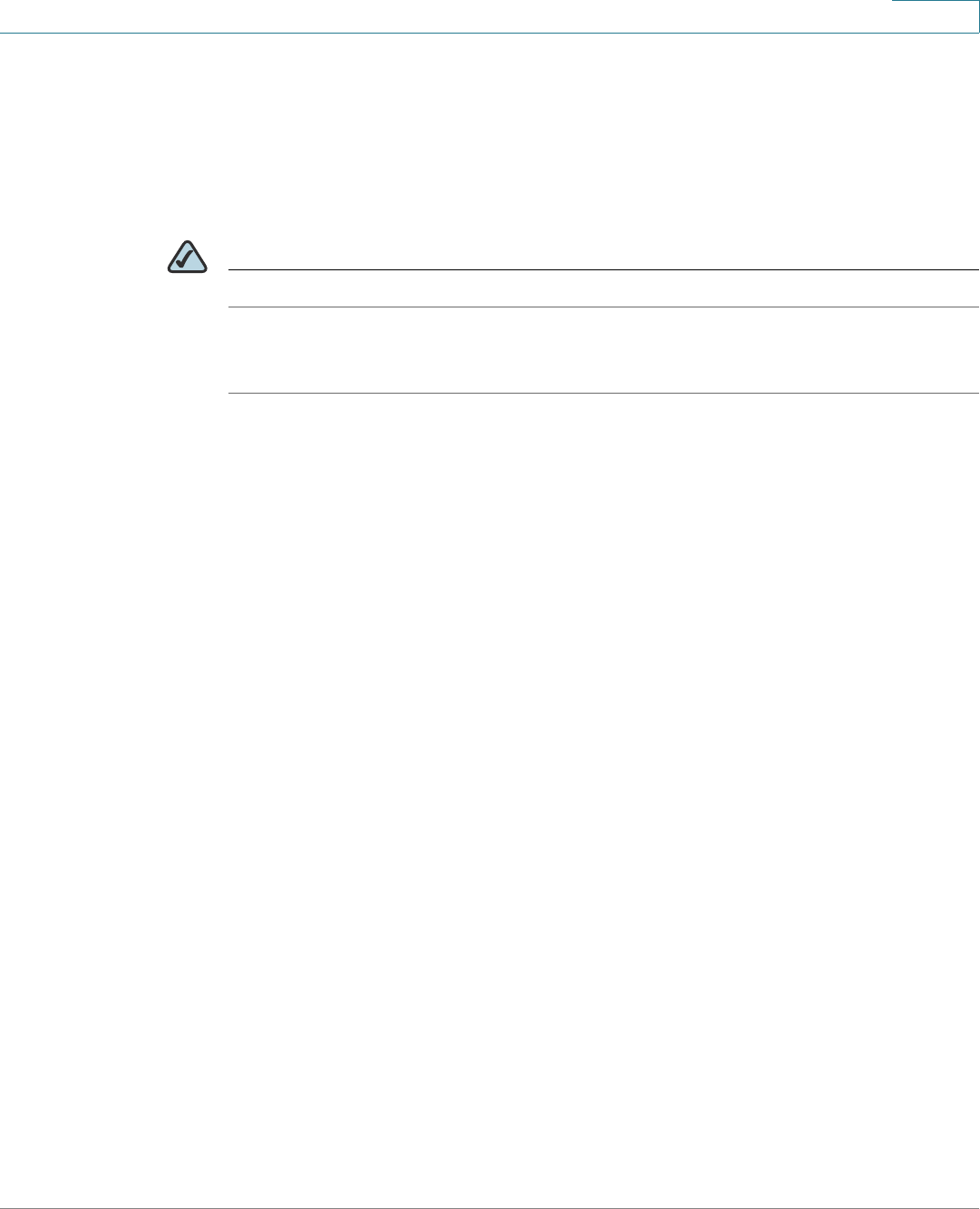
Configuring Networking
Configuring Routing
Cisco RV180/RV180W Administration Guide 45
2
DRAFT - CISCO CONFIDENTIAL
Configuring Dynamic Routing
RIP (Routing Information Protocol, RFC 2453) is an Interior Gateway Protocol (IGP)
that is commonly used in internal networks. It allows the Cisco RV180/RV180W to
exchange its routing information automatically with other routers, and allows it to
dynamically adjust its routing tables and adapt to changes in the network.
NOTE RIP is disabled by default on the Cisco RV180/RV180W.
To configure dynamic routing:
STEP 1 Choose Networking > Routing > Dynamic Routing.
STEP 2 To configure how the firewall sends and receives RIP packets, choose the RIP
direction:
•None—The firewall neither broadcasts its route table nor does it accept any
RIP packets from other routers. This option disables RIP.
•In Only—The firewall accepts RIP information from other router, but does not
broadcast its routing table.
•Out Only—The firewall broadcasts its routing table periodically but does not
accept RIP information from other routers.
•Both—The firewall both broadcasts its routing table and also processes RIP
information received from other routers.
STEP 3 Choose the RIP version:
•Disabled.
•RIP-1—This is a class-based routing version that does not include subnet
information. RIP-1 is the most commonly supported version.
•RIP-2B—This version broadcasts data in the entire subnet.
•RIP-2M—This version sends data to multicast addresses.
STEP 4 RIP v2 authentication forces authentication of RIP packets before routes are
exchanged with other routers. It acts as a security feature because routes are
exchanged only with trusted routers in the network. RIP authentication is disabled
by default. You can enter two key parameters so that routes can be exchanged
with multiple routers present in the network. The second key also acts as a failsafe
when authorization with first key fails. To enable authentication for RIP-2B or RIP-

Configuring Networking
Configuring Port Management
Cisco RV180/RV180W Administration Guide 46
2
DRAFT - CISCO CONFIDENTIAL
2M, check the Enable box. (You must also choose the direction as explained in
Step 2.)
STEP 5 If you enabled RIP v2 authentication, enter the following first and second key
parameters:
•MD5 Key ID—Input the unique MD-5 key ID used to create the Authentication
Data for this RIP v2 message.
•MD5 Auth Key—Input the auth key for this MD5 key, the auth key that is
encrypted and sent along with the RIP-V2 message.
•Not Valid Before—Enter the start date when the auth key is valid for
authentication.
•Not Valid After—Enter the end date when the auth key is valid for
authentication.
STEP 6 Click Save.
Configuring Port Management
The Cisco RV180/RV180W has four LAN ports. You can enable or disable ports,
configure if the port is half- or full-duplex, and set the port speed.
To configure LAN ports:
STEP 1 Choose Networking > Port Management.
STEP 2 In the Port Management Setting Table, to enable a port, check the Enable box. To
disable the port, uncheck the Enable box. By default, all ports are enabled.
STEP 3 Check the Auto Negotiation box to let the firewall and network determine the
optimal port settings. By default, automatic mode is enabled. This setting is
available only when the Enable box is checked.
STEP 4 Check the Flow Control box to enable flow control.
STEP 5 (Optional) Choose either half- or full-duplex based on the port support. The default
is full-duplex for all ports. This setting is available only when the Auto check box is
unchecked.

Configuring Networking
Configuring Dynamic DNS (DDNS)
Cisco RV180/RV180W Administration Guide 47
2
DRAFT - CISCO CONFIDENTIAL
STEP 6 (Optional) Select one of the following port speeds: 10 Mbps, 100 Mbps, or 1000
Mbps. The default setting is 100 Mbps for all ports. This setting is available only
when the Auto Negotiation check box is unchecked. You can change the port
speed if a network is designed to run at a particular speed, such as 10 Mbps
mode. In this case, the endpoint also uses 10 Mbps mode either by auto-
negotiation or manual setting.
STEP 7 Click Save.
Configuring Dynamic DNS (DDNS)
DDNS is an Internet service that allows routers with varying public IP addresses to
be located using Internet domain names. To use DDNS, you must set up an account
with a DDNS provider such as DynDNS.com or TZO.com.
The firewall will notify dynamic DNS servers of changes in the WAN IP address, so
that any public services on your network can be accessed by using the domain
name.
To configure DDNS:
STEP 1 Choose Networking > Dynamic DNS.
STEP 2 Select the Dynamic DNS Service you are using. Selecting None disables this
service.
STEP 3 If you selected DynDNS.com:
a. Specify the complete Host Name and Domain Name for the DDNS service.
b. Enter the DynDNS account username.
c. Enter the password for the DynDNS account.
d. Check the Use Wildcards box to enable the wildcards feature, which allows all
subdomains of your DynDNS Host Name to share the same public IP as the
Host Name. This option can be enabled here if not done on the DynDNS Web
site.
e. In the Update Period field, enter the number of hours before the Cisco RV180/
RV180W updates the host information on DynDNS.com.

Configuring Networking
Configuring IPv6
Cisco RV180/RV180W Administration Guide 48
2
DRAFT - CISCO CONFIDENTIAL
STEP 4 If you selected TZO.com:
a. Specify the complete Host Name and Domain Name for the DDNS service.
b. Enter the user e-mail address for the TZO account.
c. Enter the user key for the TZO account.
d. In the Update Period field, enter the number of hours before the Cisco RV180/
RV180W updates the host information on TZO.com.
STEP 5 Click Save.
Configuring IPv6
If you have an IPv6 network, see the following sections.
Configuring the IP Mode
To configure IPv6 properties on the Cisco RV180/RV180W, set the IP mode to
IPv6:
STEP 1 Choose Networking > IPv6 > IP Mode.
STEP 2 Click the IPv4 and IPv6 Dual-Stack radio button.
STEP 3 Click Save.
NOTE: The router reboots after changing the IP mode.
Configuring IPv6 WAN Settings
Configuring WAN properties for an IPv6 network differs depending on which type
of Internet connection you have. See the sections below for detailed instructions.
The Cisco RV180/RV180W can be configured to be a DHCPv6 client of the ISP for
this WAN or a static IPv6 address provided by the ISP can be assigned.

Configuring Networking
Configuring IPv6
Cisco RV180/RV180W Administration Guide 49
2
DRAFT - CISCO CONFIDENTIAL
Configuring DHCPv6
When the ISP allows you to obtain the WAN IP settings via DHCP, you need to
provide details for the DHCPv6 client configuration.
STEP 1 Choose IPv6 > IPv6 WAN (Internet).
STEP 2 In the WAN (Internet) Address (IPv6) field, choose DHCPv6.
STEP 3 Choose if the DHCPv6 client on the gateway is stateless or stateful. If a stateful
client is selected, the gateway connects to the ISP's DHCPv6 server for a leased
address. For stateless DHCP, it is not necessary to have a DHCPv6 server
available at the ISP. Instead, an ICMPv6 discover message will originate from the
Cisco RV180/RV180W and is used for auto-configuration.
STEP 4 Click Save.
Configuring a Static IP Address
If your ISP assigns you a fixed address to access the Internet, choose this option.
The information needed for configuring a static IP address can be obtained from
your ISP.
STEP 1 Choose IPv6 > IPv6 WAN (Internet).
STEP 2 In the WAN (Internet) Address (IPv6) field, choose Static IPv6.
STEP 3 Enter the IPv6 IP address assigned to your firewall.
STEP 4 Enter the IPv6 prefix length defined by the ISP. The IPv6 network (subnet) is
identified by the initial bits of the address which are called the prefix (for example,
in the IP address 2001:0DB8:AC10:FE01::, 2001 is the prefix). All hosts in the
network have identical initial bits for their IPv6 address; the number of common
initial bits in the network’s addresses is set in this field.
STEP 5 Enter the default IPv6 gateway address, or the IP address of the server at the ISP
that this firewall will connect to for accessing the internet.
STEP 6 Enter the primary and secondary DNS server IP addresses on the ISP's IPv6
network. DNS servers map Internet domain names (for example, www.cisco.com)
to IP addresses.
STEP 7 Click Save.

Configuring Networking
Configuring IPv6
Cisco RV180/RV180W Administration Guide 50
2
DRAFT - CISCO CONFIDENTIAL
Configuring IPv6 LAN Properties
In IPv6 mode, the LAN DHCP server is enabled by default (similar to IPv4 mode).
The DHCPv6 server assigns IPv6 addresses from configured address pools with
the IPv6 Prefix Length assigned to the LAN.
To configure IPv6 LAN properties:
STEP 1 Choose Networking > IPv6 > IPv6 LAN (Local Area Network).
STEP 2 Under LAN TCP/IP Setup, in the IPv6 Address field, enter the IP address of the
Cisco RV180/RV180W. The default IPv6 address for the gateway is fec0::1. You
can change this 128 bit IPv6 address based on your network requirements.
STEP 3 Enter the IPv6 prefix length. The IPv6 network (subnet) is identified by the initial
bits of the address called the prefix. By default, the prefix is 64 bits long. All hosts
in the network have the identical initial bits for their IPv6 address; the number of
common initial bits in the network's addresses is set by the prefix length field.
STEP 4 In the DHCPv6 field, choose to disable or enable the DHCPv6 server. If enabled,
the Cisco RV180/RV180W assigns an IP address within the specified range plus
additional specified information to any LAN endpoint that requests DHCP-served
addresses.
STEP 5 Choose the DHCP mode. If stateless is selected, an external IPv6 DHCP server is
not required as the IPv6 LAN hosts are auto-configured by the Cisco RV180/
RV180W. In this case, the router advertisement daemon (RADVD) must be
configured on this device and ICMPv6 router discovery messages are used by the
host for auto-configuration. There are no managed addresses to serve the LAN
nodes.
If stateful is selected, the IPv6 LAN host will rely on an external DHCPv6 server to
provide required configuration settings.
STEP 6 (Optional) Enter the domain name of the DHCPv6 server.
STEP 7 Enter the server preference. This field is used to indicate the preference level of
this DHCP server. DHCP advertise messages with the highest server preference
value to a LAN host are preferred over other DHCP server advertise messages.
The default is 255.
STEP 8 Choose the DNS proxy behavior:

Configuring Networking
Configuring IPv6
Cisco RV180/RV180W Administration Guide 51
2
DRAFT - CISCO CONFIDENTIAL
•Use DNS Proxy—Check this box to enable DNS proxy on this LAN, or
uncheck this box to disable this proxy. When this feature is enabled, the
firewall acts as a proxy for all DNS requests and communicate with the ISP’s
DNS servers (as configured in the WAN settings page).
•Use DNS from ISP—This option allows the ISP to define the DNS servers
(primary/secondary) for the LAN DHCP client.
•Use below—If selected, the primary/secondary DNS servers configured are
used. If you chose this option, enter the IP address of the primary and
secondary DNS servers.
STEP 9 Enter the lease/rebind time. Enter the duration (in seconds) for which IP addresses
will be leased to endpoints on the LAN.
STEP 10 Click Save.
Configuring IPv6 Address Pools
This feature allows you to define the IPv6 delegation prefix for a range of IP
addresses to be served by the Cisco RV180/RV180W’s DHCPv6 server. Using a
delegation prefix, you can automate the process of informing other networking
equipment on the LAN of DHCP information specific for the assigned prefix.
STEP 1 Choose Networking > IPv6 > IPv6 LAN (Local Area Network).
STEP 2 In the IPv6 Address Pool Table, click Add.
STEP 3 Enter the starting IP address and ending IP address of the pool.
STEP 4 Enter the prefix length. The number of common initial bits in the network’s
addresses is set by the prefix length field.
STEP 5 Click Save.
Configuring IPv6 Routing
Configuring Static Routing
You can configure static routes to direct packets to the destination network. A
static route is a pre-determined pathway that a packet must travel to reach a
specific host or network. Some ISPs require static routes to build your routing
table instead of using dynamic routing protocols. Static routes do not require CPU

Configuring Networking
Configuring IPv6
Cisco RV180/RV180W Administration Guide 52
2
DRAFT - CISCO CONFIDENTIAL
resources to exchange routing information with a peer router. You can also use
static routes to reach peer routers that do not support dynamic routing protocols.
Static routes can be used together with dynamic routes. Be careful not to
introduce routing loops in your network.
Adding a Static Route
To c r e a t e a s t a t i c r o u t e :
STEP 1 Select Networking > IPv6 > Routing.
STEP 2 In the list of static routes, click Add.
STEP 3 Enter the route name.
STEP 4 If a route is to be immediately active, check the Active box. When a route is added
in an inactive state, it will be listed in the routing table, but will not be used by the
firewall. The route can be enabled later. This feature is useful if the network that the
route connects to is not available when you added the route. When the network
becomes available, the route can be enabled.
STEP 5 In the IPv6 Destination field, enter the IPv6 address of the destination host or
network for this route.
STEP 6 In the IPv6 Prefix Length field, enter the number of prefix bits in the IPv6 address
that define the destination subnet.
STEP 7 Choose the physical network interface through which this route is accessible:
•WAN (Internet)—The route goes through the WAN interface.
•6 to 4 Tunnel—Uses the tunnel interface to route traffic from an IPv6 network
to other IPv6 networks over an IPv4 network.
•LAN (Local Network)—The route goes through the LAN interface.
STEP 8 Enter the IP Address of the gateway through which the destination host or network
can be reached.
STEP 9 In the metric field, specify the priority of the route by choosing a value between 2
and 15. If multiple routes to the same destination exist, the route with the lowest
metric is used.
STEP 10 Click Save.
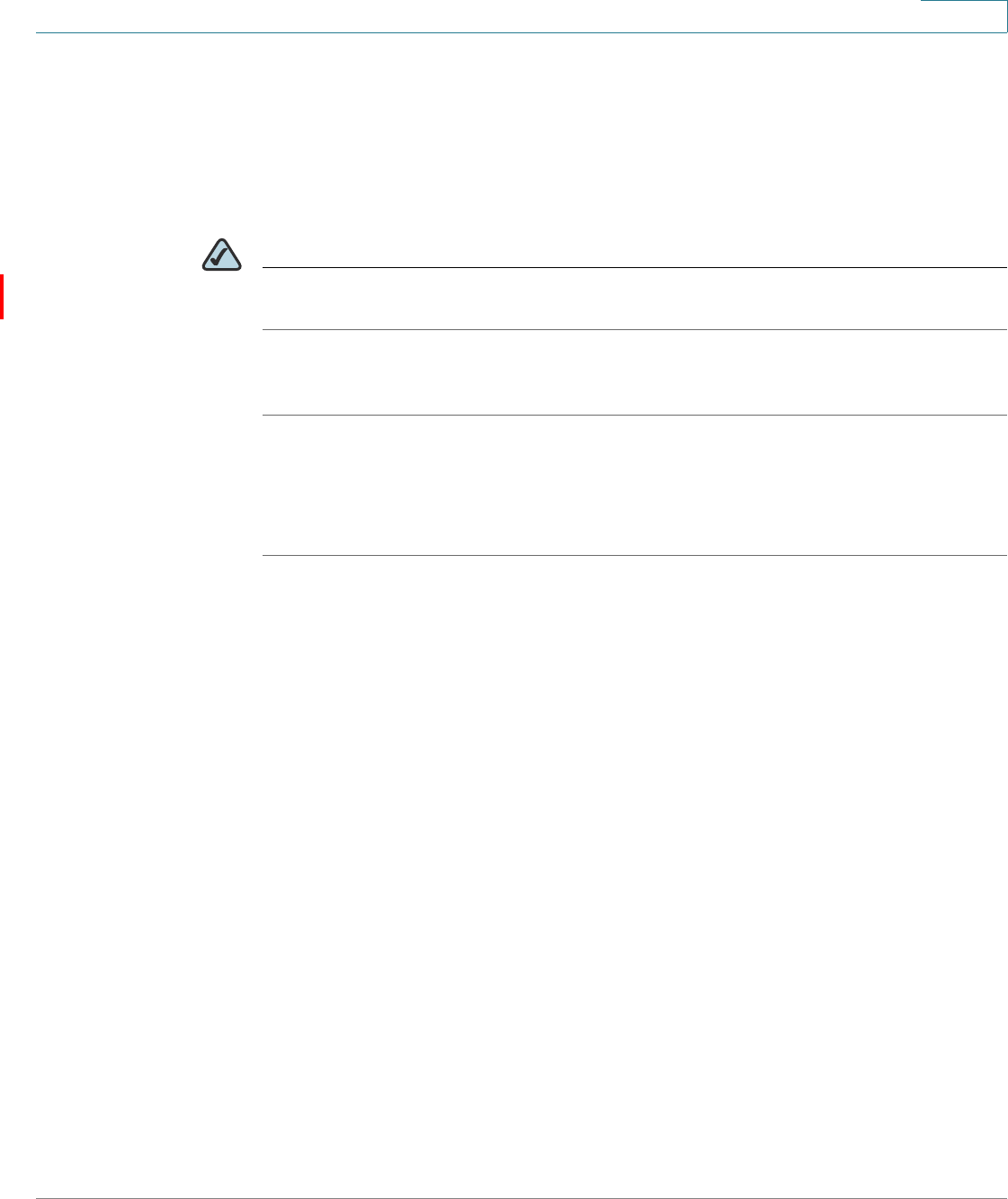
Configuring Networking
Configuring IPv6
Cisco RV180/RV180W Administration Guide 53
2
DRAFT - CISCO CONFIDENTIAL
Configuring Tunneling
The Cisco RV180/RV180W provides several IPv6 tunneling methods. 6to4
tunneling allows IPv6 packets to be transmitted over an IPv4 network. 6to4
tunneling is typically used when a site or end user wants to connect to the IPv6
Internet using the existing IPv4 network.
NOTE You must use static routes when tunneling. See Configuring Static Routing,
page 51.
To configure 6to4 Tunneling:
STEP 1 Select Networking > IPv6 > Tunneling.
STEP 2 Check the Automatic Tunneling box.
STEP 3 Click Save.
Configuring Remote Endpoints
Viewing IPv6 Tunnel Information
To view IPv6 tunnel information, choose Networking > IPv6 > Tunneling. Click
Refresh to get the latest information.
The IPv6 Tunnel Status table shows the name of tunnel and the IPv6 address that
is created on the device.
Configuring Intra-Site Automatic Tunnel Addressing Protocol (ISATAP) Tunnels
Intra-site automatic tunnel addressing protocol (ISATAP) is a method to transmit
IPv6 packets between dual-stack nodes over an IPv4 network. The Cisco RV180/
RV180W is one endpoint (a node) for the tunnel. You must also set a local endpoint,
as well as the ISATAP Subnet Prefix that defines the logical ISATAP subnet to
configure a tunnel.
Adding an ISATAP Tunnel
To add an ISATAP tunnel:

Configuring Networking
Configuring IPv6
Cisco RV180/RV180W Administration Guide 54
2
DRAFT - CISCO CONFIDENTIAL
STEP 1 Choose Networking > IPv6 > Tu nn e l i n g .
STEP 2 In the ISATAP Tunnel Table, click Add.
STEP 3 Enter the tunnel name.
STEP 4 Choose the local endpoint address, or the endpoint address for the tunnel that
starts with the Cisco RV180/RV180W. The endpoint can be the LAN interface (if
the LAN is configured as an IPv4 network), or another LAN IPv4 address.
STEP 5 If you chose Other IP in Step 4, enter the IPv4 address of the endpoint.
STEP 6 Enter the ISATAP subnet prefix. This is the 64-bit subnet prefix that is assigned to
the logical ISATAP subnet for this intranet. This can be obtained from your ISP or
internet registry, or derived from RFC 4193.
STEP 7 Click Save.
To modify the settings of an ISATAP tunnel:
STEP 1 Choose Networking > IPv6 > Tu nn e l i n g .
STEP 2 Check the check boxes for the tunnels you want to modify.
STEP 3 Click Edit, make the changes, and click Save.
To delete an ISATAP tunnel:
STEP 1 Choose Networking > IPv6 > Tu nn e l i n g .
STEP 2 Check the check boxes for the tunnels you want to delete.
STEP 3 Click Delete.
Configuring Router Advertisement
The Router Advertisement Daemon (RADVD) on the Cisco RV180/RV180W listens
for router solicitations in the IPv6 LAN and responds with router advertisements as
required. This is stateless IPv6 auto configuration, and the Cisco RV180/RV180W
distributes IPv6 prefixes to all nodes on the network.

Configuring Networking
Configuring IPv6
Cisco RV180/RV180W Administration Guide 55
2
DRAFT - CISCO CONFIDENTIAL
To configure the RADVD:
STEP 1 Choose Networking > IPv6 > Router Advertisement.
STEP 2 Under Router Advertisement Status, choose Enable.
STEP 3 Under Advertise Mode, choose one of the following:
•Unsolicited Multicast—Select this option to send router advertisements
(RAs) to all interfaces belonging to the multicast group.
•Unicast only—Select this option to restrict advertisements to well-known
IPv6 addresses only (router advertisements [RAs] are sent to the interface
belonging to the known address only).
STEP 4 If you chose Unsolicited Multicast in Step 3, enter the advertise interval. The
advertise interval is a random value between the Minimum Router Advertisement
Interval and Maximum Router Advertisement Interval. (MinRtrAdvInterval = 0.33 *
MaxRtrAdvInterval.) The default is 30 seconds.
STEP 5 Under RA Flags, check Managed to use the administered/stateful protocol for
address auto configuration. Check Other to use the administered/stateful protocol
of other, non-address information auto configuration.
STEP 6 Under router preference, choose Low, Medium, or High. The router preference
provides a preference metric for default routers. The low, medium and high values
are signaled in unused bits in Router Advertisement messages. This extension is
backward compatible, both for routers (setting the router preference value) and
hosts (interpreting the router preference value). These values are ignored by hosts
that do not implement router preference. This feature is useful if there are other
RADVD-enabled devices on the LAN. The default is high.
STEP 7 Enter the MTU size. The MTU is the size of the largest packet that can be sent over
the network. The MTU is used in RAs to ensure all nodes on the network use the
same MTU value when the LAN MTU is not well-known. The default is 1500 bytes.
STEP 8 Enter the router lifetime value, or the time in seconds that the advertisement
messages will exist on the route. The default is 3600 seconds.
STEP 9 Click Save.
Configuring Router Advertisement Prefixes
To configure the RADVD available prefixes:

Configuring Networking
Configuring IPv6
Cisco RV180/RV180W Administration Guide 56
2
DRAFT - CISCO CONFIDENTIAL
STEP 1 Choose Networking > IPv6 > Advertisement Prefixes.
STEP 2 Click Add.
STEP 3 Choose the IPv6 Prefix Type:
•6to4—6to4 is a system that allows IPv6 packets to be transmitted over an
IPv4 network. It is used when an end user wants to connect to the IPv6
Internet using their existing IPv4 connection
•Global/Local/ISATAP—By using ISATAP, you can integrate IPv6 traffic into a
IPv4 network environment. ISATAP uses a locally assigned IPv4 address to
create a 64-bit interface identifier for IPv6.
STEP 4 If you chose 6to4 in Step 3, enter the Site-level aggregation identifier (SLA ID.) The
SLA ID in the 6to4 address prefix is set to the interface ID of the interface on which
the advertisements are sent.
STEP 5 If you chose Global/Local/ISATAP in Step 3, enter the IPv6 prefix and prefix length.
The IPv6 prefix specifies the IPv6 network address. The prefix length variable is a
decimal value that indicates the number of contiguous, higher-order bits of the
address that make up the network portion of the address.
STEP 6 Enter the prefix lifetime, or the length of time during which the requesting router is
allowed to use the prefix.
STEP 7 Click Save.

Configuring Networking
Configuring IPv6
Cisco RV180/RV180W Administration Guide 57
2
DRAFT - CISCO CONFIDENTIAL

3
Cisco RV180/RV180W Administration Guide 58
DRAFT - CISCO CONFIDENTIAL
Configuring the Wireless Network
(Cisco RV180W)
This chapter describes how to configure your wireless network and includes the
following sections:
•A Note About Wireless Security, page 58
•Understanding the Cisco RV180W’s Wireless Networks, page 61
•Configuring Basic Wireless Settings, page 61
•Configuring Advanced Wireless Settings, page 68
•Configuring Wi-Fi Protected Setup, page 70
•Configuring a Wireless Distribution System (WDS), page 71
NOTE This chapter only applies to the Cisco RV180W model.
A Note About Wireless Security
Wireless networks are convenient and easy to install, so small businesses with
high-speed Internet access are adopting them at a rapid pace. Because wireless
networking operates by sending information over radio waves, it can be more
vulnerable to intruders than a traditional wired network. Like signals from your
cellular or cordless phones, signals from your wireless network can also be
intercepted. The following information will help you to improve your security:
•Wireless Security Tips, page 59
•General Network Security Guidelines, page 60

Configuring the Wireless Network (Cisco RV180W)
A Note About Wireless Security
Cisco RV180/RV180W Administration Guide 59
3
DRAFT - CISCO CONFIDENTIAL
Wireless Security Tips
Since you cannot physically prevent someone from connecting to your wireless
network, you need to take some additional steps to keep your network secure:
•Change the default wireless network name or SSID
Wireless devices have a default wireless network name or Service Set
Identifier (SSID) set by the factory. This is the name of your wireless
network, and can be up to 32 characters in length.
You should change the wireless network name to something unique to
distinguish your wireless network from other wireless networks that may
exist around you, but do not use personal information (such as your Social
Security number) because this information may be available for anyone to
see when browsing for wireless networks.
•Change the default password
For wireless products such as access points, routers, and gateways, you
will be asked for a password when you want to change their settings. These
devices have a default password set by the factory. The default password
is often admin. Hackers know these defaults and may try to use them to
access your wireless device and change your network settings. To thwart
any unauthorized changes, customize the device’s password so it will be
hard to guess.
•Enable MAC address filtering
Cisco routers and gateways give you the ability to enable Media Access
Control (MAC) address filtering. The MAC address is a unique series of
numbers and letters assigned to every networking device. With MAC
address filtering enabled, wireless network access is provided solely for
wireless devices with specific MAC addresses. For example, you can
specify the MAC address of each computer in your network so that only
those computers can access your wireless network.

Configuring the Wireless Network (Cisco RV180W)
A Note About Wireless Security
Cisco RV180/RV180W Administration Guide 60
3
DRAFT - CISCO CONFIDENTIAL
•Enable encryption
Encryption protects data transmitted over a wireless network. Wi-Fi
Protected Access (WPA/WPA2) and Wired Equivalency Privacy (WEP) offer
different levels of security for wireless communication. Currently, devices
that are Wi-Fi certified are required to support WPA2, but are not required
to support WEP.
A network encrypted with WPA/WPA2 is more secure than a network
encrypted with WEP, because WPA/WPA2 uses dynamic key encryption.
To protect the information as it passes over the airwaves, you should enable
the highest level of encryption supported by your network equipment.
WEP is an older encryption standard and may be the only option available
on some older devices that do not support WPA.
•Keep wireless routers, access points, or gateways away from exterior walls
and windows.
•Turn wireless routers, access points, or gateways off when they are not
being used (at night, during vacations).
•Use strong passphrases that are at least eight characters in length.
Combine letters and numbers to avoid using standard words that can be
found in the dictionary.
General Network Security Guidelines
Wireless network security is useless if the underlying network is not secure. Cisco
recommends that you take the following precautions:
•Password protect all computers on the network and individually password
protect sensitive files.
•Change passwords on a regular basis.
•Install anti-virus software and personal firewall software.
•Disable file sharing (peer-to-peer). Some applications may open file sharing
without your consent and/or knowledge.

Configuring the Wireless Network (Cisco RV180W)
Understanding the Cisco RV180W’s Wireless Networks
Cisco RV180/RV180W Administration Guide 61
3
DRAFT - CISCO CONFIDENTIAL
Understanding the Cisco RV180W’s Wireless Networks
The Cisco Small Business RV 120W Wireless-N VPN Firewall provides four
separate virtual wireless networks. These networks can be configured and
enabled with individual settings. You can set up the multiple networks to segment
the network traffic, to allow different levels of access, such as guest access, or to
allow access for different functions such as accounting, billing, and so on.
Configuring Basic Wireless Settings
The following sections contain information on how to configure basic wireless
settings on the Cisco RV180/RV180W. These settings apply to all of the wireless
networks.
Configuring Radio, Mode, and Channel Settings
STEP 1 Choose Wireless > Basic Settings.
STEP 2 In the Radio field, choose Enable to enable wireless functionality for the
Cisco RV180/RV180W. Choosing Disable turns off wireless functionality for the
firewall.
STEP 3 In the Wireless Network Mode field, choose the type of wireless network based
on the devices you have that will connect to the network:
•B/G Mixed—Select this mode if you have devices in the network that
support 802.11b and 802.11g.
•G Only—Select this mode if all devices in the wireless network only support
802.11g.
•B/G/N Mixed—Select this mode if you have devices in the network that
support 802.11b, 802.11g and 802.11n.
•N Only—Select this mode only if all devices in the wireless network support
802.11n.
•G/N Mixed—Select this mode if you have devices in the network that
support 802.11g and 802.11n.
STEP 4 Select the channel bandwidth. Available choices depend on the wireless network
mode chosen in Step 3.

Configuring the Wireless Network (Cisco RV180W)
Configuring Basic Wireless Settings
Cisco RV180/RV180W Administration Guide 62
3
DRAFT - CISCO CONFIDENTIAL
STEP 5 The Control Side Band field defines the sideband which is used for the secondary
or extension channel when the AP is operating in 40 Mhz channel width. Choose
lower or upper. This field is only available when channel spacing is set to auto. The
signal components above the carrier frequency constitute the upper sideband
(USB) and those below the carrier frequency constitute the lower sideband (LSB).
STEP 6 The Wireless Channel field specifies the frequency that the radio uses to transmit
wireless frames. Select a channel from the list of channels or choose auto to let the
Cisco RV180W determine the best channel to use based on the environment noise
levels for the available channels.
STEP 7 In the U-APSD field, choose Enable to enable the Unscheduled Automatic Power
Save Delivery (also referred to as WMM Power Save) feature that allows the radio
to conserve power. This feature is disabled by default.
STEP 8 Click Save.
Configuring Wireless Security and Other Settings
At a minimum, you should edit the default profiles to enable wireless security. See
A Note About Wireless Security, page 58.
You can configure wireless security and other settings for each wireless network.
To configure wireless settings:
STEP 1 Choose Wireless > Basic Settings.
STEP 2 In the Wireless Basic Settings Table, check the box on the left of the wireless
network you want to configure.
STEP 3 Click Edit to configure these network properties:
a. Enter the SSID name, or the unique name for this wireless network. Include up
to 32 characters, using any of the characters on the keyboard. For added
security, you should change the default value to a unique name.
b. Check the Broadcast SSID box if you want to allow all wireless clients within
range to be able to detect this wireless network when they are scanning the
local area for available networks. Disable this feature if you do not want to make
the SSID known. When this feature is disabled, wireless users can connect to
your wireless network only if they know the SSID (and provide the required
security credentials).
c. Enter the VLAN, or network for this wireless network. (See Chapter 2,
Configuring Networking, for more information on VLANs.) Devices connecting

Configuring the Wireless Network (Cisco RV180W)
Configuring Basic Wireless Settings
Cisco RV180/RV180W Administration Guide 63
3
DRAFT - CISCO CONFIDENTIAL
to this network are assigned addresses on this VLAN. The default VLAN is 1
and if all the devices are on the same network, this can be left unchanged.
d. (Optional) Check the Wireless Isolation within SSID box to separate this
network from the other three networks on the Cisco RV180/RV180W. When
this feature is enabled, the network can communicate with the Cisco RV180/
RV180W, but not with any of the other networks.
e. In the Max Associated Clients field, enter the maximum number of endpoints
that can connect to this network. The default value is 8. You can change this
number if you want to restrict traffic on the network to prevent it from being
overloaded, for example. The number of clients connected across all four
virtual access points cannot exceed 100.
f. Click Save.
Configuring Security
STEP 1 Choose Wireless > Basic Settings.
STEP 2 In the Wireless Basic Settings Table, check the box on the left of the wireless
network you want to configure.
STEP 3 Click Edit Security Mode to configure security.
STEP 4 Select the SSID to configure.
STEP 5 Click Enable under Wireless Isolation within SSID to separate this network from
the other three wireless networks on the Cisco RV180/RV180W. When this feature
is enabled, the network can communicate with the Cisco RV180/RV180W, but not
with any of the other three networks.
STEP 6 In the Security field, select the type of security. All devices on this network must
use the same security mode and settings to work correctly. Cisco recommends
using the highest level of security that is supported by the devices in your
network.
•Disabled—Any device can connect to the network. Not recommended.
•Wired Equivalent Privacy (WEP)— Weak security with a basic encryption
method that is not as secure as WPA. WEP may be required if your network
devices do not support WPA; however, it is not recommended.

Configuring the Wireless Network (Cisco RV180W)
Configuring Basic Wireless Settings
Cisco RV180/RV180W Administration Guide 64
3
DRAFT - CISCO CONFIDENTIAL
•Wi-Fi Protected Access (WPA) Personal—WPA is part of the wireless
security standard (802.11i) standardized by the Wi-Fi Alliance and was
intended as an intermediate measure to take the place of WEP while the
802.11i standard was being prepared. It supports TKIP/AES encryption. The
personal authentication is the preshared key (PSK) that is an alphanumeric
passphrase shared with the wireless peer.
•WPA Enterprise—Allows you to use WPA with RADIUS server
authentication.
•WPA2 Personal—WPA2 is the implementation of security standard
specified in the final 802.11i standard. It supports AES encryption and this
option uses preshared key (PSK) based authentication.
•WPA2 Personal Mixed—Allows both WPA and WPA2 clients to connect
simultaneously using PSK authentication.
•WPA2 Enterprise—Allows you to use WPA2 with RADIUS server
authentication.
•WPA2 Enterprise Mixed—Allows both WPA and WPA2 clients to connect
simultaneously using RADIUS authentication.
STEP 7 The Encryption Type appears based on the type of network you chose in Step 3:
•WPA Personal, WPA Enterprise, WPA2 Personal Mixed, WPA2 Enterprise
Mixed—TKIP+AES
•WPA2 Personal, WPA2 Enterprise—AES
STEP 8 If you chose WEP:
a. In the Authentication field, choose Open System or Shared Key. If you choose
Open System, a wireless client doesn't need to provide a shared key in order to
access the wireless network. Any client can associate to the router. If you
choose Shared Key, a wireless client must provide the correct shared key
(password) in order to access the wireless network.
b. Select the Encryption Type (64- or 128-bit WEP). The larger size keys provide
stronger encryption, making the key more difficult to crack (for example, 64-bit
WEP has a 40-bit key which is less secure than the 128-bit WEP, which has a
104-bit key).
c. (Optional) In the WEP Passphrase field, enter an alphanumeric phrase (longer
than eight characters for optimal security) and click Generate Key to generate
four unique WEP keys in the WEP Key fields below.

Configuring the Wireless Network (Cisco RV180W)
Configuring Basic Wireless Settings
Cisco RV180/RV180W Administration Guide 65
3
DRAFT - CISCO CONFIDENTIAL
d. Select one of the four keys to use as the shared key that devices must have in
order to use the wireless network. If you did not generate a key in Step 7c,
enter a key directly into the WEP Key field. The length of the key should be 5
ASCII characters (or 10 hexadecimal characters) for 64-bit WEP and 13 ASCII
characters (or 26 hexadecimal characters) for 128-bit WEP. Valid hexadecimal
characters are “0” to “9” and “A” to “F”.
STEP 9 If you chose WPA Personal, WPA2 Personal, or WPA2 Personal Mixed:
a. Enter the WPA Key, or password/phrase that will secure the network. Devices
connecting to the network must use this phrase for authentication.
b. If you want to see the password as you are entering it, check the Unmask
Password box.
c. In the Key Renewal field, enter the number of seconds after which the Cisco
RV180/RV180W will generate a new key. These keys are internal keys
exchanged between the Cisco RV180/RV180W and connected devices. The
default value (3600 seconds) is usually adequate unless you are experiencing
network problems.
STEP 10 If you chose WPA Enterprise or WPA2 Enterprise Mixed, no further configuration is
required.
STEP 11 If you chose WPA2 Enterprise, you can check the Pre-Authentication box
(optional). Pre-authentication allows wireless clients to quickly switch between
connected wireless networks sharing the same security configuration. When a
wireless client disconnects from a wireless network, a notification is sent to the
network, which then sends the pre-authentication info to other wireless networks.
STEP 12 Click Save.
Configuring MAC Filtering
You can use MAC filtering to permit or deny access to the wireless network based
on the MAC (hardware) address of the requesting device. For example, you can
enter the MAC addresses of a set of PCs and only allow those PCs to access the
network. MAC filtering is configured for each wireless network.
STEP 1 Choose Wireless > Basic Settings.
STEP 2 In the Wireless Basic Settings Table, check the box on the left of the wireless
network you want to configure.
STEP 3 Click Edit MAC Filtering.

Configuring the Wireless Network (Cisco RV180W)
Configuring Basic Wireless Settings
Cisco RV180/RV180W Administration Guide 66
3
DRAFT - CISCO CONFIDENTIAL
STEP 4 Choose Enable.
STEP 5 Under Connection Control, choose one of the following:
•Block following MAC addresses from connecting to wireless network—
Blocks MAC addresses specified below from connecting to the wireless
network.
•Allow only following MAC addresses to connect to wireless network—
Allows only the MAC addresses specified below to connect to the wireless
network.
STEP 6 Enter the MAC addresses of the endpoints to allow or deny. To see a list of
currently-connected clients, click Wireless Clients List.
STEP 7 Click Save.
Configuring Wi-Fi Multimedia
Wi-Fi Multimedia (WMM) is used to prioritize different types of traffic. You can
configure QoS settings to provide different priority to different applications, users,
or data flows, or to guarantee a certain level of performance to a data flow.
To configure WMM:
STEP 1 Choose Wireless > Basic Settings.
STEP 2 In the Wireless Basic Settings Table, check the box on the left of the wireless
network you want to configure.
STEP 3 Click Edit WMM.
STEP 4 In the SSID field, select SSID that clients use to connect to the AP.
STEP 5 Check the WMM Enable box to enable WMM based on the IEEE 802.11e standard
for this profile. WMM helps in prioritizing wireless traffic according to four access
categories:
•Voice (highest priority, 4)
•Video (high priority, 3)
•Best effort (medium priority, 2)
•Background (lowest priority, 1)

Configuring the Wireless Network (Cisco RV180W)
Configuring Basic Wireless Settings
Cisco RV180/RV180W Administration Guide 67
3
DRAFT - CISCO CONFIDENTIAL
STEP 6 In the DSCP to Queue table, for each ingress DSCP, you can choose the output
queue for the traffic. The Differentiated Services Code Point (DSCP) field identifies
the data packet and the output queue identifies the output queue in which the
packet is transmitted:
•Voice (4) or Video (3)—High priority queue, minimum delay. Typically used to
send time-sensitive data such as video and other streaming media.
•Best Effort (2)—Medium priority queue, medium throughput and delay. Most
traditional IP data is sent to this queue.
•Background (1)—Lowest priority queue, high throughput. Bulk data that
requires maximum throughput and is not time-sensitive is typically sent to
this queue (FTP data, for example).
If you want to change the output queue for packets marked with a particular DSCP,
select the new output queue from the drop-down list.
STEP 7 Click Save.
Configuring Wireless Network (SSID) Scheduling
You can configure each of the four available wireless networks on the Cisco
RV180/RV180W to be active during certain times of the day. To configure the
schedule for a wireless network:
STEP 1 Choose Wireless > Basic Settings.
STEP 2 In the Wireless Basic Settings Table, check the box on the left of the wireless
network you want to configure.
STEP 3 Click Edit SSID Scheduling.
STEP 4 Select the wireless network for which you want to create a schedule.
STEP 5 Check the Enable box to allow you to create a schedule to make the network
active during certain times.
STEP 6 Enter the start and stop times for the network to be active.
STEP 7 Click Save.

Configuring the Wireless Network (Cisco RV180W)
Configuring Advanced Wireless Settings
Cisco RV180/RV180W Administration Guide 68
3
DRAFT - CISCO CONFIDENTIAL
Configuring Advanced Wireless Settings
To configure advanced wireless settings on the Cisco RV180/RV180W:
STEP 1 Choose Wireless > Advanced Settings.
STEP 2 In the Beacon Interval field, enter the time in milliseconds between beacon
transmissions. The default interval is 100 milliseconds.
STEP 3 In the DTIM Interval field, enter the interval at which the delivery traffic indication
message should be sent. A DTIM field is a countdown field informing clients of the
next window for listening to broadcast and multicast messages. When the Cisco
RV180W has buffered broadcast or multicast messages for associated clients, it
sends the next DTIM with a DTIM Interval value. Its clients hear the beacons and
awaken to receive the broadcast and multicast messages.The default interval is 2
beacon intervals.
STEP 4 The Request to Send (RTS) Threshold is the packet size, in bytes, that requires the
AP to check the transmitting frames to determine if an RTS/Clear to Send (CTS)
handshake is required with the receiving client. Using a small value causes RTS
packets to be sent more often, consuming more of the available bandwidth,
reducing the apparent throughput of the network packets. The default value is
2346, which effectively disables RTS.
STEP 5 The Fragmentation Threshold is the maximum length of the frame, in bytes,
beyond which packets must be fragmented into two or more frames. Collisions
occur more often for long frames because while sending them, they occupy the
channel for a longer time. The default value is 2346, which effectively disables
fragmentation. If you experience a high packet error rate, you can slightly increase
the fragmentation threshold; setting the fragmentation threshold too low may
result in poor network performance. Only minor reduction of the default value is
recommended.
STEP 6 Choose the Preamble Mode. The 802.11b standard requires that a preamble be
appended to every frame before it is transmitted through the air. The preamble
may be either the traditional “long” preamble, which requires 192 μs for
transmission, or it may be an optional “short” preamble that requires only 96 μs. A
long preamble is needed for compatibility with the legacy 802.11 systems
operating at 1 and 2 Mbps. The default selection is long.
STEP 7 Choose the Protection Mode. Select none (the default) to turn off CTS. The CTS-
to-Self Protection option enables the CTS-to-Self protection mechanism, which is
used to minimize collisions among stations in a mixed 802.11b and 802.11g

Configuring the Wireless Network (Cisco RV180W)
Configuring Rogue Access Point Detection
Cisco RV180/RV180W Administration Guide 69
3
DRAFT - CISCO CONFIDENTIAL
environment. This function boosts the Cisco RV180W’s ability to catch all wireless
transmissions but severely decreases performance.
STEP 8 The Short Retry Limit and Long Retry Limit fields determine the number of times
the Cisco RV180/RV180W will reattempt a frame transmission that fails. The limit
applies to both long and short frames of a size less than or equal to the RTS
threshold.
STEP 9 Click Save.
Configuring Rogue Access Point Detection
You can configure the Cisco RV180W to detect rogue access points, or
unauthorized access points that have been connected to your wireless network.
Enabling Rogue AP Detection
To configure rogue AP detection:
STEP 1 Choose Wireless > Rogue AP.
STEP 2 Under Rogue AP Detection, check Enable.
STEP 3 Click Save.
Authorizing a Rogue AP
Authorizing a Rogue AP
If an AP has been marked as a rogue AP, and you want to authorize it to connect to
the network, you can authorize it from the Rogue AP Detected Table. To authorize
an endpoint:
STEP 1 Choose Wireless > Rogue AP.
STEP 2 In the Rogue AP Detected Table, check the box corresponding to the AP, then click
Authorize. Authorized APs are displayed in the

Configuring the Wireless Network (Cisco RV180W)
Configuring Wi-Fi Protected Setup
Cisco RV180/RV180W Administration Guide 70
3
DRAFT - CISCO CONFIDENTIAL
To change the interval at which APs are displayed in the table, enter the seconds in
the Poll Interval field. You can click Start or Stop to stop the collection of data that
will be displayed in the table.
Adding and Editing Authorized APs
To add or edit authorized APs:
STEP 1 Choose Wireless > Rogue AP > Authorized APs.
STEP 2 Click Add or check the box of an authorized AP and click Edit.
STEP 3 Select the following information:
•MAC Address—The MAC, or hardware, address of the AP.
•SSID—The broadcast name of the SSID.
•Security—The type of security the AP uses.
•Encryption—The type of encryption the AP uses.
•Authentication—The type of authentication the AP uses.
•Network Mode—The type of network on the AP.
•Channel—The wireless channel of the AP.
STEP 4 Click Save.
Configuring Wi-Fi Protected Setup
You can configure Wi-Fi Protected Setup (WPS) on the Cisco RV180W to allow
WPS-enabled devices to more easily connect to the wireless network.
STEP 1 Choose Wireless > WPS.
STEP 2 In the VAP field, select the wireless network on which you want to enable WPS.
The network must use WPA, WPA2, or WPA+WPA2 security.

Configuring the Wireless Network (Cisco RV180W)
Configuring a Wireless Distribution System (WDS)
Cisco RV180/RV180W Administration Guide 71
3
DRAFT - CISCO CONFIDENTIAL
NOTE: You can enable WPS on only one of the four networks, or virtual access
points.
STEP 3 Under WPS Status, choose Enable to allow WPS configuration. By default, WPS is
disabled.
STEP 4 Click Save.
To set up a WPS-enabled device in the network:
STEP 1 Choose Wireless > WPS.
STEP 2 Choose the WPS setup method:
•Setup Using a PIN—In the WPS Setup Method section, in the Station PIN
field, enter the personal identification number (PIN) of the device you want to
connect to the network. You must log in to that device to obtain its WPS PIN.
Then click Configure via PIN. After clicking this button on the Cisco RV180/
RV180W, on the WPS-enabled device, select the necessary option to begin
WPS. The device should begin communication with the Cisco RV180W.
•Setup Using a WPS Button—If the device you want to connect has a WPS
button, push the button on the device. Then, on the Cisco RV180/RV180W,
click Configure via PBC (push button configuration).
Configuring a Wireless Distribution System (WDS)
A Wireless Distribution System (WDS) is a system that enables the wireless
interconnection of access points in a network. It allows a wireless network to be
expanded using multiple access points without the need for a wired backbone to
link them.
WDS peers are other access points in the network connected in the WDS. All
base stations in a WDS must be configured to use the same radio channel, method
of encryption (none, WEP, or WPA) and encryption keys.
To configure a WDS:

Configuring the Wireless Network (Cisco RV180W)
Configuring Load Balancing
Cisco RV180/RV180W Administration Guide 72
3
DRAFT - CISCO CONFIDENTIAL
STEP 1 Choose Wireless > WDS.
STEP 2 Check the Enable box to enable WDS in the Cisco RV180W.
STEP 3 Enter a WPA Key (password) for authentication.
STEP 4 Click Save.
You can manually add WDS peers that can connect to the Cisco RV180W:
STEP 1 In the WDS Peer Table, click Add.
STEP 2 Enter the MAC (hardware) address of the WDS peer and click Save.
Configuring Load Balancing
You can configure load balancing on the Cisco RV180W to balance traffic
between the four available wireless networks.
To configure load balancing:
STEP 1 Choose Wireless > Load Balancing.
STEP 2 Check Enable.
STEP 3 Under SSID Utilization Threshold, enter the utilization percentage for each SSID, or
network. When the network traffic exceeds that percentage, the Cisco RV180W
will direct traffic to one of the other networks whose threshold has not been
reached. The current utilization is displayed.
STEP 4 Click Save.

Configuring the Wireless Network (Cisco RV180W)
Configuring Load Balancing
Cisco RV180/RV180W Administration Guide 73
3
DRAFT - CISCO CONFIDENTIAL

4
Cisco RV180/RV180W Administration Guide 74
DRAFT - CISCO CONFIDENTIAL
Configuring the Firewall
This chapter contains information about configuring the firewall properties of the
Cisco RV180/RV180W and includes the following sections:
•Cisco RV180/RV180W Firewall Features, page 74
•Configuring Access Rules, page 76
•Configuring Attack Prevention, page 80
•Configuring Content Filtering, page 81
•Configuring URL Blocking, page 83
•Configuring Port Triggering, page 84
•Configuring Port Forwarding, page 85
•Configuring a DMZ Host, page 89
•Configuring Advanced Firewall Settings, page 89
•Firewall Configuration Examples, page 97
Cisco RV180/RV180W Firewall Features
You can secure your network by creating and applying access rules that the
Cisco RV180/RV180W uses to selectively block and allow inbound and outbound
Internet traffic. You then specify how and to what devices the rules apply. You can
configure the following:
•Services or traffic types (examples: web browsing, VoIP, other standard
services and also custom services that you define) that the router should
allow or block.
•Rules for outbound (from your LAN to the Internet) or inbound (from the
Internet to your LAN) traffic.

Configuring the Firewall
Cisco RV180/RV180W Firewall Features
Cisco RV180/RV180W Administration Guide 75
4
DRAFT - CISCO CONFIDENTIAL
•Schedules as to when the router should apply rules.
•Keywords (in a domain name or on a URL of a web page) that the router
should allow or block.
•MAC addresses of devices whose inbound access to your network the
router should block.
•Port triggers that signal the router to allow or block access to specified
services as defined by port number.
•Reports and alerts that you want the router to send to you.
You can, for example, establish restricted-access policies based on time-of-day,
web addresses, and web address keywords. You can block Internet access by
applications and services on the LAN, such as chat rooms or games. You can block
just certain groups of PCs on your network from being accessed by the WAN or
public network.
Inbound (Internet to LAN) rules restrict access to traffic entering your network,
selectively allowing only specific outside users to access specific local resources.
By default, all access from the insecure WAN side is blocked from accessing the
secure LAN, except in response to requests from the LAN or DMZ. To allow
outside devices to access services on the secure LAN, you must create a firewall
rule for each service.
If you want to allow incoming traffic, you must make the router's WAN port IP
address known to the public. This is called “exposing your host.” How you make
your address known depends on how the WAN ports are configured; for the
Cisco RV180/RV180W, you may use the IP address if a static address is assigned
to the WAN port, or if your WAN address is dynamic, a DDNS (Dynamic DNS) name
can be used.
Outbound (LAN to Internet) rules restrict access to traffic leaving your network,
selectively allowing only specific local users to access specific outside resources.
The default outbound rule is to allow access from the secure zone (LAN) to the
insecure WAN. To block hosts on the secure LAN from accessing services on the
outside (insecure WAN), you must create a firewall rule for each service.

Configuring the Firewall
Configuring Access Rules
Cisco RV180/RV180W Administration Guide 76
4
DRAFT - CISCO CONFIDENTIAL
Configuring Access Rules
Configure access rules to control traffic to and from your network. To configure
access rules, choose Firewall > Access Rules. All configured firewall rules on the
Cisco RV180/RV180W are displayed in the Access Rule Table.
Configuring the Default Outbound Policy
You can configure the default outbound policy for the traffic that is directed from
your secure network (LAN) to the Internet. The default
inbound
policy for traffic
flowing from the Internet to your LAN is always blocked and cannot be changed.
The
default outbound policy
applies to traffic that is not covered by the specific
firewall rules that you have configured. For example, you may have specific
firewall rules restricting outbound instant messaging and video traffic, but all other
traffic would be permitted if you choose allow as the default outbound policy.
To configure the default outbound policy:
STEP 1 Choose Firewall > Access Rules.
STEP 2 Under Default Outbound Policy, choose Allow or Block. Allow permits traffic from
your LAN to the Internet. Block does not permit traffic from your LAN to the
Internet.
STEP 3 Click Save.
Using the Access Rules Table
In the Access Rules table, you can add, edit, enable, disable, and delete access
rules. Check the box next to the rule on which you want to perform the action, then
select the action from the buttons below the table.
You may want to reorder the access rules you have created to change the priority
of a rule. To reorder access rules:
STEP 1 Click Reorder.
STEP 2 In the Access Rule Table, check the rule that you want to move, and click the Up or
Down arrow to move it up or down the list.
STEP 3 Click Save.

Configuring the Firewall
Configuring Access Rules
Cisco RV180/RV180W Administration Guide 77
4
DRAFT - CISCO CONFIDENTIAL
Creating an Access Rule
Access rules specify the type of traffic that is allowed into and out of your
network. To create access rules:
STEP 1 Choose Firewall > Access Rules.
STEP 2 Click Add Rule.
STEP 3 Under Connection Type, choose the destination of traffic covered by this rule:
•Inbound—Traffic from the Internet (WAN) to your network (LAN)
•Outbound—Traffic from your network (LAN) to the Internet (WAN)
STEP 4 Choose the action:
•Always Block—Always block the selected type of traffic.
•Always Allow—Never block the selected type of traffic.
•Block by schedule, otherwise allow—Blocks the selected type of traffic
according to a schedule. Choose the schedule from the drop-down list. See
Creating Firewall Schedules, page 93.
•Allow by schedule, otherwise block—Allows the selected type of traffic
according to a schedule. Choose the schedule from the drop-down list. See
Creating Firewall Schedules, page 93.
STEP 5 Choose the service to allow or block for this rule. Choose Any Traffic to allow the
rule to apply to all applications and services, or you can choose a single
application to block:
•AIM (AOL Instant Messenger)
•BGP (Border Gateway Control)
•BOOTP_CLIENT (Bootstrap Protocol client)
•BOOTP_SERVER (Bootstrap Protocol server)
•CU-SEEME (videoconferencing) UDP or TCP
•DNS (Domain Name System), UDP or TCP
•FINGER
•FTP (File Transfer Protocol)
•HTTP (Hyptertext Transfer Protocol)

Configuring the Firewall
Configuring Access Rules
Cisco RV180/RV180W Administration Guide 78
4
DRAFT - CISCO CONFIDENTIAL
•HTTPS (Secure Hypertext Transfer Protocol)
•ICMP (Internet Control Message Protocol) type 3 through 11 or 13
•ICQ (chat)
•IMAP (Internet Message Access Protocol) 2 or 3
•IRC (Internet Relay Chat)
•NEWS
•NFS (Network File System)
•NNTP (Network News Transfer Protocol)
•PING
•POP3 (Post Office Protocol)
•PPTP (Point-to-Point Tunneling Protocol)
•RCMD (command)
•REAL-AUDIO
•REXEC (Remote execution command)
•RLOGIN (Remote login)
•RTELNET (Remote telnet)
•RTSP (Real-Time Streaming Protocol) TCP or UDP
•SFTP (Secure Shell File Transfer Protocol)
•SMTP (Simple Mail Transfer Protocol)
•SNMP (Simple Network Management Protocol) TCP or UDP
•SNMP-TRAPS (TCP or UDP)
•SQL-NET (Structured Query Language)
•SSH (TCP or UDP)
•STRMWORKS
•TACACS (Terminal Access Controller Access-Control System)
•TELNET (command)
•TFTP (Trivial File Transfer Protocol)

Configuring the Firewall
Configuring Access Rules
Cisco RV180/RV180W Administration Guide 79
4
DRAFT - CISCO CONFIDENTIAL
•RIP (Routing Information Protocol)
•IKE
•SHTTPD (Simple HTTPD web server)
•IPSEC-UDP-ENCAP (UDP Encapsulation of IPsec packets)
•IDENT protocol
•VDOLIVE (live web video delivery)
•SSH (secure shell)
•SIP-TCP or SIP-UDP
STEP 6 In the Source IP field, configure the IP address to which the firewall rule applies:
•Any—The rule applies to traffic originating from any IP address in the local
network.
•Single Address—The rule applies to traffic originating from a single IP
address in the local network. Enter the address in the Start field.
•Address Range—The rule applies to traffic originating from an IP address
located in a range of addresses. Enter the starting IP address in the Start
field, and the ending IP address in the Finish field.
STEP 7 If you are configuring an inbound firewall access rule:
a. Destination Network Address Translation (DNAT) maps a public IP address
(your dedicated WAN address) to an IP address on your private network. In the
Send to Local Server (DNAT IP) field, specify an IP address of a machine on the
Local Network which is hosting the server.
b. The router supports multi-NAT, so your Internet Destination IP address does not
have to be the address of your WAN. On a single WAN interface, multiple public
IP addresses are supported. If your ISP assigns you more than one public IP
address, one of these can be used as your primary IP address on the WAN
port, and the others can be assigned to servers on the LAN. In this way, the
LAN can be accessed from the internet by its aliased public IP address. Check
the Enable box and enter the IP address you want to use.
c. Under Rule Status, choose Enabled or Disabled. You may want to configure a
rule and choose Disabled if you want to enable it at a later time.

Configuring the Firewall
Configuring Attack Prevention
Cisco RV180/RV180W Administration Guide 80
4
DRAFT - CISCO CONFIDENTIAL
STEP 8 If you are configuring an outbound firewall access rule:
a. In the Destination IP field, configure the IP address to which the firewall rule
applies:
•Any—The rule applies to traffic going to any IP address.
•Single Address—The rule applies to traffic going to a single IP address.
Enter the address in the Start field.
•Address Range—The rule applies to traffic going to an IP address located in
a range of addresses. Enter the starting IP address in the Start field, and the
ending IP address in the Finish field.
b. You can configure Secure Network Address Translation (SNAT) to map a public
IP address (your Dedicated WAN address, Optional WAN address, or another
address) to an IP address on your private network. Under Use This SNAT IP
Address, check Enable and enter the SNAT IP Address.
c. Under Rule Status, choose Enabled or Disabled. You may want to configure a
rule and choose Disabled if you want to enable it at a later time.
Configuring Attack Prevention
Attacks are malicious security breaches or unintentional network issues that
render the Cisco RV180/RV180W unusable. Attack prevention allows you to
manage WAN security threats such as continual ping requests and discovery via
ARP scans. TCP and UDP flood attack prevention can be enabled to manage
extreme usage of WAN resources.
As well, certain Denial-of-Service (DoS) attacks can be blocked. These attacks, if
uninhibited, can use up processing power and bandwidth and prevent regular
network services from running normally. ICMP packet flooding, SYN traffic
flooding, and Echo storm thresholds can be configured to temporarily suspend
traffic from the offending source.
To configure attack prevention:
STEP 1 Choose Firewall > Attack Prevention.
STEP 2 Check the boxes to enable the following functions:
•WAN (Internet) Security Checks

Configuring the Firewall
Configuring Content Filtering
Cisco RV180/RV180W Administration Guide 81
4
DRAFT - CISCO CONFIDENTIAL
-Respond to Ping on WAN (Internet)—To configure the Cisco RV180/
RV180W to allow a response to an Internet Control Message Protocol
(ICMP) Echo (ping) request on the WAN interface, check this box. This
setting is used as a diagnostic tool for connectivity problems. Not
enabled by default.
-Stealth Mode—If Stealth Mode is enabled, the router will not respond to
port scans from the WAN. This feature makes the network less
susceptible to discovery and attacks. Enabled by default.
-Flood— If this option is enabled, the router will drop all invalid TCP
packets. This feature protects the network from a SYN flood attack.
Enabled by default.
•LAN (Local Network) Security Checks
-Block UDP Flood—If this option is enabled, the router will not accept
more than 25 simultaneous, active UDP connections from a single
computer on the LAN. Enabled by default.
•ICSA (International Computer Security Association) Settings
-Block Anonymous ICMP Messages—ICSA requires the firewall to silently
block without sending an ICMP notification to the sender. Some
protocols, such as MTU Path Discovery, require ICMP notifications.
Enable this setting to operate in “stealth” mode. Enabled by default.
-Block Fragmented Packets—ICSA requires the firewall to block
fragmented packets from ANY to ANY. Enabled by default.
-Block Multicast Packets—ICSA requires the firewall to block multicast
packets. Enabled by default.
STEP 3 Click Save.
Configuring Content Filtering
The Cisco RV180/RV180W supports several content filtering options. You can
block certain web applications or components (such as ActiveX or Java). You can
set up trusted domains from which to always allow content. You can block access
to Internet sites by specifying keywords to block. If these keywords are found in
the site's name (for example, web site URL or newsgroup name), the site is
blocked.

Configuring the Firewall
Configuring Content Filtering
Cisco RV180/RV180W Administration Guide 82
4
DRAFT - CISCO CONFIDENTIAL
You also need to turn on content filtering to set up trusted domains.
Enabling Content Filtering
To enable content filtering:
STEP 1 Choose Firewall > Content Filtering.
STEP 2 Check the Enable box.
STEP 3 Click Save.
Blocking Web Components
Certain commonly-used web components can be blocked for increased security.
Some of these components can be used by malicious websites to infect
computers that access them.
STEP 1 Choose Firewall > Content Filtering.
STEP 2 With content filtering enabled, under Web Components, select the check box for
each component you wish to block:
•Block Proxy—A proxy server (or simply, proxy) allows computers to route
connections to other computers through the proxy, thus circumventing
certain firewall rules. For example, if connections to a specific IP address are
blocked by a firewall rule, the requests can be routed through a proxy that is
not blocked by the rule, rendering the restriction ineffective. Enabling this
feature blocks proxy servers.
•Block Java—Blocks java applets from being downloaded from pages that
contain them. Java applets are small programs embedded in web pages that
enable dynamic functionality of the page. A malicious applet can be used to
compromise or infect computers. Enabling this setting blocks Java applets
from being downloaded.
•Block ActiveX—Similar to Java applets, ActiveX controls are installed on a
Windows computer while running Internet Explorer. A malicious ActiveX
control can be used to compromise or infect computers. Enabling this setting
blocks ActiveX applets from being downloaded.
•Block Cookies—Cookies are used to store session information by websites
that usually require login. However, several websites use cookies to store
tracking information and browsing habits. Enabling this option filters out
cookies from being created by a website.
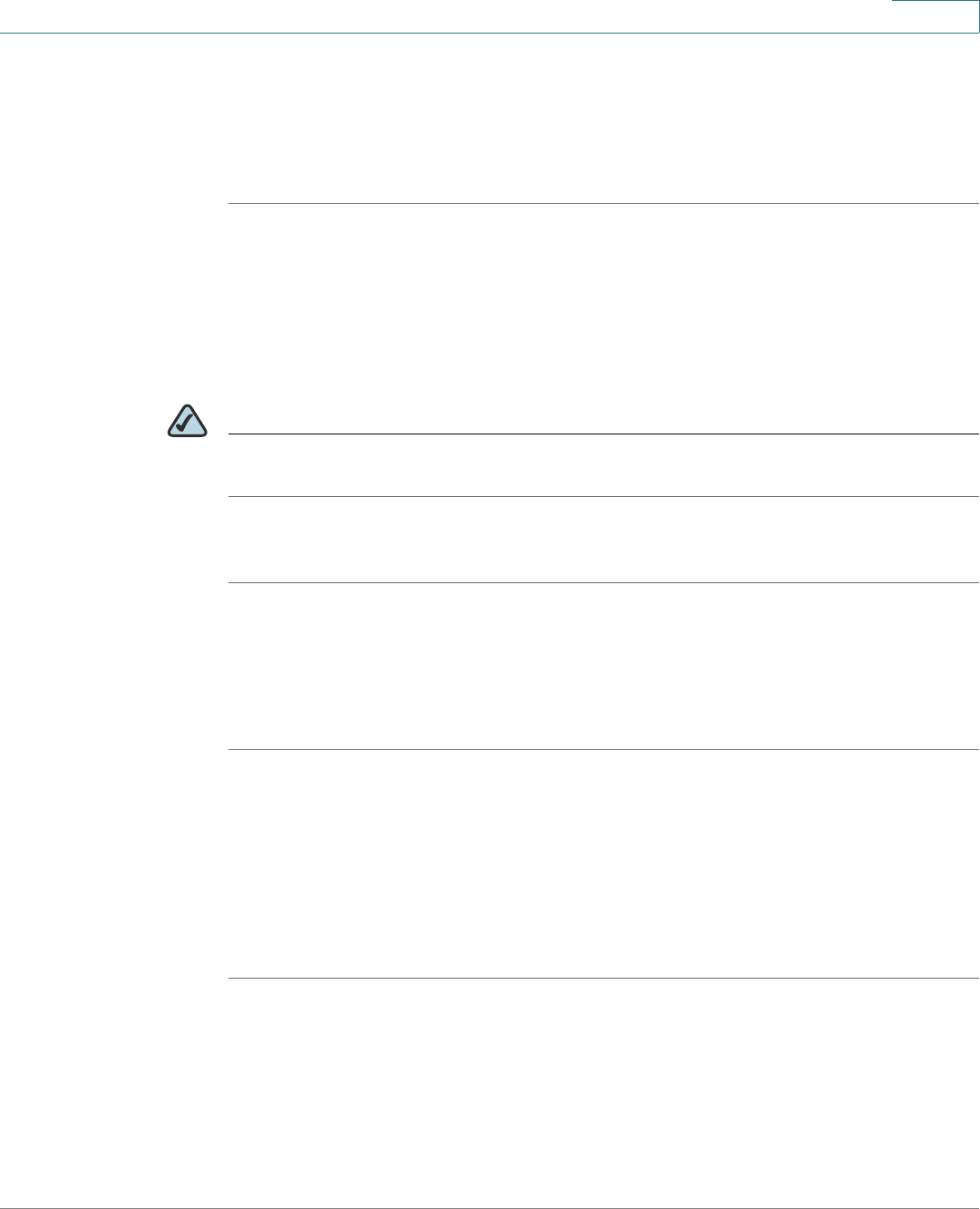
Configuring the Firewall
Configuring URL Blocking
Cisco RV180/RV180W Administration Guide 83
4
DRAFT - CISCO CONFIDENTIAL
NOTE: Many websites require that cookies be accepted in order for the site to be
accessed properly. Blocking cookies can cause many websites to not function
properly.
STEP 3 Click Save.
Adding Trusted Domains
You can add a list of trusted domains. These domains are bypassed during
keyword filtering. For example, if “yahoo” is added to the blocked keywords list
and www.yahoo.com is added to the trusted domain list, then www.yahoo.com
will be allowed, but mail.yahoo.com will not be allowed.
NOTE Before adding trusted domains, you must enable content filtering. See Enabling
Content Filtering, page 82.
To add trusted domains:
STEP 1 Choose Firewall > Content Filtering. The Trusted Domain Table displays a list of
currently configured trusted domains.
STEP 2 Click Add and enter the name of the trusted domain.
STEP 3 Click Save.
Configuring URL Blocking
You can block access to websites that contain specific keywords in the URL or
page contents. To configure URL blocking:
STEP 1 Choose Firewall > URL Blocking. The table displays currently blocked keywords.
STEP 2 Click Add Row.
STEP 3 Under Status, check the box to enable blocking for the new keyword.
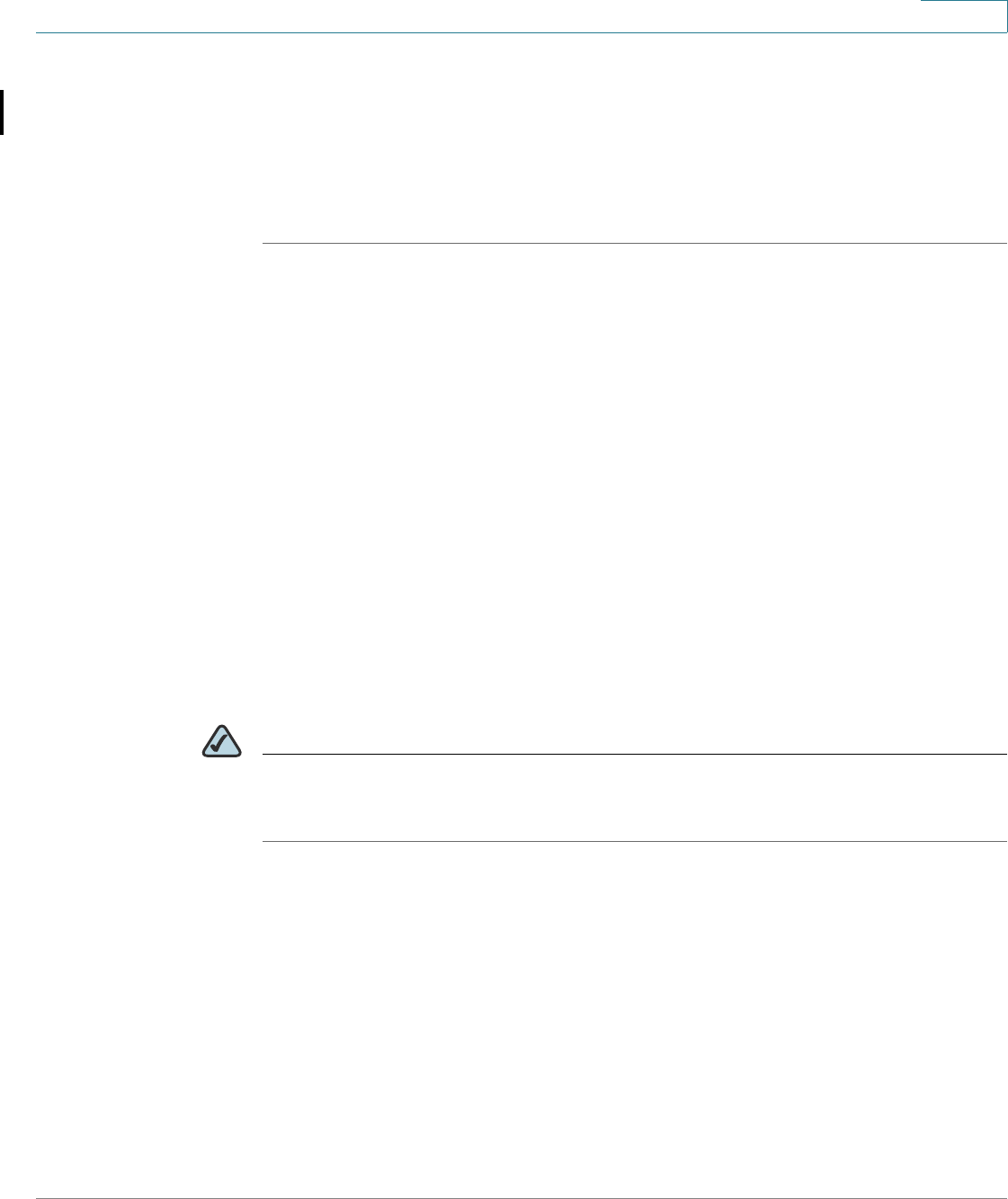
Configuring the Firewall
Configuring Port Triggering
Cisco RV180/RV180W Administration Guide 84
4
DRAFT - CISCO CONFIDENTIAL
STEP 4 Select the group to which to apply the keyword blocking. If you need to configure
a new group, click Configure LAN Groups. (See Configuring LAN (Local
Network) Groups, page 96.)
STEP 5 Enter the keyword to block.
STEP 6 Click Save.
Configuring Port Triggering
Port triggering allows devices on the LAN to request one or more ports to be
forwarded to them. Port triggering waits for an outbound request from the LAN on
one of the defined outgoing ports, and then opens an incoming port for that
specified type of traffic. Port triggering is a form of dynamic port forwarding while
an application is transmitting data over the opened outgoing or incoming ports.
Port triggering opens an incoming port for a specific type of traffic on a defined
outgoing port.
Port triggering is more flexible than static port forwarding (available when
configuring firewall rules) because a rule does not have to reference a specific
LAN IP or IP range. Ports are also not left open when not in use, thereby providing
a level of security that port forwarding does not offer.
NOTE Port triggering is not appropriate for servers on the LAN, since there is a
dependency on the LAN device making an outgoing connection before incoming
ports are opened.
Some applications require that, when external devices connect to them, they
receive data on a specific port or range of ports in order to function properly. The
router must send all incoming data for that application only on the required port or
range of ports. The gateway has a list of common applications and games with
corresponding outbound and inbound ports to open. You can also specify a port
triggering rule by defining the type of traffic (TCP or UDP) and the range of
incoming and outgoing ports to open when enabled.
Adding a Port Triggering Rule
To add a port triggering rule:

Configuring the Firewall
Configuring Port Forwarding
Cisco RV180/RV180W Administration Guide 85
4
DRAFT - CISCO CONFIDENTIAL
STEP 1 Choose Firewall > Port Triggering.
STEP 2 Click Add.
STEP 3 Specify an easily-identifiable name for this rule.
STEP 4 Check the Enable box to enable the rule.
STEP 5 Select whether the port uses TCP, UDP, or both protocols.
STEP 6 In the Outgoing (Trigger) Port Range section, specify the port number or range of
port numbers that will trigger this rule when a connection request from outgoing
traffic is made. If the outgoing connection uses only one port, then specify the
same port number in the Start Port and End Port fields.
STEP 7 In the Incoming (Response) Port Range section, specify the port number or range
of port numbers used by the remote system to respond to the request it receives.
If the incoming connection uses only one port, then specify the same port number
in the Start Port and End Port fields.
STEP 8 Click Save.
Configuring Port Forwarding
Port forwarding is used to redirect traffic from the Internet from one port on the
WAN to another port on the LAN. The port forwarding rules menu allows selection
of a service. Common services are available or you can define a custom service
and associated ports to forward.
The Port Forwarding Rule Table lists all the available port forwarding rules for this
device and allows you to configure port forwarding rules. The table contains the
following information:
•Action—Whether to block or allow traffic (always or by schedule) that
meets these filter rules, and when the rule is applicable.
•Service—Service for which this port forwarding rule is applicable.
•Status—A port forwarding rule can be disabled if not in use and enabled
when needed. The port forwarding rule is disabled if the status is disabled
and it is enabled if the status is enabled. Disabling a port forwarding rule
does not delete the configuration.

Configuring the Firewall
Configuring Port Forwarding
Cisco RV180/RV180W Administration Guide 86
4
DRAFT - CISCO CONFIDENTIAL
•Source IP—The source IP address for traffic from which traffic is forwarded
(Any, Single Address or Address Range).
•Destination IP—The IP address of the server to which traffic is forwarded.
•Forward From Port—From which port traffic will be forwarded.
•Forward To Port—To which port traffic will be forwarded.
Adding a Port Forwarding Configuration
To configure port forwarding:
STEP 1 Choose Firewall > Port Forwarding.
STEP 2 Click Add.
STEP 3 Choose the action:
•Always Block—Always block the selected type of traffic.
•Always Allow—Never block the selected type of traffic.
•Block by Schedule—Blocks the selected type of traffic according to a
schedule. Choose the schedule from the drop-down list. See Creating
Firewall Schedules, page 93.
•Allow by Schedule—Allows the selected type of traffic according to a
schedule. Choose the schedule from the drop-down list. See Creating
Firewall Schedules, page 93.
STEP 4 Under Service, select one of the common or custom services defined for this
device:
•AIM (AOL Instant Messenger)
•BGP (Border Gateway Control)
•BOOTP_CLIENT (Bootstrap Protocol client)
•BOOTP_SERVER (Bootstrap Protocol server)
•CU-SEEME (videoconferencing) UDP or TCP
•DNS (Domain Name System), UDP or TCP
•FINGER
•FTP (File Transfer Protocol)

Configuring the Firewall
Configuring Port Forwarding
Cisco RV180/RV180W Administration Guide 87
4
DRAFT - CISCO CONFIDENTIAL
•HTTP (Hyptertext Transfer Protocol)
•HTTPS (Secure Hypertext Transfer Protocol)
•ICMP (Internet Control Message Protocol) type 3 through 11 or 13
•ICQ (chat)
•IMAP (Internet Message Access Protocol) 2 or 3
•IRC (Internet Relay Chat)
•NEWS
•NFS (Network File System)
•NNTP (Network News Transfer Protocol)
•PING
•POP3 (Post Office Protocol)
•PPTP (Point-to-Point Tunneling Protocol)
•RCMD (command)
•REAL-AUDIO
•REXEC (Remote execution command)
•RLOGIN (Remote login)
•RTELNET (Remote telnet)
•RTSP (Real-Time Streaming Protocol) TCP or UDP
•SFTP (Secure Shell File Transfer Protocol)
•SMTP (Simple Mail Transfer Protocol)
•SNMP (Simple Network Management Protocol) TCP or UDP
•SNMP-TRAPS (TCP or UDP)
•SQL-NET (Structured Query Language)
•SSH (TCP or UDP)
•STRMWORKS
•TACACS (Terminal Access Controller Access-Control System)
•TELNET (command)

Configuring the Firewall
Configuring Port Forwarding
Cisco RV180/RV180W Administration Guide 88
4
DRAFT - CISCO CONFIDENTIAL
•TFTP (Trivial File Transfer Protocol)
•RIP (Routing Information Protocol)
•IKE
•SHTTPD (Simple HTTPD web server)
•IPSEC-UDP-ENCAP (UDP Encapsulation of IPsec packets)
•IDENT protocol
•VDOLIVE (live web video delivery)
•SSH (secure shell)
•SIP-TCP or SIP-UDP
STEP 5 Select the Source IP:
•Any—Specifies that the rule being created is for traffic from the given
endpoint.
•Single Address—Limit to one host. Requires the IP address of the host to
which this rule would be applied.
•Address Range—This is used to apply this rule to a group of computers/
devices within an IP address range. Requires a from IP address and to IP
address.
STEP 6 If you chose Single Address in Step 6, enter the IP address in the Start field.
STEP 7 If you chose Address Range in Step 6, enter the starting IP address of the range in
the Start field and the ending IP address of the range in the Finish field.
STEP 8 If you chose Always Allow, Block by Schedule, or Allow by Schedule in Step 3:
a. Enter the Destination IP address, or the address where traffic meeting the rule
should be sent.
b. In the Forward from Port field, choose Same as Incoming Port if the traffic
should be forwarded from the same port number on the outgoing server.
Otherwise, choose Specify Port and enter the port number in the Port Number
field.
c. In the Forward to Port field, Choose Same as Incoming Port if the traffic should
be sent to the same port on the receiving server. Otherwise, choose Specify
Port and enter the port number in the Port Number field.

Configuring the Firewall
Configuring a DMZ Host
Cisco RV180/RV180W Administration Guide 89
4
DRAFT - CISCO CONFIDENTIAL
STEP 9 Click Save.
Configuring a DMZ Host
The Cisco RV180/RV180W supports DMZ options. A DMZ is a sub-network that is
open to the public but behind the firewall. DMZ allows you to redirect packets
going to your WAN port IP address to a particular IP address in your LAN. It is
recommended that hosts that must be exposed to the WAN (such as web or e-mail
servers) be placed in the DMZ network. Firewall rules can be allowed to permit
access to specific services and ports to the DMZ from both the LAN or WAN. In
the event of an attack on any of the DMZ nodes, the LAN is not necessarily
vulnerable as well.
You must configure a fixed (static) IP address for the endpoint that will be
designated as the DMZ host. The DMZ host should be given an IP address in the
same subnet as the router's LAN IP address but it cannot be identical to the IP
address given to the LAN interface of this gateway.
STEP 1 Choose Firewall > DMZ Host.
STEP 2 Check the Enable box to enable DMZ on the network.
STEP 3 Enter the IP address for the endpoint that will receive the redirected packets. This
is the DMZ host.
STEP 4 Click Save. You must then configure firewall rules for the zone. See Creating
Custom Services, page 92.
Configuring Advanced Firewall Settings
This page allows you to configure many advanced firewall settings.

Configuring the Firewall
Configuring Advanced Firewall Settings
Cisco RV180/RV180W Administration Guide 90
4
DRAFT - CISCO CONFIDENTIAL
Configuring One-to-One Network Address Translation (NAT)
One-to-one NAT is a way to make systems behind a firewall that are configured
with private IP addresses appear to have public IP addresses.
To configure one-to-one NAT, choose Firewall > Advanced Settings > One-to-One
NAT. The One-to-One-NAT Rules Table lists the available One-To-One NAT rules
that have been configured. It displays the following fields:
•Private Range Begin—The starting IP address in the private (LAN) IP
address.
•Public Range Begin—The starting IP address in the public (WAN) IP
address.
•Range Length—Range length maps one to one private address to public
address up to the given range.
•Service—Shows configured services. Services for one-to-one NAT allow
you to configure the service to be accepted by the private IP (LAN) address
when traffic is sent to the corresponding public IP address. Configured
services on private IP addresses in the range are accepted when traffic is
available on the corresponding public IP address.
Adding a One-to-One NAT Rule
To add a one-to-one NAT rule:
STEP 1 Choose Firewall > Advanced Settings > One-to-One NAT.
STEP 2 Click Add.
STEP 3 Enter information in the following fields:
•Private Range Begin—The starting IP address in the private (LAN) IP
address.
•Public Range Begin—The starting IP address in the public (WAN) IP address.
•Range Length—Range length maps one to one private address to public
address up to the given range.
•Service—Choose the service for which the rule applies.
STEP 4 Click Save.

Configuring the Firewall
Configuring Advanced Firewall Settings
Cisco RV180/RV180W Administration Guide 91
4
DRAFT - CISCO CONFIDENTIAL
Configuring MAC Address Filtering
MAC address filtering allows you to block traffic coming from certain known
machines or devices. The router uses the MAC address of a computer or device
on the network to identify it and block or permit the access. Traffic coming in from
a specified MAC address will be filtered depending upon the policy.
To enable MAC address filtering:
STEP 1 Choose Firewall > Advanced Settings > MAC Filtering.
STEP 2 Check the Enable box to enable MAC Address Filtering for this device. Uncheck
the box to disable this feature.
If you enable MAC filtering, in the Policy for MAC Addresses Listed Below field,
choose one of the following options:
•Block and Allow the Rest—Choose this option to block the traffic from the
specified MAC addresses and to allow traffic from all other addresses.
•Allow and Block the Rest—Choose this option to allow the traffic from the
specified MAC addresses and to block traffic from all other machines on the
LAN side of the router.
For example, two computers are on the LAN with MAC addresses of
00:01:02:03:04:05 (host1), and 00:01:02:03:04:11 (host2). If the host1 MAC address
is added to the MAC filtering list and the “block and allow the rest” policy is
chosen, when this computer tries to connect to a website, the router will not allow
it to connect. However, host2 is able to connect because its MAC address is not in
the list. If the policy is “allow and block the rest,” then host1 is able to connect to a
website, but host2 is blocked because its URL is not in the list. The MAC filtering
policy does not override a firewall rule that directs incoming traffic to a host.
STEP 3 In the MAC Addresses table, click Add.
STEP 4 Enter the MAC address and description to add to the table and click Save. Repeat
for each address to allow or block.
STEP 5 Click Save.

Configuring the Firewall
Configuring Advanced Firewall Settings
Cisco RV180/RV180W Administration Guide 92
4
DRAFT - CISCO CONFIDENTIAL
Configuring IP/MAC Address Binding
IP/MAC Binding allows you to bind IP addresses to MAC address. Some machines
are configured with static addresses. To prevent users from changing static IP
addresses, IP/MAC Binding should be enabled. If the Cisco RV180/RV180W sees
packets with matching IP address but inconsistent MAC addresses, it drops those
packets.
To configure IP/MAC Address binding:
STEP 1 Choose Firewall > Advanced Settings > IP/MAC Binding. The table lists all the
currently defined IP/MAC binding rules and allows several operations on the rules.
STEP 2 Click Add to add a new rule.
STEP 3 In the name field, enter the name for this rule.
STEP 4 In the MAC Addresses field, enter the MAC Addresses (the physical address of
the piece of hardware) for this rule.
STEP 5 In the IP Addresses field, enter the IP Addresses to assign to the piece of
hardware.
STEP 6 Click Save.
Creating Custom Services
When you create a firewall rule, you can specify a service that is controlled by the
rule. Common types of services are available for selection, and you can create
your own custom services. This page allows creation of custom services against
which firewall rules can be defined. Once defined, the new service will appear in
the List of Available Custom Services table.
Adding a Custom Service
To create a custom service:
STEP 1 Choose Firewall > Advanced Settings > Custom Services.
STEP 2 Click Add.
STEP 3 Enter a service name for identification and management purposes.

Configuring the Firewall
Configuring Advanced Firewall Settings
Cisco RV180/RV180W Administration Guide 93
4
DRAFT - CISCO CONFIDENTIAL
STEP 4 Enter the service type, or layer 4 protocol that the service uses (TCP, UDP, ICMP,
ICMPv6, or other).
If you chose ICMP or ICMPv6 as the service type, enter the ICMP type. This is a
numeric value from 0 through 40 for ICMP and from 0 through 255 for ICMPv6.
STEP 5 If you chose TCP or UDP, in the Start Port field, enter the first TCP or UDP port of
the range that the service uses. In the Finish Port field, enter the last TCP or UDP
port of the range that the service uses.
STEP 6 If you chose Other, enter the number of the protocol in the Protocol Number field.
(For example, if you are using RDP, enter 27 in the protocol number field.)
STEP 7 Click Save.
Creating Firewall Schedules
You can create firewall schedules to apply firewall rules on specific days or at
specific times of the day.
Adding a Firewall Schedule
To create a schedule:
STEP 1 Choose Firewall > Advanced Settings > Schedules.
STEP 2 Click Add.
STEP 3 Enter a unique name to identify the schedule. This name is then available when you
create access or port forwarding rules.
STEP 4 Under Time, check All Day if you want the schedule to apply to the entire day.
Leave the box unchecked if you want it to only apply to certain hours of the day,
and enter the specific start and end times, selecting a.m. or p.m.
STEP 5 Under Repeat, check Everyday to apply the schedule to all the days of the week.
Leave the box unchecked if you want it to only apply to certain days, and check
the boxes next to the days you want to include in the schedule.
STEP 6 Click Save.

Configuring the Firewall
Configuring Advanced Firewall Settings
Cisco RV180/RV180W Administration Guide 94
4
DRAFT - CISCO CONFIDENTIAL
Configuring Sessions
You can limit the maximum number of unidentified sessions and half-open
sessions on the Cisco RV180/RV180W. You can also introduce timeouts for TCP
and UDP sessions to ensure Internet traffic is not deviating from expectations in
your private network.
To configure session settings:
STEP 1 Choose Firewall > Advanced Settings > Session Settings.
STEP 2 In the Maximum Unidentified Sessions field, enter the maximum number of
unidentified sessions for the ALG identification process. This value can range from
2 through 128. The default is 32 sessions.
STEP 3 In the Maximum Half Open Sessions field, enter the maximum number of half-open
sessions. A half-open session is the session state between receipt of a SYN
packet and the SYN/ACK packet. Under normal circumstances, a session is
allowed to remain in the half-open state for 10 seconds. The maximum value
ranges from 0 through 3,000. The default is 128 sessions.
STEP 4 In the TCP Session Timeout Duration field, enter the time, in seconds, after which
inactive TCP sessions are removed from the session table. Most TCP sessions
terminate normally when the RST or FIN flags are detected. This value ranges from
0 through 4,294,967 seconds. The default is 1,800 seconds (30 minutes).
STEP 5 In the UDP Session Timeout Duration field, enter the time, in seconds, after which
inactive UDP sessions are removed from the session table. This value ranges from
0 through 4,294,967 seconds. The default is 120 seconds (2 minutes).
STEP 6 In the Other Session Timeout Duration (seconds) field, enter the time, in seconds,
after which inactive non-TCP/UDP sessions are removed from the session table.
This value ranges from 0 through 4,294,967 seconds. The default is 60 seconds.
STEP 7 In the TCP Session Cleanup Latency (seconds) field, enter the maximum time for a
session to remain in the session table after detecting both FIN flags. This value
ranges from 0 through 4,294,967 seconds. The default is 10 seconds.
STEP 8 Click Save.
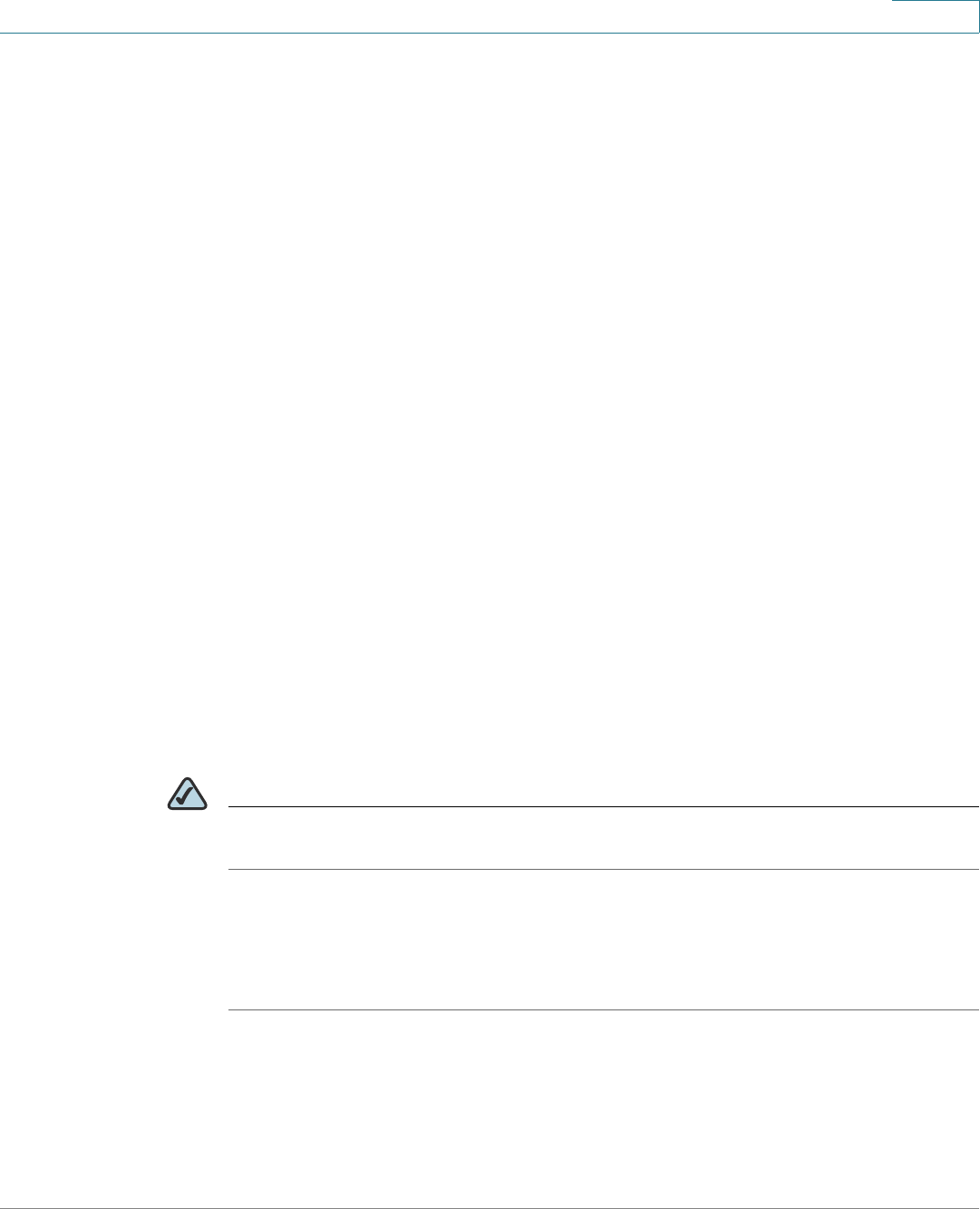
Configuring the Firewall
Configuring Advanced Firewall Settings
Cisco RV180/RV180W Administration Guide 95
4
DRAFT - CISCO CONFIDENTIAL
Configuring Internet Group Management Protocol (IGMP)
Internet Group Management Protocol (IGMP) is an exchange protocol for routers.
Hosts that want to receive multicast messages need to inform their neighboring
routers of their status. In some networks, each node in a network becomes a
member of a multicast group and receives multicast packets. In these situations,
hosts exchange information with their local routers using IGMP. Routers use IGMP
periodically to check if the known group members are active. IGMP provides a
method called dynamic membership by which a host can join or leave a multicast
group at any time.
The Allowed Networks table lists all the allowed networks configured for the
device and allows several operations on the allowed networks:
•Network Address—The network address from which the multicast packets
originate.
•Mask Length— Mask Length for the network address.
In this table you can perform the following actions:
•Check Box—Select all the allowed networks in the table.
•Delete—Deletes the selected allowed network or allowed networks.
•Add—Opens the Allowed Network Configuration page to add a new
network.
•Edit—Opens the Allowed Network Configuration page to edit the selected
network.
NOTE By default the device will forward multicast packets which are originating from its
immediate WAN network.
Adding Allowed Networks
To configure IGMP:
STEP 1 Choose Firewall > Advanced Settings > IGMP Configuration.
STEP 2 Check the Enable box to allow IGMP communication between the router and other
nodes in the network.

Configuring the Firewall
Configuring Advanced Firewall Settings
Cisco RV180/RV180W Administration Guide 96
4
DRAFT - CISCO CONFIDENTIAL
STEP 3 Choose the Upstream Interface (WAN or LAN). Select the interface (LAN or WAN)
on which the IGMP proxy acts as a normal multicast client.
STEP 4 Click Save.
Configuring LAN (Local Network) Groups
You can create LAN groups, which are groups of endpoints that are identified by
their IP address. After creating a group, you can then configure actions, such as
blocked keywords in a firewall rule, that apply to the group. (See Configuring URL
Blocking, page 83.)
To create a LAN Group:
STEP 1 Choose Firewall > Advanced Settings > LAN (Local Network) Groups.
STEP 2 Click Add.
STEP 3 Enter the group name; spaces and quotes are not supported. Click Save.
STEP 4 If the group consists of a single IP address, choose Single Address and enter the
address in the Start IP Address field. If the group consists of a range of IP
addresses, choose Address Range and enter the addresses in the Finish IP
Address fields.
STEP 5 Click Save.
Enabling Session Initiation Protocol Application-Level
Gateway (SIP ALG)
SIP ALG can rewrite information within SIP messages (SIP headers and SDP body)
making signaling and audio traffic possible between a client behind Network
Address Translation (NAT) and the SIP endpoint.
To enable SIP ALG:
STEP 1 Choose Firewall > Advanced Settings > SIP ALG.
STEP 2 Check the Enable box to enable SIP ALG support. If disabled, the router will not
allow incoming calls to the UAC (User Agent Client) behind the Cisco RV180/
RV180W.

Configuring the Firewall
Firewall Configuration Examples
Cisco RV180/RV180W Administration Guide 97
4
DRAFT - CISCO CONFIDENTIAL
STEP 3 Click Save.
Firewall Configuration Examples
Example 1: Allow inbound HTTP traffic to the DMZ
In this example, you host a public web server on your local DMZ network. You
want to allow inbound HTTP requests from any outside IP address to the IP
address of your web server at any time of day.
Create an inbound rule as follows:
Example 2: Allow videoconferencing from range of outside IP addresses.
In this example, you want to allow incoming videoconferencing to be initiated from
a restricted range of outside IP addresses (132.177.88.2 - 132.177.88.254), from a
branch office.
Create an inbound rule as follows. In the example, CUSeeMe connections are
allowed only from a specified range of external IP addresses.
Parameter Value
Connection Type Inbound
Action Always Allow
Service HTTP
Source IP Any
Send to Local Server (DNAT IP) 192.168.5.2 (web server IP address)
Rule Status Enabled
Parameter Value
Connection Type Inbound

Configuring the Firewall
Firewall Configuration Examples
Cisco RV180/RV180W Administration Guide 98
4
DRAFT - CISCO CONFIDENTIAL
Example 3: Multi-NAT Configuration
In this example, you want to configure multi-NAT to support multiple public IP
addresses on one WAN port interface.
Create an inbound rule that configures the firewall to host an additional public IP
address. Associate this address with a web server on the DMZ. If you arrange with
your ISP to have more than one public IP address for your use, you can use the
additional public IP addresses to map to servers on your LAN. One of these public
IP addresses is used as the primary IP address of the router. This address is used
to provide Internet access to your LAN PCs through NAT. The other addresses are
available to map to your DMZ servers.
The following addressing scheme is used to illustrate this procedure:
•WAN IP addre ss: 10.1.0.118
• LAN IP address: 192.168.1.1; subnet 255.255.255.0
• Web server PC in the DMZ, IP address: 192.168.1.2
• Access to Web server: (simulated) public IP address 10.1.0.52
Action Always Allow
Service CU-SEEME:UDP
Source IP Address Range
Start 132.177.88.2
Finish 134.177.88.254
Send to Local Server (DNAT IP) 192.168.1.11
Rule Status Enabled
Parameter Value
Parameter Value
Connection Type Inbound
Action Always Allow
Service HTTP

Configuring the Firewall
Firewall Configuration Examples
Cisco RV180/RV180W Administration Guide 99
4
DRAFT - CISCO CONFIDENTIAL
Example 4: Block traffic by schedule if generated from specific range of
machines
In this example, you want to block all HTTP traffic on the weekends if the request
originates from a specific group of machines in the LAN having a known range of
IP addresses, and anyone coming in through the Network from the WAN (i.e. all
remote users).
STEP 1 Setup a schedule. Choose Firewall > Advanced Settings > Schedules.
STEP 2 Click Add.
STEP 3 Enter the schedule name (for example, “Weekend”).
STEP 4 Under Time, check All Day.
STEP 5 Under Repeat, leave Everyday unchecked.
STEP 6 Check Saturday and Sunday.
STEP 7 Click Save.
Create an outbound access rule with the following parameters:
Source IP Single Address
Start 10.1.0.52
Send to Local Server (DNAT IP) 192.168.1.2 (local IP address of your web server)
Rule Status Enabled
Parameter Value
Parameter Value
Connection Type Outbound
Action Block by Schedule
Schedule Weekend
Service HTTP

Configuring the Firewall
Firewall Configuration Examples
Cisco RV180/RV180W Administration Guide 100
4
DRAFT - CISCO CONFIDENTIAL
Create an inbound access rule with the following parameters:
Source IP Address Range
Start starting IP address
Finish ending IP address
Destination IP Any
Rule Status Enabled
Parameter Value
Parameter Value
Connection Type Inbound
Action Block by Schedule
Schedule Weekend
Service All Traffic
Source IP Any
Rule Status Enabled

Configuring the Firewall
Firewall Configuration Examples
Cisco RV180/RV180W Administration Guide 101
4
DRAFT - CISCO CONFIDENTIAL

Configuring the Firewall
Firewall Configuration Examples
Cisco RV180/RV180W Administration Guide 102
4
DRAFT - CISCO CONFIDENTIAL

5
Cisco RV180/RV180W Administration Guide 103
DRAFT - CISCO CONFIDENTIAL
Configuring Virtual Private Networks (VPNs)
and Security
This chapter describes VPN configuration, beginning with the “Configuring
VPNs” section on page 103.
It also describes how to configure router security, beginning with the “Configuring
Security” section on page 117.
The following sections are covered:
•Configuring VPNs, page 103
•Configuring a Basic VPN, page 104
•Configuring Advanced VPN Parameters, page 105
•Configuring Security, page 117
Configuring VPNs
A VPN provides a secure communication channel (“tunnel”) between two gateway
routers or a remote PC client and a gateway router. The following types of tunnels
can be created:
•Gateway-to-gateway VPN—Connects two or more routers to secure traffic
between remote sites.
•Remote Client (client-to-gateway VPN tunnel)—A remote client, such as a
PC running VPN client software, initiates a VPN tunnel. The IP address of the
remote PC client is not known in advance. The gateway acts as responder.
Creating Cisco QuickVPN Client Users
To use the Cisco QuickVPN, you must do the following:

Configuring Virtual Private Networks (VPNs) and Security
Configuring VPNs
Cisco RV180/RV180W Administration Guide 104
5
DRAFT - CISCO CONFIDENTIAL
STEP 1 Enable remote management. See Configuring Remote Management, page 130.
STEP 2 Create QuickVPN users. See Configuring VPN Users, page 115. After a user
account is created, the credentials can be used by the QuickVPN client.
For more information on installing and using Cisco QuickVPN, see Appendix A,
“Using Cisco QuickVPN for Windows 7, 2000, XP, or Vista.”
Configuring a Basic VPN
Use the basic VPN setup function to create a VPN with default values as proposed
by the VPN Consortium (VPNC) and a Pre-shared Key (PSK). You can change
these values later if you need to further configure any VPN parameters.
To configure a basic VPN:
STEP 1 Choose VPN > IPsec > Basic VPN Setup.
STEP 2 Choose to which peers the VPN tunnel will connect:
•Gateway—Connects the Cisco RV180/RV180W to a gateway using a secure
tunnel.
•VPN Client—Connects the Cisco RV180/RV180W to remote clients. The
remote clients must run VPN client software.
STEP 3 Enter a name for the connection. The connection name is used for management.
STEP 4 Enter a pre-shared key. The VPN client or gateway will need to enter this key to
establish the VPN connection.
STEP 5 Choose the type of address for the remote gateway, or the gateway to which the
Cisco RV180/RV180W will connect:
•IP Address—Enter the IP address of the gateway in the field below.
•FQDN (Fully-Qualified Domain Name)—Enter the domain name in the field
below (for example, http://www.cisco.com).
STEP 6 Choose the type of address for the local gateway (the Cisco RV180/RV180W):
•IP Address—Enter the IP address of the gateway in the box below.
•FQDN (Fully-Qualified Domain Name)—Enter the domain name in the box
below (for example, http://www.cisco.com).

Configuring Virtual Private Networks (VPNs) and Security
Configuring VPNs
Cisco RV180/RV180W Administration Guide 105
5
DRAFT - CISCO CONFIDENTIAL
STEP 7 If you chose gateway in Step 2, enter the IP address and subnet mask of the
remote LAN. The remote gateway to which the Cisco RV180/RV180W will connect
is located on that LAN.
NOTE: The IP address range used on the remote LAN must be different from the IP
address range used on the local LAN.
STEP 8 Click Save.
Configuring Secure Connection Remote Accessibility
•Remote LAN (Local Network) IP Address
•Remote LAN (Local Network) Subnet Mask
•Local LAN (Local Network) IP Address
•Local LAN (Local Network) Subnet Mask
Viewing the Default VPN Settings
To view the default VPN settings:
STEP 1 Choose VPN > IPsec > Basic VPN Setup.
STEP 2 Click View Default Settings. Settings cannot be changed from this page, but can
be configured through the Basic VPN Setup or Advanced VPN Setup menus.
Configuring Advanced VPN Parameters
The Advanced VPN Setup page allows you to configure advanced VPN
parameters, such as IKE and other VPN policies. These policies control how the
Cisco RV180/RV180W initiates and receives VPN connections with other
endpoints.
Configuring IKE Policies
The Internet Key Exchange (IKE) protocol dynamically exchanges keys between
two IPsec hosts. You can create IKE policies to define the security parameters
such as authentication of the peer, encryption algorithms, etc. to be used in this
process. Be sure to use compatible encryption, authentication, and key-group
parameters for the VPN policy.

Configuring Virtual Private Networks (VPNs) and Security
Configuring VPNs
Cisco RV180/RV180W Administration Guide 106
5
DRAFT - CISCO CONFIDENTIAL
To configure IKE Policies:
STEP 1 Choose VPN > IPsec > Advanced VPN Setup. In the IKE Policy Table, click Add.
STEP 2 Under Policy Name, enter a unique name for the policy for identification and
management purposes.
STEP 3 Under Direction/Type, choose one of the following connection methods:
•Initiator—The router will initiate the connection to the remote end.
•Responder—The router will wait passively and respond to remote IKE
requests.
•Both—The router will work in either Initiator or Responder mode.
STEP 4 Under Exchange Mode, choose one of the following options:
•Main—This mode negotiates the tunnel with higher security, but is slower.
•Aggressive—This mode establishes a faster connection, but with lowered
security.
NOTE: If either the Local or Remote identifier type is not an IP address, then
negotiation is only possible in Aggressive Mode. If FQDN, User FQDN or DER
ASN1 DN is selected, the router disables Main mode and sets the default to
Aggressive mode.
STEP 5 In the Local section, under Identifier Type, choose the Internet Security
Association and Key Management Protocol (ISAKMP) identifier for this router:
•Local WAN (Internet) IP
•FQDN
•User-FQDN
•DER ASN1 DN
STEP 6 If you chose FQDN, User-FQDN, or DER ASN1 DN as the identifier type, enter the IP
address or domain name in the Identifier field.
STEP 7 In the Remote section, under Identifier Type, choose the ISAKMP identifier for this
router:
•Remote WAN (Internet) IP
•FQDN
•User FQDN

Configuring Virtual Private Networks (VPNs) and Security
Configuring VPNs
Cisco RV180/RV180W Administration Guide 107
5
DRAFT - CISCO CONFIDENTIAL
•DER ASN1 DN
STEP 8 If you chose FQDN, User-FQDN, or DER ASN1 DN as the identifier type, enter the IP
address or domain name in the Identifier field.
IKE SA Parameters
The Security Association (SA) parameters define the strength and mode for
negotiating the SA.
STEP 1 Choose the encryption algorithm, or the algorithm used to negotiate the SA:
•DES
•3DES
•AES-128
•AES-192
•AES-256
STEP 2 Specify the authentication algorithm for the VPN header:
•MD5
•SHA-1
•SHA2-256
•SHA2-384
•SHA2-512
NOTE: Ensure that the authentication algorithm is configured identically on both
sides.
STEP 3 Choose the authentication method:
•Select Pre-Shared Key for a simple password based key that is shared with
the IKE peer.
•Select RSA-Signature to disable the pre-shared key text field and use the
Active Self Certificate uploaded in the Certificates page. A certificate must
be configured in order for RSA-Signature to work.

Configuring Virtual Private Networks (VPNs) and Security
Configuring VPNs
Cisco RV180/RV180W Administration Guide 108
5
DRAFT - CISCO CONFIDENTIAL
NOTE: The double quote character (“) is not supported in the pre-shared key.
STEP 4 Choose the Diffie-Hellman (DH) Group algorithm, which is used when exchanging
keys. The DH Group sets the strength of the algorithm in bits.
NOTE: Ensure that the DH Group is configured identically on both sides of the IKE
policy.
STEP 5 In the SA Lifetime field, enter the interval, in seconds, after which the Security
Association becomes invalid.
STEP 6 To enable dead peer detection, check the Enable box. Dead Peer Detection is
used to detect whether the peer is alive or not. If peer is detected as dead, the
router deletes the IPsec and IKE Security Association.
STEP 7 In the Detection Period field, enter the interval, in seconds, between consecutive
DPD R-U-THERE messages. DPD R-U-THERE messages are sent only when the
IPsec traffic is idle.
STEP 8 In the Reconnect after Failure Count field, enter the maximum number of DPD
failures allowed before tearing down the connection.
Extended Authentication (XAUTH) Parameters
Rather than configuring a unique VPN policy for each user, you can enable the VPN
gateway router to authenticate users from a stored list of user accounts or with an
external authentication server such as a RADIUS server. When connecting many
VPN clients to a VPN gateway router, Extended Authentication (XAUTH) allows
authentication of users with methods in addition to the authentication method
mentioned in the IKE SA parameters. XAUTH can be configured in the following
modes:
STEP 1 Select the XAUTH type:
•None—Disables XAUTH.
•Edge Device—Authentication is done by one of the following:
-User Database—User accounts created in the router are used to
authenticate users. See Configuring VPN Users, page 115.
-RADIUS-PAP—Authentication is done using a RADIUS server and
password authentication protocol (PAP).
-RADIUS-CHAP—Authentication is done using a RADIUS server and
challenge handshake authentication protocol (CHAP).

Configuring Virtual Private Networks (VPNs) and Security
Configuring VPNs
Cisco RV180/RV180W Administration Guide 109
5
DRAFT - CISCO CONFIDENTIAL
•IPsec Host—The router is authenticated by a remote gateway with a
username and password combination. In this mode, the router acts as a VPN
Client of the remote gateway.
STEP 2 If you selected IPsec Host, enter the username and password for the host.
Configuring VPN Policies
To configure a VPN policy:
STEP 1 Choose VPN > IPsec > Advanced VPN Setup.
STEP 2 In the VPN Policy Table, click Add.
STEP 3 Enter a unique name to identify the policy.
STEP 4 Choose the Policy Type:
•Auto Policy—Some parameters for the VPN tunnel are generated
automatically. This requires using the IKE (Internet Key Exchange) protocol to
perform negotiations between the two VPN Endpoints.
•Manual Policy—All settings (including the keys) for the VPN tunnel are
manually input for each end point. No third-party server or organization is
involved.
To create an Auto VPN Policy, you need to first create an IKE policy and then add
the corresponding Auto Policy for that IKE Policy. (See Auto Policy Parameters,
page 113.)
STEP 5 In the Remote Endpoint field, select the type of identifier that you want to provide
for the gateway at the remote endpoint: IP Address or FQDN (Fully Qualified
Domain Name).
STEP 6 In the NetBIOS field, check the Enable box to allow NetBIOS broadcasts to travel
over the VPN tunnel, or uncheck this box to disable NetBIOS broadcasts over the
VPN tunnel. For client policies, the NetBIOS feature is available by default.

Configuring Virtual Private Networks (VPNs) and Security
Configuring VPNs
Cisco RV180/RV180W Administration Guide 110
5
DRAFT - CISCO CONFIDENTIAL
Local Traffic Selection and Remote Traffic Section
STEP 1 For both of these sections, configure the following settings:
•Local/Remote IP—Select the type of identifier that you want to provide for
the endpoint:
-Any—Specifies that the policy is for traffic from the given end point (local
or remote). Note that selecting Any for both local and remote end points
is not valid.
-Single—Limits the policy to one host. Enter the IP address of the host that
will be part of the VPN in Start IP Address field.
-Range—Allows computers within an IP address range to connect to the
VPN. Enter the Start IP Address and End IP Address in the provided fields.
-Subnet—Allows an entire subnet to connect to the VPN. Enter the
network address in the Start IP Address field, and enter the Subnet Mask
in the Subnet Mask field.
STEP 2 In the Start Address field, enter the first IP address in the range. If you selected
Single, enter the single IP address in this field and leave the End IP Address field
blank.
STEP 3 In the End Address field, enter the last IP address in the range.
STEP 4 If you chose Subnet as the type, enter the Subnet Mask of the network.
Split DNS
Split DNS allows the Cisco RV180/RV180W to find the DNS server of the remote
router without going through the ISP (Internet).
To e n a b l e s p l i t D N S :
STEP 1 Check the Enable box.
STEP 2 In the Domain Name Server 1 field, specify a Domain Name server IP address,
which is used only to resolve the domain configured in the Domain Name 1 field.
STEP 3 In the Domain Name Server 2 field, specify a Domain Name server IP address,
which is used only to resolve the domain configured in the Domain Name 2 field.
STEP 4 In the Domain Name 1 field, specify a domain name, which will be queried only
using the DNS server configured in the Domain Name Server 1 field.

Configuring Virtual Private Networks (VPNs) and Security
Configuring VPNs
Cisco RV180/RV180W Administration Guide 111
5
DRAFT - CISCO CONFIDENTIAL
STEP 5 In the Domain Name 2 field, specify a domain name, which will be queried only
using the DNS server configured in the Domain Name Server 2 field.
NOTE Make sure that you avoid using overlapping subnets for remote or local traffic
selectors. Using these subnets would require adding static routes on the router and
the hosts to be used.
For example, a combination to avoid would be:
Local Traffic Selector: 192.168.1.0/24
Remote Traffic Selector: 192.168.0.0/16
Manual Policy Parameters
If you chose manual as the policy type in Step 4, configure the manual policy
parameters. The Manual Policy creates an SA (Security Association) based on the
following static inputs:
SPI-Incoming, SPI-Outgoing—Enter a hexadecimal value between 3 and 8
characters; for example, 0x1234.
Encryption Algorithm—Select the algorithm used to encrypt the data.
•Key-In—Enter the encryption key of the inbound policy. The length of the
key depends on the algorithm chosen:
-DES—8 characters
-3DES—24 characters
-AES-128—16 characters
-AES-192—24 characters
-AES-256—32 characters
-AES-CCM—16 characters
-AES-GCM—20 characters
•Key-Out—Enter the encryption key of the outbound policy. The length of the
key depends on the algorithm chosen, as shown above.
Integrity Algorithm—Select the algorithm used to verify the integrity of the data.

Configuring Virtual Private Networks (VPNs) and Security
Configuring VPNs
Cisco RV180/RV180W Administration Guide 112
5
DRAFT - CISCO CONFIDENTIAL
•Key-In—Enter the integrity key (for ESP with Integrity-mode) for the inbound
policy. The length of the key depends on the algorithm chosen:
-MD5—16 characters
-SHA-1— 20 characters
-SHA2-256—32 characters
-SHA2-384— 48 characters
-SHA2-512—64 characters
•Key-Out—Enter the integrity key (for ESP with Integrity-mode) for the
outbound policy. The length of the key depends on the algorithm chosen, as
shown above.
Manual Policy Example:
Creating a VPN tunnel between two routers:
Router 1: WAN1=10.0.0.1 LAN=192.168.1.1 Subnet=255.255.255.0
Policy Name: manualVPN
Policy Type: Manual Policy
Local Gateway: WAN1
Remote Endpoint: 10.0.0.2
Local IP: Subnet 192.168.1.0 255.255.255.0
Remote IP: Subnet 192.168.2.0 255.255.255.0
SPI-Incoming: 0x1111
Encryption Algorithm: DES
Key-In: 11112222
Key-Out: 33334444
SPI-Outgoing: 0x2222
Integrity Algorithm: MD5
Key-In: 1122334444332211
Key-Out: 5566778888776655
Router 2: WAN1=10.0.0.2 LAN=192.168.2.1 Subnet=255.255.255.0
Policy Name: manualVPN
Policy Type: Manual Policy
Local Gateway: WAN1
Remote Endpoint: 10.0.0.1
Local IP: Subnet 192.168.2.0 255.255.255.0
Remote IP: Subnet 192.168.2.0 255.255.255.0
SPI-Incoming: 0x2222
Encryption Algorithm: DES
Key-In: 33334444
Key-Out: 11112222
SPI-Outgoing: 0x1111
Integrity Algorithm: MD5
Key-In: 5566778888776655
Key-Out: 1122334444332211

Configuring Virtual Private Networks (VPNs) and Security
Configuring VPNs
Cisco RV180/RV180W Administration Guide 113
5
DRAFT - CISCO CONFIDENTIAL
Auto Policy Parameters
If you chose auto as the policy type in Step 4, configure the following:
STEP 1 SA Lifetime—Enter the duration of the Security Association and choose the unit
from the drop-down list:
•Seconds—Choose this option to measure the SA Lifetime in seconds. After
the specified number of seconds passes, the Security Association is
renegotiated. The default value is 3600 seconds. The minimum value is 300
seconds.
•Kbytes—Choose this option to measure the SA Lifetime in kilobytes. After
the specified number of kilobytes of data is transferred, the SA is
renegotiated. The minimum value is 1920000 KB.
NOTE: When configuring a lifetime in kilobytes (also known as lifebytes), be aware
that two SAs are created for each policy. One SA applies to inbound traffic, and
one SA applies to outbound traffic. Due to differences in the upstream and
downstream traffic flows, the SA may expire asymmetrically. For example, if the
downstream traffic is very high, the lifebyte for a download stream may expire
frequently. The lifebyte of the upload stream may not expire as frequently. It is
recommended that the values be reasonably set, to reduce the difference in
expiry frequencies of the SAs; otherwise the system may eventually run out of
resources as a result of this asymmetry. The lifebyte specifications are generally
recommended for advanced users only.
STEP 2 Select the algorithm used to encrypt the data.
STEP 3 Select the algorithm used to verify the integrity of the data.
STEP 4 Under PFS Key Group, check the Enable box to enable Perfect Forward Secrecy
(PFS) to improve security. While slower, this protocol helps to prevent
eavesdroppers by ensuring that a Diffie-Hellman exchange is performed for every
phase-2 negotiation.
STEP 5 Choose the IKE policy that will define the characteristics of phase 1 of the
negotiation. (For information on creating these policies, see Configuring IKE
Policies, page 105.)

Configuring Virtual Private Networks (VPNs) and Security
Configuring VPNs
Cisco RV180/RV180W Administration Guide 114
5
DRAFT - CISCO CONFIDENTIAL
Configuring VPN Clients
VPN clients must be configured with the same VPN policy parameters used in the
VPN tunnel the client wishes to use: encryption, authentication, life time, and PFS
key-group. Upon establishing these authentication parameters, the VPN Client
user database must also be populated with an account to give a user access to
the tunnel.
VPN client software is required to establish a VPN tunnel between the router and
remote endpoint. Open source software (such as OpenVPN or Openswan) as well
as Microsoft IPsec VPN software can be configured with the required IKE policy
parameters to establish an IPsec VPN tunnel. Refer to the client software guide for
detailed instructions on setup as well as the router’s online help.
The user database contains the list of VPN user accounts that are authorized to
use a given VPN tunnel. Alternatively VPN tunnel users can be authenticated using
a configured RADIUS database. Refer to the online help to determine how to
populate the user database and/or configure RADIUS authentication.
Monitoring VPN Tunnel Status
You can view and change the status of (connect or drop) the router’s IPsec
security associations by performing one of the following actions:
•Choose VPN > IPsec > Advanced VPN Setup and click IPsec VPN
Connection Status.
•Choose Status > IPsec Connection Status.
Here the active IPsec SAs (security associations) are listed along with the traffic
details and tunnel state. The traffic is a cumulative measure of transmitted/
received packets since the tunnel was established.
If a VPN policy state is “not connected”, it can be enabled from the List of VPN
Policies in the VPN > IPsec > Advanced VPN Setup page.
The Active IPsec SAs table displays a list of active IPsec SAs. Table fields are as
follows:
Field Description
Policy Name IKE or VPN policy associated with this SA.
Endpoint IP address of the remote VPN gateway or client.

Configuring Virtual Private Networks (VPNs) and Security
Configuring VPNs
Cisco RV180/RV180W Administration Guide 115
5
DRAFT - CISCO CONFIDENTIAL
Configuring VPN Users
To view a list of VPN users, choose VPN > IPsec > VPN Users. The VPN gateway
authenticates users in this list when XAUTH is used in an IKE policy. QuickVPN
clients can access only default LAN hosts.
Configuring a PPTP Server
If you are using a Point-to-Point Tunneling Protocol VPN server:
STEP 1 Choose VPN > IPsec > VPN Users.
STEP 2 Under PPTP Server, check the Enable box.
STEP 3 Enter the IP address of the PPTP server.
STEP 4 In the Starting IP Address field, enter the starting IP address of the range of IPs to
assign to connecting users.
NOTE: The starting IP of the PPTP client IP range is used as the PPTP server IP of
the Cisco RV180/RV180W and the remaining PPTP client IP address range is used
to assign IP addresses to PPTP clients.
STEP 5 In the Ending IP Address field, enter the ending IP address of the range of IPs to
assign to connecting users.
Adding New VPN Users
To add new users:
STEP 1 Choose VPN > IPsec > VPN Users.
STEP 2 In the VPN Client Setting Table, click Add.
STEP 3 Check the Enabled box.
Packets Number of IP packets transmitted over this SA.
Kbytes Kilobytes of data transmitted over this SA.
State Status of the SA for IKE policies: Not Connected or
IPsec SA Established.
Action Choose Connect to establish a connection, or Drop
to terminate an established connection.

Configuring Virtual Private Networks (VPNs) and Security
Configuring VPNs
Cisco RV180/RV180W Administration Guide 116
5
DRAFT - CISCO CONFIDENTIAL
STEP 4 Enter the username.
STEP 5 Enter the password. If you want the user to be able to change the password, check
the Enabled box.
STEP 6 Under Protocol, choose the type of user:
•QuickVPN—The user is authenticated by the VPN server. See Creating
Cisco QuickVPN Client Users, page 103.
•PPTP—The user is authenticated by a PPTP server.
•XAUTH—The user is authenticated by an external authorization server, such
as a RADIUS server.
STEP 7 Click Save.
.
Configuring VPN Passthrough
VPN passthrough allows VPN traffic that originates from VPN clients to pass
through the router. For example, if you are not using a VPN that is configured on the
Cisco RV180/RV180W, but are using a laptop to access a VPN at another site,
configuring VPN passthrough allows that connection.
To configure VPN passthrough:
STEP 1 Choose VPN > IPsec > VPN Passthrough.
STEP 2 Choose the type of traffic to allow to pass through the router:
•IPsec—Check Enable to allow IP security tunnels to pass through the router.
•PPTP—Check Enable to allow Point-to-Point Tunneling Protocol tunnels to
pass through the router.
•L2TP—Check Enable to allow Layer 2 Tunneling Protocol tunnels to pass
through the router.
STEP 3 Click Save.

Configuring Virtual Private Networks (VPNs) and Security
Configuring Security
Cisco RV180/RV180W Administration Guide 117
5
DRAFT - CISCO CONFIDENTIAL
Configuring Security
The Cisco RV180/RV180W provides several security methods, including
certificate authentication, RADIUS server support, and 802.1x port-based
authentication.
Using SSL Certificates for Authentication
The Cisco RV180/RV180W uses digital certificates for IPsec VPN authentication
and SSL validation (for HTTPS and SSL VPN authentication). You can obtain a
digital certificate from a well-known Certificate Authority (CA) such as VeriSign, or
generate and sign your own certificate using functionality available on this
gateway. The gateway comes with a self-signed certificate, and this can be
replaced by one signed by a CA as per your networking requirements. A CA
certificate provides strong assurance of the server's identity and is a requirement
for most corporate network VPN solutions.
A self certificate is a certificate issued by a CA identifying your device (or self-
signed if you don't want the identity protection of a CA). To request a self
certificate to be signed by a CA, you can generate a Certificate Signing Request
from the gateway by entering identification parameters and sending to the CA for
signing. Once signed, the CA's Trusted Certificate and signed certificate from the
CA are uploaded to activate the self-certificate validating the identity of this
gateway. The self certificate is then used in IPsec and SSL connections with peers
to validate the gateway's authenticity.
To configure certificates, choose Security > SSL Certificate. You can choose the
following options:
•Truste d Certificates—Upload a certificate from a trusted authority (for
example, a certificate Authority such as Microsoft or VeriSign). See
Uploading a Trusted Certificate.
•Self Certificates—Upload a certificate that has been generated from the
Cisco RV180/RV180W, and either signed by a CA, or self-signed. See
Uploading a Self Certificate.
•Self Certificate Requests—Generate a self-certificate request to give to a
CA for signing, or to self-certify. See Generating New Certificate
Requests.
•Export Router Certificate—Export a router certificate to give to clients who
want to connect to the router and use the certificate for authentication. See
Exporting the Router’s Current Certificate.

Configuring Virtual Private Networks (VPNs) and Security
Configuring Security
Cisco RV180/RV180W Administration Guide 118
5
DRAFT - CISCO CONFIDENTIAL
Uploading a Trusted Certificate
If you have a certificate from a trusted authority to upload, the file must be located
on the computer connected to the Cisco RV180/RV180W. Perform the following
steps:
STEP 1 Choose Security > SSL Certificate.
STEP 2 In the Trusted Certificates (CA Certificate) Table, click Upload.
STEP 3 Click Browse and locate the file on your computer.
STEP 4 Click Upload. The new certificate appears in the table.
Generating New Certificate Requests
One of the steps in creating a certificate is to generate a certificate request from
the computer or the device that will be using the certificate. The Certificate
Signing Request (CSR) file needs to be submitted to the CA who will then
generate a certificate for this device.
To generate a certificate request:
STEP 1 Choose Security > SSL Certificate.
STEP 2 Under Self Certificate Requests, click Generate Certificate.
STEP 3 Enter the name of the certificate request.
STEP 4 Enter the subject of the certificate request. The Subject field populates the CN
(Common Name) entry of the generated certificate. Subject names are usually
defined in the following format:
CN=, OU=, O=, L=, ST=, C=.
For example, CN=router1, OU=my_company, O=mydept, L=SFO, C=US.
STEP 5 Choose the Hash Algorithm: MD5 or SHA-1. The algorithm used to sign the
certificate (RSA) is shown.
STEP 6 Enter the signature key length, or the length of the signature (512,1024, or 2048).
STEP 7 (Optional) Enter the IP address of the router.
STEP 8 (Optional) Enter the domain name of the router.

Configuring Virtual Private Networks (VPNs) and Security
Configuring Security
Cisco RV180/RV180W Administration Guide 119
5
DRAFT - CISCO CONFIDENTIAL
STEP 9 (Optional) Enter the e-mail address of the company contact that is used when
generating the self certificate request.
STEP 10 Click Save. A new certificate request is created and appears in the Self Certificate
Requests Table.
STEP 11 Click Export for Admin to save the certificate file. This file is submitted to the CA
for signing, unless your organization is self-certifying.
Viewing a Self Certificate Request
To view the contents of a self certificate request:
STEP 1 Choose Security > SSL Certificate.
STEP 2 Under Self Certificate Requests, click View.
STEP 3 The contents of the request are displayed. This information is necessary to give to
the CA if you are getting the certificate signed.
Exporting a Self Certificate Request
To export the router’s current certificate request:
STEP 1 Choose Security > SSL Certificate.
STEP 2 Under Self Certificate Requests, click Export for Admin. This exports the
certificate request to a .csr file.
Uploading a Self Certificate
You can upload a certificate that you have generated from the Cisco RV180/
RV180W and has been either signed by a CA, or signed by your organization. The
file must be located on the computer connected to the Cisco RV180/RV180W.
Perform the following steps:
STEP 1 Choose Security > SSL Certificate.
STEP 2 In the Active Self Certificates Table, click Upload.

Configuring Virtual Private Networks (VPNs) and Security
Configuring Security
Cisco RV180/RV180W Administration Guide 120
5
DRAFT - CISCO CONFIDENTIAL
STEP 3 Click Browse and locate the file on your computer.
STEP 4 Click Upload. The new certificate appears in the table.
Exporting the Router’s Current Certificate
To export the router’s current certificate:
STEP 1 Choose Security > SSL Certificate.
STEP 2 Under Export Certificate, click Export for Client to export the certificate. It will be
uploaded to an endpoint that will connect to the Cisco RV180/RV180W as a VPN
client.
Using the Cisco RV180/RV180W With a RADIUS Server
A RADIUS server can be configured to maintain a database of user accounts and
can be used for authenticating this device's users. To configure a connection with a
RADIUS server, choose Security > RADIUS Server. You can configure and view the
following details in the RADIUS configuration pages:
•IP address—The IP address of the authenticating RADIUS server.
•Authentication Port—The RADIUS authentication server's port number used
to send RADIUS traffic.
•Timeout—The timeout interval (in seconds) after which the Cisco RV180/
RV180W re-authenticates with the RADIUS server.
•Retries—The number of retries for the Cisco RV180/RV180W to re-
authenticate with the RADIUS server. If the number of retries is exceeded,
authentication of this device with the RADIUS server has failed.
Adding a RADIUS Server Configuration
To configure a connection with a RADIUS server:
STEP 1 In the RADIUS Server Table, click Add.
STEP 2 In the Authentication Server IP Address field, enter the IP address of the
authenticating RADIUS Server.

Configuring Virtual Private Networks (VPNs) and Security
Configuring Security
Cisco RV180/RV180W Administration Guide 121
5
DRAFT - CISCO CONFIDENTIAL
STEP 3 In the Authentication Port field, enter the port number on which the RADIUS server
sends traffic.
STEP 4 In the Secret field, enter the shared key that allows the Cisco RV180/RV180W to
authenticate with the RADIUS server. This key must match the key configured on
the RADIUS server. The single quote, double quote, and space characters are not
allowed in this field.
STEP 5 In the Timeout field, enter the timeout interval after which the Cisco RV180/
RV180W re-authenticates with the RADIUS server.
STEP 6 In the Retries field, enter the number of retries for the Cisco RV180/RV180W to re-
authenticate with the RADIUS server.
STEP 7 Click Save.
Configuring Captive Portal
STEP 1 Under Captive Portal, check Enable.
STEP 2 Click Save.
STEP 3 Choose the Captive Portal interface:
•LAN
STEP 4 Enter the Authserver Hostname.
STEP 5 Enter the Gateway ID.
STEP 6 In the Permitted MAC Address Table, enter the MAC addresses of the permitted
hardware.
STEP 7 Click Save.

Configuring Virtual Private Networks (VPNs) and Security
Configuring Security
Cisco RV180/RV180W Administration Guide 122
5
DRAFT - CISCO CONFIDENTIAL
Configuring 802.1x Port-Based Authentication
A port-based network access control uses the physical access characteristics of
IEEE 802 LAN infrastructures in order to provide a means of authenticating and
authorizing devices attached to a LAN port that has point-to-point connection
characteristics. It also prevents access to that port in cases where the
authentication fails. It provides an authentication mechanism to devices trying to
connect to a LAN. The Cisco RV180/RV180W acts as a supplicant in the 802.1x
authentication system.
To configure 802.1x Authentication:
STEP 1 Choose Security > 802.1x Configuration.
STEP 2 Check the Enable box to configure a port as an 802.1x supplicant.
STEP 3 Select the LAN port that should be configured as an 802.1x supplicant.
STEP 4 Enter the username and password sent by the Cisco RV180/RV180W to the
authenticator for authentication. The username and password are the credentials
sent to the authenticating server (the device running 802.1X in an authenticator
role; for example, a Cisco Catalyst switch).
STEP 5 Press Save.

6
Cisco RV120W Administration Guide 123
DRAFT - CISCO CONFIDENTIAL
Configuring Quality of Service (QoS)
The Cisco RV180/RV180W lets you configure the following Quality of Service
(QoS) features:
•Configuring WAN QoS Profiles, page 123
•Configuring Profile Binding, page 125
•Configuring CoS Settings, page 126
•Mapping CoS Settings to DSCP Values, page 127
Configuring WAN QoS Profiles
WAN QoS profiles let you manage the bandwidth of the traffic flowing from the
secure network (LAN) to the insecure network (WAN).
You can configure WAN QoS profiles to control the rate at which the RV180/
RV180W transmits data. For example, limiting the outbound traffic helps you
prevent the LAN users from consuming all of the bandwidth of the Internet link.
Configuring Global Settings
To configure the WAN QoS global settings:
STEP 1 Choose QoS > WAN QoS Profiles.
STEP 2 Under Global Settings:
a. To enable WAN QoS, check Enable.
b. Set the WAN QoS mode by clicking the Priority or Rate Limit radio button.
The Priority option lets you allocate bandwidth based on a priority level.
The Rate Limit option lets you specify the total WAN bandwidth (1–100 Mbps).

Configuring Quality of Service (QoS)
Configuring WAN QoS Profiles
Cisco RV120W Administration Guide 124
6
DRAFT - CISCO CONFIDENTIAL
For more information, see Configuring Bandwidth Allocation Settings,
page 124.
STEP 3 When prompted to reset the previous priority or rate limit configuration, click OK.
STEP 4 Click Save.
Configuring Bandwidth Allocation Settings
To configure the WAN QoS bandwidth allocation settings:
STEP 1 Choose QoS > WAN QoS Profiles.
STEP 2 Under Priority Bandwidth Allocation Settings:
If the WAN QoS mode is set to Priority, enter this information:
Each one of these values specifies the percentage of the total bandwidth
(100 Mbps) allocated to these priority levels.
If the WAN QoS mode is set to Rate Limit, enter this information:
STEP 3 Click Save.
Adding WAN QoS Profiles
To add a WAN QoS profile:
STEP 1 Choose QoS > WAN QoS Profiles.
STEP 2 In the WAN QoS Profile Table, click Add.
High Priority Enter a value between 61 (default) and 100.
Medium Priority Enter a value between 31 (default) and 60.
Low Priority Enter a value between 10 (default) and 30.
Total WAN (Internet)
Bandwidth
Enter the total WAN bandwidth (1–100 Mbps).

Configuring Quality of Service (QoS)
Configuring Profile Binding
Cisco RV120W Administration Guide 125
6
DRAFT - CISCO CONFIDENTIAL
STEP 3 Enter this information:
STEP 4 Click Save.
STEP 5 To bind the profile to a traffic selector, see Configuring Profile Binding, page 125.
Configuring Profile Binding
After creating WAN QoS profiles, you must bind them to traffic selectors. The
Profile Binding Table displays the profiles you have added, along with the service
to which the profile applies, the traffic selector match type (IP address range, MAC
address, VLAN, DSCP, or SSID), and the profile to which the binding is matched (in
the “match configuration” field).
Adding a Profile Binding
To create a profile binding:
STEP 1 Choose QoS > Profile Binding.
STEP 2 In the Available Profiles field, choose a WAN QoS profile.
To create a profile, click Configure Profile. See Configuring WAN QoS Profiles,
page 123 for more information.
STEP 3 From the Service drop-down menu, choose the service the profile applies to.
Name Enter the name of the profile.
Priority If the WAN QoS mode is set to Priority, choose the
priority level from the drop-down menu.
Minimum Bandwidth
Rate
If the WAN QoS mode is set to Rate Limit, enter the
minimum bandwidth rate (1 to total WAN
bandwidth in Kbps).
Maximum Bandwidth
Rate
If the WAN QoS mode is set to Rate Limit, enter the
maximum bandwidth rate (100–1000000 Kbps).

Configuring Quality of Service (QoS)
Configuring CoS Settings
Cisco RV120W Administration Guide 126
6
DRAFT - CISCO CONFIDENTIAL
If the service you are looking for is not in the drop-down menu, you can configure a
custom service in the Firewall page (see Creating Custom Services, page 92.)
STEP 4 From the Traffic Selector Match Type drop-down menu, choose the traffic selector
to use to bind traffic to the profile.
STEP 5 Depending on the traffic selector you chose, enter this information:
STEP 6 Click Save.
Configuring CoS Settings
You can map CoS priority settings to the traffic forwarding queue on the RV180/
RV180W.
To map CoS priority settings to the traffic forwarding queue:
STEP 1 Choose QoS > CoS Settings > Cos Settings.
STEP 2 In the CoS to Queue field, check Enable.
Starting IP Address Enter the starting IP address of the range.
Ending IP Address Enter the ending IP address of the range.
MAC Address Enter the MAC address for any client device (for
example, a PC or wireless client) to which you want
to assign the bandwidth.
VLAN ID Choose the VLAN ID on the router to which the
traffic selector applies.
DSCP Value Enter the Differentiated Services Code Point
(DSCP) value (0–63).
This value determines how the traffic is prioritized.
Available SSIDs Choose the SSID the selector applies to from the
drop-down menu.
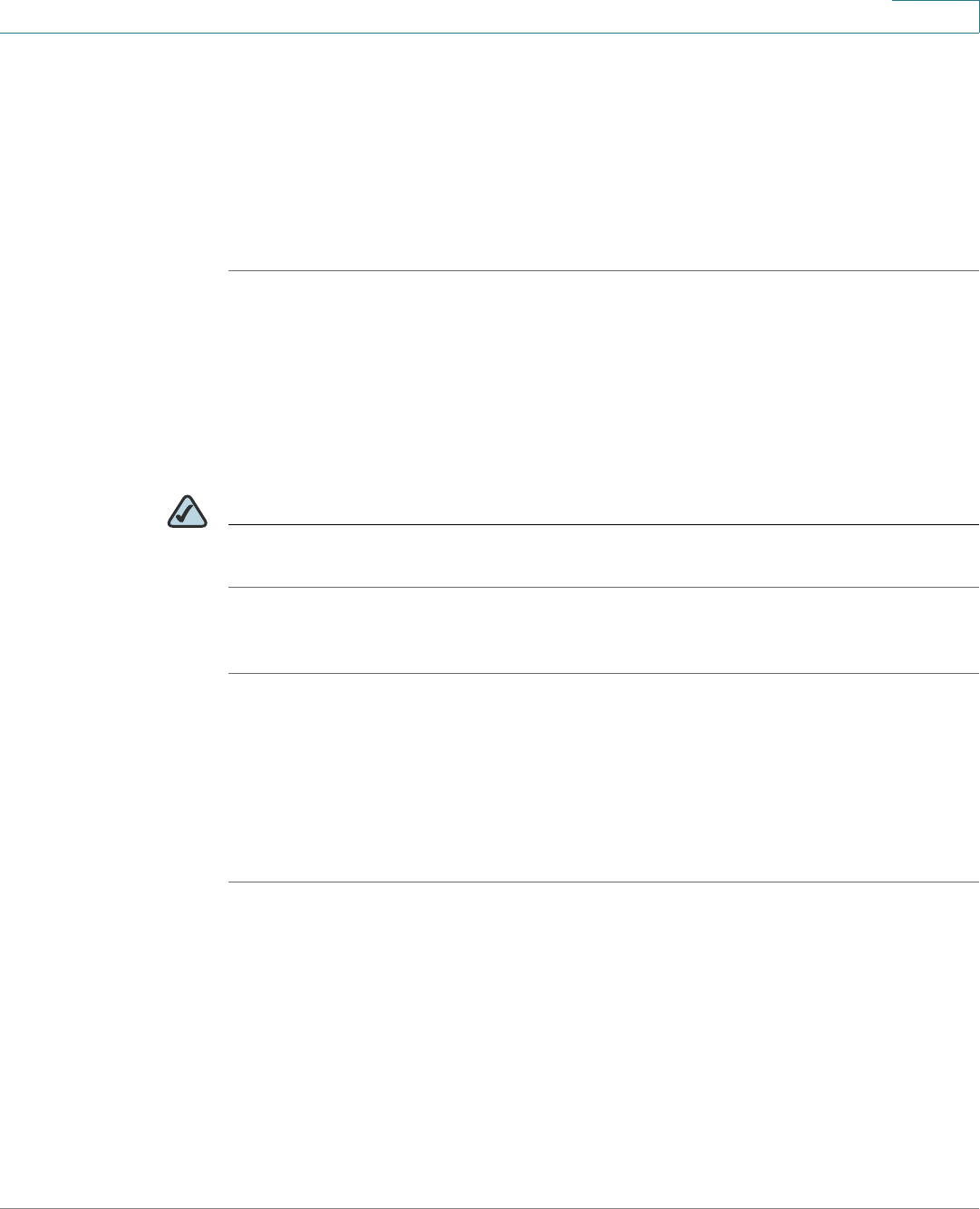
Configuring Quality of Service (QoS)
Mapping CoS Settings to DSCP Values
Cisco RV120W Administration Guide 127
6
DRAFT - CISCO CONFIDENTIAL
STEP 3 For each CoS priority level in the CoS to Traffic Forwarding Queue Mapping
Table, choose a priority value from the Traffic Forwarding Queue drop-down
menu.
These values mark traffic types with higher or lower traffic priority depending on
the type of traffic.
STEP 4 Click Save.
To restore the default CoS settings, click Restore Default and, when prompted,
click OK. Then, click Save.
Mapping CoS Settings to DSCP Values
NOTE Before you can map CoS settings to DSCP values, you must first enable the CoS to
Queue option. See Configuring CoS Settings, page 126 for more information.
To map CoS settings to DSCP values:
STEP 1 Choose QoS > CoS Settings > CoS to DSCP.
STEP 2 In the CoS to DSCP field, check Enable.
STEP 3 For each CoS priority level, enter the corresponding DSCP value (0–63). The
default value is 63.
STEP 4 Click Save.
To restore the default CoS to DSCP mappings, click Restore Default and, when
prompted, click OK. Then, click Save.

7
Cisco RV180/RV180W Administration Guide 128
DRAFT - CISCO CONFIDENTIAL
Administering Your Cisco RV180/RV180W
This chapter describes the administration features of the Cisco RV180/RV180W,
including creating users, configuring network management, diagnostics and
logging, date and time, and other settings. It contains the following sections:
•Configuring Language, page 129
•Configuring Password Rules, page 129
•Using the Management Interface, page 129
•Configuring Network Management, page 132
•Configuring the WAN Traffic Meter, page 135
•Using Network Diagnostic Tools, page 136
•Capturing and Tracing Packets, page 137
•Configuring Logging, page 138
•Configuring the Discovery Settings, page 141
•Configuring Time Settings, page 143
•Backing Up and Restoring the System, page 143
•Importing CSV Files, page145
•Upgrading Firmware, page 145
•Rebooting the Cisco RV180/RV180W, page 146
•Restoring the Factory Defaults, page 146
•Choosing the Device Mode (Cisco RV180W), page 146

Administering Your Cisco RV180/RV180W
Configuring Language
Cisco RV180/RV180W Administration Guide 129
7
DRAFT - CISCO CONFIDENTIAL
Configuring Language
To configure the language for the Cisco RV180/RV180W graphical user interface:
STEP 1 Choose Administration > Language Selection.
STEP 2 Choose the language you want to use from the drop-down list.
STEP 3 Click Save.
Configuring Password Rules
The Cisco RV180/RV180W can enforce rules for passwords selected by
administrators and users. To configure password rules:
STEP 1 Choose Administration > Password Rules.
STEP 2 Check the Enable box.
STEP 3 In the Individual Rule Settings field, in the Minimal Password Length field, enter the
minimum password length.
NOTE: Passwords cannot be the same as the username, which is “admin” by
default.
STEP 4 Click Save.
Using the Management Interface
The Cisco RV180/RV180W provides a management interface to configure
accounts for user and administrative access to the system.
Configuring Web Access
You can enable access on the LAN interface of the Cisco RV180/RV180W. If a user
connects a PC to the LAN port, web access is then allowed using secure HTTP.

Administering Your Cisco RV180/RV180W
Using the Management Interface
Cisco RV180/RV180W Administration Guide 130
7
DRAFT - CISCO CONFIDENTIAL
To enable web access on the LAN port:
STEP 1 Choose Administration > Management Interface > Web Access.
STEP 2 In the LAN section, under HTTPS Web Access on LAN Interface, check Enable.
Configuring Remote Management
You can enable remote access so that administrators can log in remotely to the
system and access the web interface. To enable remote management:
STEP 1 Choose Administration > Management Interface > Remote Management.
STEP 2 Under Remote Management, check Enable.
STEP 3 Choose the Access Type:
•All IP Addresses—The Cisco RV180/RV180W can be accessed from any IP
address. Be sure to change the password if you select this option to prevent
unauthorized persons from accessing your network.
•IP Address Range—If you want to restrict access to certain computers, you
can select a range of IP addresses. Only computers having IP addresses in
this range can access the Cisco RV180/RV180W management interface.
Choose one of the following:
-IP Address Range—Allow access to the Cisco RV180/RV180W only from
computers that have IP addresses in the specified range.
-Single IP Address—Allow access to the Cisco RV180/RV180W only from
a computer that has a specified IP address.
STEP 4 If you chose IP Address Range, enter the start and end of the IP address number
range. If you chose Single IP Address, enter the IP address.
STEP 5 Enter the port number if you want to restrict access to only come from a specified
port on the machine that is connecting remotely.
STEP 6 You can enable Simple Network Management Protocol (SNMP), which allows you
to monitor and manage your router from an SNMP manager. SNMP provides a
remote means to monitor and control network devices, and to manage
configurations, statistics collection, performance, and security. To allow remote

Administering Your Cisco RV180/RV180W
Using the Management Interface
Cisco RV180/RV180W Administration Guide 131
7
DRAFT - CISCO CONFIDENTIAL
management of the Cisco RV180/RV180W by SNMP, under Remote SNMP, check
Enable.
Configuring User Accounts
The Cisco RV180/RV180W supports two user accounts for administering and
viewing settings: an administrative user (default user name: “admin”) and a “guest”
user (default user name: “guest”). The guest account has read-only access. You
can set and change the username and password for both the administrator and
guest accounts.
Configuring Password Aging
STEP 1 Choose Administration > Management Interface > User Accounts.
STEP 2 In the Password Aging section, check Enable to enable password aging. Password
aging requires the user to enter a new password after the password has expired.
STEP 3 Enter the password aging time. This is the number of days before the password
expires.
STEP 4 Click Save.
Configuring Usernames and Passwords
STEP 1 Choose Administration > Management Interface > User Accounts.
STEP 2 Click either Edit Admin Settings or Edit Guest Settings.
STEP 3 Enter the new username.
STEP 4 Enter the old password.
STEP 5 Enter the new password. It is recommended that passwords contains no
dictionary words from any language, and are a mix of letters (both uppercase and
lowercase), numbers, and symbols. The password can be up to 30 characters.
STEP 6 Click Save.

Administering Your Cisco RV180/RV180W
Configuring Network Management
Cisco RV180/RV180W Administration Guide 132
7
DRAFT - CISCO CONFIDENTIAL
Setting the Session Timeout Value
The timeout value is the number of minutes of inactivity that are allowed before the
Device Manager session is ended. This can be configured for the Admin and
Guest accounts:
STEP 1 Choose Administration > Session Timeout.
STEP 2 In the Administrator Inactivity Timeout field, enter the number, in minutes, before an
administrator login session times out due to inactivity.
STEP 3 In the Guest Inactivity Timeout field, enter the number, in minutes, before a guest
login session times out due to inactivity.
STEP 4 Click Save.
Configuring Network Management
The Cisco RV180/RV180W supports Simple Network Management (SNMP) to
allow you to monitor and manage your router from an SNMP manager. SNMP
provides a remote means to monitor and control network devices, and to manage
configurations, statistics collection, performance, and security.
Configuring SNMP
To configure SNMP:
STEP 1 Choose Administration > Network Management.
STEP 2 Under SNMP, check Enable.
STEP 3 Click Save.
Editing SNMPv3 Users
SNMPv3 parameters can be configured for the two default Cisco RV180/RV180W
user accounts (Admin and Guest). To configure:

Administering Your Cisco RV180/RV180W
Configuring Network Management
Cisco RV180/RV180W Administration Guide 133
7
DRAFT - CISCO CONFIDENTIAL
STEP 1 In the SNMPv3 User Table, check the box for the user to edit and click Edit.
STEP 2 Under Security Level, choose the amount of SNMPv3 Privileges:
•NoAuthNoPriv—Doesn't require any Authentication and Privacy.
•AuthNoPriv—Submit only Authentication algorithm and password.
•AuthPriv—Submit Authentication/privacy algorithm and password.
STEP 3 If you chose AuthNoPriv or AuthPriv, choose the type of authentication algorithm
(MD5 or SHA) and enter the authentication password.
STEP 4 If you chose AuthPriv, choose the type of privacy algorithm (DES or AES) and enter
the privacy password.
STEP 5 Click Save.
Adding SNMP Traps
The Trap s List Table lists IP addresses of SNMP agents to which the router will
send trap messages (notifications) and allows several operations on the SNMP
agents.
To add a new trap:
STEP 1 In the Trap Table, click Add.
STEP 2 Enter the IP Address of the SNMP manager or trap agent.
STEP 3 Enter the SNMP trap port of the IP address to which the trap messages will be
sent.
STEP 4 Choose the SNMP Version: v1, v2c, or v3.
STEP 5 Enter the community string to which the agent belongs. Most agents are
configured to listen for traps in the Public community.
STEP 6 Click Save.

Administering Your Cisco RV180/RV180W
Configuring Network Management
Cisco RV180/RV180W Administration Guide 134
7
DRAFT - CISCO CONFIDENTIAL
Configuring Access Control Rules
The SNMP v1/v2c Access Control Table is a table of access rules that enables
read-only or read-write access for select IP addresses in a defined SNMP agent's
community.
To configure access control rules:
STEP 1 In the SNMP v1/v2c Access Control Table, click Add.
STEP 2 Enter the IP Address of the specific SNMP manager or trap agent on which to
create an access rule.
STEP 3 Enter the subnet mask used to determine the list of allowed SNMP managers.
STEP 4 Enter the community string to which the agent belongs. Most agents are
configured to listen for traps in the Public community.
STEP 5 Choose the access type. The SNMP manager or trap agent can either be allowed
to read and modify all SNMP accessible settings (rwcommunity) or be given read-
only access (rocommunity).
STEP 6 Click Save.
Configuring Additional SNMP Information
To configure additional SNMP information:
STEP 1 Choose Administration > Network Management > SNMP System Information.
STEP 2 You can enter the following information:
•SysContact—Enter the name of the contact person for this router. Examples:
admin, John Doe.
•SysLocation—Enter the physical location of the router. Example: Rack #2, 4th
Floor.
•SysName—The default system name is displayed. To change, click Edit and
enter a name for easy identification of the router.
STEP 3 Click Save.

Administering Your Cisco RV180/RV180W
Configuring the WAN Traffic Meter
Cisco RV180/RV180W Administration Guide 135
7
DRAFT - CISCO CONFIDENTIAL
Configuring the WAN Traffic Meter
The WAN traffic meter displays statistics for traffic coming from the WAN (Internet)
to the Cisco RV180/RV180W, and traffic going from the Cisco RV180/RV180W to
the WAN.
To configure the WAN Traffic Meter:
STEP 1 Choose Administration > WAN Traffic Meter.
STEP 2 Under WAN Traffic Meter, to enable the display of WAN traffic statistics, check
Enable.
STEP 3 Choose the type of traffic to display:
•No Limit—Display all traffic.
•Download Only—Only display traffic coming to the Cisco RV180/RV180W
from the Internet.
•Both Directions—Display traffic coming to the Cisco RV180/RV180W from
the Internet, and traffic going from the Cisco RV180/RV180W to the Internet.
STEP 4 If you want to limit traffic to or from the router, you can specify a size limit. When
that size limit is reached, traffic is prevented from entering or exiting the router.
Enter a number, in megabytes, in the Monthly Limit field.
STEP 5 To increase the monthly limit for that month, check Increase this Month’s Limit by:
and enter the additional megabytes for that month.
STEP 6 Click Save.
To restart the traffic counter:
STEP 1 Choose Administration > WAN Traffic Meter.
STEP 2 Under Traf fic Counter, select Restart Now, or Specific Time, and enter the time you
want the traffic counter to restart.
STEP 3 (Optional) Check the box to send an email report containing the traffic meter
statistics before the counter is reset.
STEP 4 Click Save.

Administering Your Cisco RV180/RV180W
Using Network Diagnostic Tools
Cisco RV180/RV180W Administration Guide 136
7
DRAFT - CISCO CONFIDENTIAL
To configure what the Cisco RV180/RV180W does when the traffic limit is
reached:
STEP 1 Choose Administration > WAN Traffic Meter.
STEP 2 Under When Limit Is Reached, select one of the following:
•Block All Traffic—All traffic to and from the Cisco RV180/RV180W is
blocked.
•Block All Traffic Except E-Mail—Only email is allowed to and from the
Cisco RV180/RV180W.
STEP 3 (Optional) Check the box to send an email alert when the traffic limit has been
reached and traffic is being blocked.
STEP 4 Click Save.
To view traffic statistics, choose Administration > WAN Traffic Meter. Under WAN
(Internet) Traffic Statistics, information is displayed about WAN traffic to and from
the Cisco RV180/RV180W.
Using Network Diagnostic Tools
Using PING
PING can be used to test connectivity between this router and another device on
the network connected to this router. To use PING:
STEP 1 Choose Diagnostics > Network Tools.
STEP 2 Under Ping or Trace an IP Address, enter an IP address or domain name and click
Ping. A popup window appears, indicating the ICMP echo request status.
STEP 3 (Optional) Check the box if you want to allow PING traffic to pass through VPN
tunnels.

Administering Your Cisco RV180/RV180W
Capturing and Tracing Packets
Cisco RV180/RV180W Administration Guide 137
7
DRAFT - CISCO CONFIDENTIAL
Using Traceroute
Traceroute displays all the routers present between the destination IP address
and this router. Up to 30 “hops” (intermediate routers) between this router and the
destination will be displayed. To use traceroute:
STEP 1 Choose Diagnostics > Network Tools.
STEP 2 Under Ping or Trace an IP Address, enter an IP address or domain name and click
Traceroute. A popup window appears with the hop information.
Performing a DNS Lookup
A DNS lookup can be performed to retrieve the IP address of a Web, FTP, Mail or
any other Server on the Internet. To perform a DNS lookup:
STEP 1 Choose Diagnostics > Network Tools.
STEP 2 Enter the WAN (Internet) Name in the text box and click Lookup. If the host or
domain entry exists, you will see a response with the IP address. A message
stating “Unknown Host” indicates that the specified Internet Name does not exist.
Capturing and Tracing Packets
You can capture all packets that pass through a selected interface (LAN or WAN).
To capture packets:
STEP 1 Choose Diagnostics > Capture Packets.
STEP 2 Click Packet Trace; a new window appears.
STEP 3 Select the interface whose packets you want to trace and click Start. To stop the
packet capture, click Stop. You can click Download to save a copy of the packet
capture.
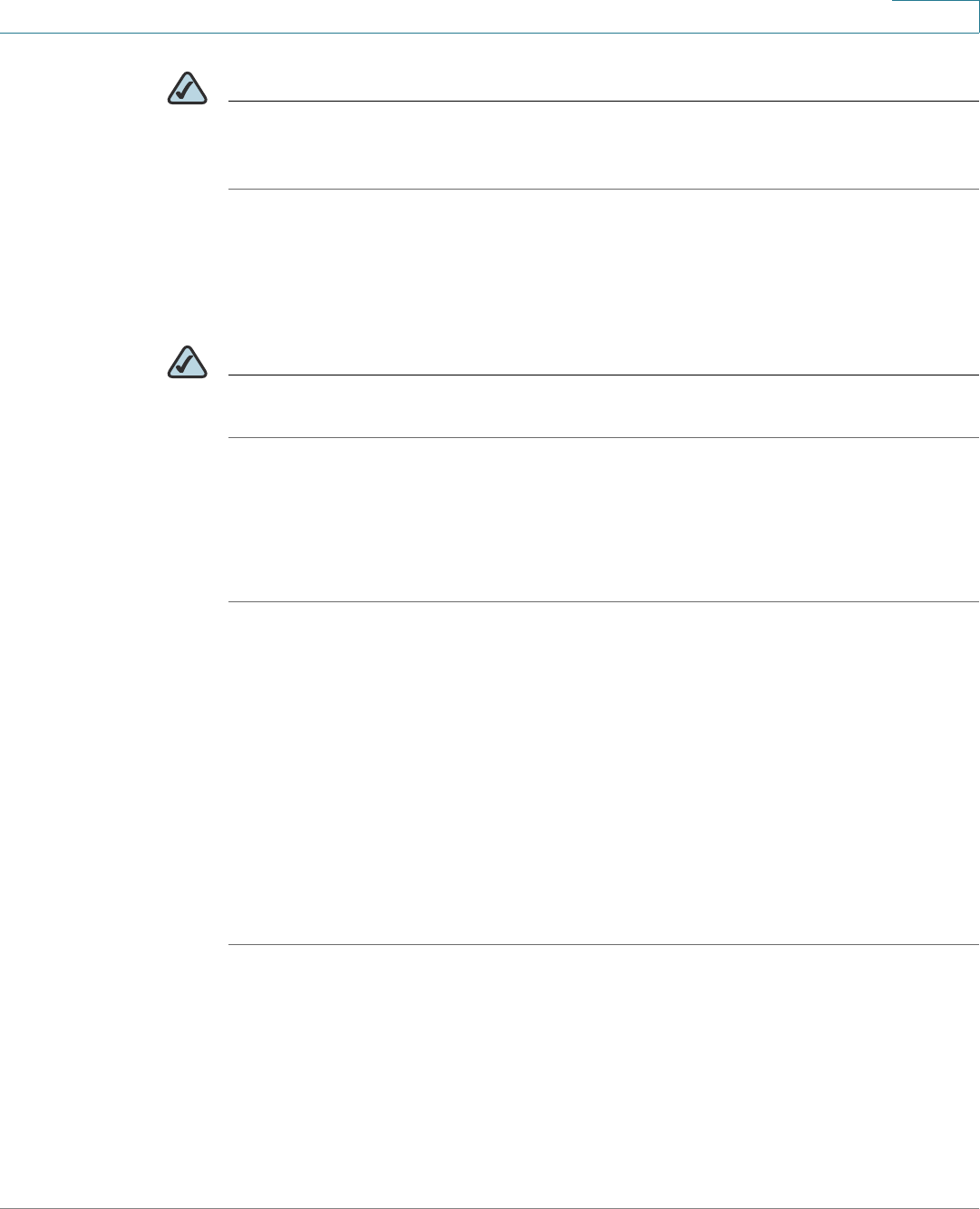
Administering Your Cisco RV180/RV180W
Configuring Logging
Cisco RV180/RV180W Administration Guide 138
7
DRAFT - CISCO CONFIDENTIAL
NOTE The packet trace is limited to 1MB of data per capture session. When the capture
file size exceeds 1MB, it will be deleted automatically and a new capture file will be
created.
Configuring Logging
NOTE Enabling logging options may generate a significant volume of log messages and
is recommended for debugging purposes only.
Configuring Logging Policies
To configure general logging policies:
STEP 1 Choose Administration > Logging > Logging Policies.
STEP 2 The Logging Policy Table shows the types of logging that are configured on the
system. To add a new type of logging, click Add.
STEP 3 Enter a name for the policy.
STEP 4 (Optional) Check Enable to log IPSec VPN events.
STEP 5 In the table, select the type of logs to capture for each severity. For example, you
might want to log all types of events that have a severity level of “Emergency,” so
you would check System, Kernel, and Wireless under “Emergency.”
STEP 6 Click Save.
Configuring Firewall Logs
To configure firewall logs:

Administering Your Cisco RV180/RV180W
Configuring Logging
Cisco RV180/RV180W Administration Guide 139
7
DRAFT - CISCO CONFIDENTIAL
STEP 1 Choose Administration > Logging > Firewall Logs.
STEP 2 Under the type of routing logs, check the box to choose one or both of the
following for each type:
•Accepted Packets—Check this box to log packets that were successfully
transferred through the segment. This option is useful when the Default
Outbound Policy is “Block” (see Configuring the Default Outbound Policy,
page 76). For example, if Accept Packets is checked for LAN to WAN and
there is a firewall rule to allow ssh traffic from the LAN, then whenever a LAN
machine tries to make an ssh connection, those packets will be accepted
and a message will be logged. (Make sure the log option is set to allow for
this firewall rule.)
•Dropped Packets—Check this box to log packets that were blocked from
being transferred through the segment. This option is useful when the
Default Outbound Policy is “Allow” (see Configuring the Default Outbound
Policy, page 76). For example, if Dropped Packets is checked for LAN to
WAN and there is a firewall rule to block ssh traffic from LAN, then whenever
a LAN machine tries to make an ssh connection, those packets will be
dropped and a message will be logged. (Make sure the log option is set to
allow for this firewall rule.)
STEP 3 Under the type of system logs, select the type of system events to be logged. The
following system events can be recorded:
•All Unicast Traffic—Check this box to log all unicast packets directed to the
router.
•All Broadcast/Multicast Traffic—Check this box to log all broadcast or
multicast packets directed to the router.
STEP 4 Under “other events logs,” select the type of event to be logged. The following
events can be recorded:
•Source MAC Filter—Check this box to log packets matched due to source
MAC filtering. Uncheck this box to disable source MAC filtering logs.
•Bandwidth Limit—Check this box to log packets dropped due to Bandwidth
Limiting.
STEP 5 Click Save.

Administering Your Cisco RV180/RV180W
Configuring Logging
Cisco RV180/RV180W Administration Guide 140
7
DRAFT - CISCO CONFIDENTIAL
Configuring Remote Logging
To configure remote logging:
STEP 1 Choose Administration > Logging > Remote Logging Configuration.
STEP 2 In the Remote Log Identifier field, enter a prefix to add to every logged message
for easier identification of the source of the message. The log identifier will be
added to both e-mail and Syslog messages.
STEP 3 Click Save.
Configuring Email Logging
STEP 1 Choose Administration > Logging > Remote Logging Configuration.
STEP 2 Select the check box to enable e-mail logs. Then enter the following:
•E-mail Server Address—Enter the IP address or Internet Name of an SMTP
server. The router will connect to this server to send e-mail logs when
required.
•SMTP Port—Configure the port to connect smtp server.
•Return E-mail Address—Enter the e-mail address where the replies from the
SMTP server are to be sent (required for failure messages).
•Send To E-mail Address(1)—Enter the e-mail address where the logs and
alerts are to be sent.
•Send To E-mail Address(2)—Enter the e-mail address where the logs and
alerts are to be sent.
•Send To E-mail Address(3)—Enter the e-mail address where the logs and
alerts are to be sent.
•Authentication with SMTP server—If the SMTP server requires
authentication before accepting connections, select either Login Plain or
CRAM-MD5 and enter the Username and Password to be used for
authentication. To disable authentication, select None.
•Respond to Identd from SMTP Server—Check this box to configure the
router to respond to an IDENT request from the SMTP server.
STEP 3 To confirm that the e-mail logs function is configured correctly, press Te s t .

Administering Your Cisco RV180/RV180W
Configuring the Discovery Settings
Cisco RV180/RV180W Administration Guide 141
7
DRAFT - CISCO CONFIDENTIAL
STEP 4 (Optional) To receive e-mail logs according to a schedule, configure the
appropriate schedule settings:
•Unit—Select the period of time that you need to send the log: Hourly, Daily,
or Weekly. To disable sending of logs, select Never. This option is useful
when you do not want to receive logs by e-mail, but want to keep e-mail
options configured so that you can use the Send Log function from the Status
> View Logs pages.
•Day—If logs are to be sent on a weekly basis, choose the day of the week.
•Time—Select the time of day when logs should be sent.
STEP 5 Under Logging Policy, choose the type of logging policy. (See Configuring
Logging Policies, page 138.) By default, only IPsec VPN logs are enabled. Others
are disabled.
STEP 6 If you want the router to send logs to a Syslog server, check the box next to a
syslog server field and enter the IP address or Internet Name of the Syslog server
in the Syslog Server field. Choose the logging policy for each syslog server. You
can configure up to 8 syslog servers.
STEP 7 Click Save.
Configuring the Discovery Settings
The Cisco RV180/RV180W supports two types of discovery protocols: Bonjour
and Universal Plug and Play (UPnP).
Configuring Bonjour
Bonjour is a service advertisement and discovery protocol. To configure Bonjour:
STEP 1 Choose Administration > Discovery Settings > Discovery - Bonjour.
STEP 2 Check the Enable box to enable Bonjour on the router. Unchecking this will disable
Bonjour.
STEP 3 In the Bonjour Interface Control Table, you can see on which VLANs Bonjour is
enabled. For example, Bonjour is by default enabled on the default VLAN ID 1. That
means that the Cisco RV180/RV180W advertises itself to all devices connected to

Administering Your Cisco RV180/RV180W
Configuring the Discovery Settings
Cisco RV180/RV180W Administration Guide 142
7
DRAFT - CISCO CONFIDENTIAL
it on VLAN 1, and devices joining the network can connect to the Cisco RV180/
RV180W. If you have other VLANs created on your network, you can enable
Bonjour on those VLANs too. (See Configuring Virtual LAN (VLAN) Membership,
page 35 for more information.)
STEP 4 Click Save.
Configuring UPnP
Universal Plug and Play (UPnP) is a networking protocol that allows devices to
discover each other and communicate on the network. To configure UPnP:
STEP 1 Choose Administration > Discovery Settings > Discovery - UPnP.
STEP 2 Check Enable to enable UPnP.
STEP 3 In the Advertisement Period field, enter the number of seconds to specify how
often this router will broadcast its UPnP information to all devices within range.
STEP 4 In the Advertisement Time to Live field, enter the number of seconds for the
advertisement to be active.
In the UPnP Interface Control Table, you can see on which VLANs UPnP is enabled.
For example, UPnP is by default enabled on the default VLAN ID 1. That means that
the Cisco RV180/RV180W advertises itself to plug and play devices connected to
it on VLAN 1, and plug and play devices joining the network can connect to the
Cisco RV180/RV180W. If you have other VLANs created on your network, you can
enable UPnP on those VLANs too. (See Configuring Virtual LAN (VLAN)
Membership, page 35 for more information.)
The UPnP Portmap Table shows IP addresses and other settings of UPnP devices
that have accessed the Cisco RV180/RV180W:
•Active—Indicates whether or not the port of the UPnP device that
established a connection is currently active by displaying Yes or No.
•Protocol—The network protocol (i.e. TCP, UDP, etc) that the device is using to
connect to the Cisco RV180/RV180W.
•Internal Port—Indicates which, if any, internal ports are opened by the UPnP
device.
•External Port—Indicates which, if any, external ports are opened by the
UPnP device.

Administering Your Cisco RV180/RV180W
Configuring Time Settings
Cisco RV180/RV180W Administration Guide 143
7
DRAFT - CISCO CONFIDENTIAL
•IP Address—The IP address of the UPnP device that is accessing this router.
STEP 5 Click Save.
Configuring Time Settings
You can configure your time zone, whether or not to adjust for Daylight Savings
Time, and with which Network Time Protocol (NTP) server to synchronize the date
and time. The router then gets its date and time information from the NTP server. To
configure NTP and time settings:
STEP 1 Choose Administration > Time Settings.
STEP 2 Select your time zone, relative to Greenwich Mean Time (GMT).
STEP 3 If supported for your region, check the Adjust for Daylight Savings Time box. In the
“From” and “To” fields, enter the month and day for which Daylight Saving Time will
be active. In the Daylight Saving Offset field, choose the amount of time, in
minutes, that the clock will be offset during daylight saving time.
STEP 4 Select whether to use a Network Time Protocol (NTP) server, or set the time and
date manually.
STEP 5 If you chose NTP, choose to use either a default NTP server, or a custom NTP
server.
STEP 6 If you chose to use a default NTP server, choose the server you want to use from
the list. If you chose to use a custom NTP server, enter the server addresses or
fully-qualified domain name.
STEP 7 If you chose to set the date and time manually, enter the date and time.
STEP 8 Click Save.
Backing Up and Restoring the System
You can back up custom configuration settings for later restoration or restore from
a previous backup from the Administration > Backup/Restore Settings page.

Administering Your Cisco RV180/RV180W
Backing Up and Restoring the System
Cisco RV180/RV180W Administration Guide 144
7
DRAFT - CISCO CONFIDENTIAL
When the router is working as configured, you can back up the configuration for
restoring later. During backup, your settings are saved as a file on your PC. You can
restore the router's settings from this file.
!
CAUTION During a restore operation, do not try to go online, turn off the router, shut down the
PC, or do anything else to the router until the operation is complete. This should
take about a minute. When the test light turns off, wait a few more seconds before
doing anything with the router.
To back up a configuration or restore a previously-saved configuration, select
Administration > Backup/Restore Settings.
To restore your saved settings from a backup file, click Browse, locate and select
the file, and click Restore. An alert page displays the status of the restore
operation. After the restore, the router restarts automatically with the restored
settings.
To save a copy of your router’s startup configuration, click Backup Startup
Configuration. The browser downloads the configuration file and prompts you to
save the file on the PC.
To save a copy of your router’s mirror configuration, click Backup Mirror
Configuration. The browser downloads the configuration file and prompts you to
save the file on the PC.
The mirror image is the last working configuration. The startup configuration is the
configuration that the device used to boot up. The startup and mirror
configurations can differ. For example, if you made changes to the current
configuration but forgot to save it, after 24 hours, the device automatically saves
the currently-running configuration as the “mirror” image. But if the device crashed
during the 24 hour window, then the device will use the startup configuration to
boot up.
To copy the mirror configuration file to the startup configuration file, click Copy
Mirror to Startup. This replaces the startup configuration file with the mirror
configuration file. You may want to do this if the device crashed and you had to
reset the device to factory defaults. After you perform the factory reset, the mirror
image is not erased, and you can copy it to the startup configuration to allow the
device to use the configuration to boot up.
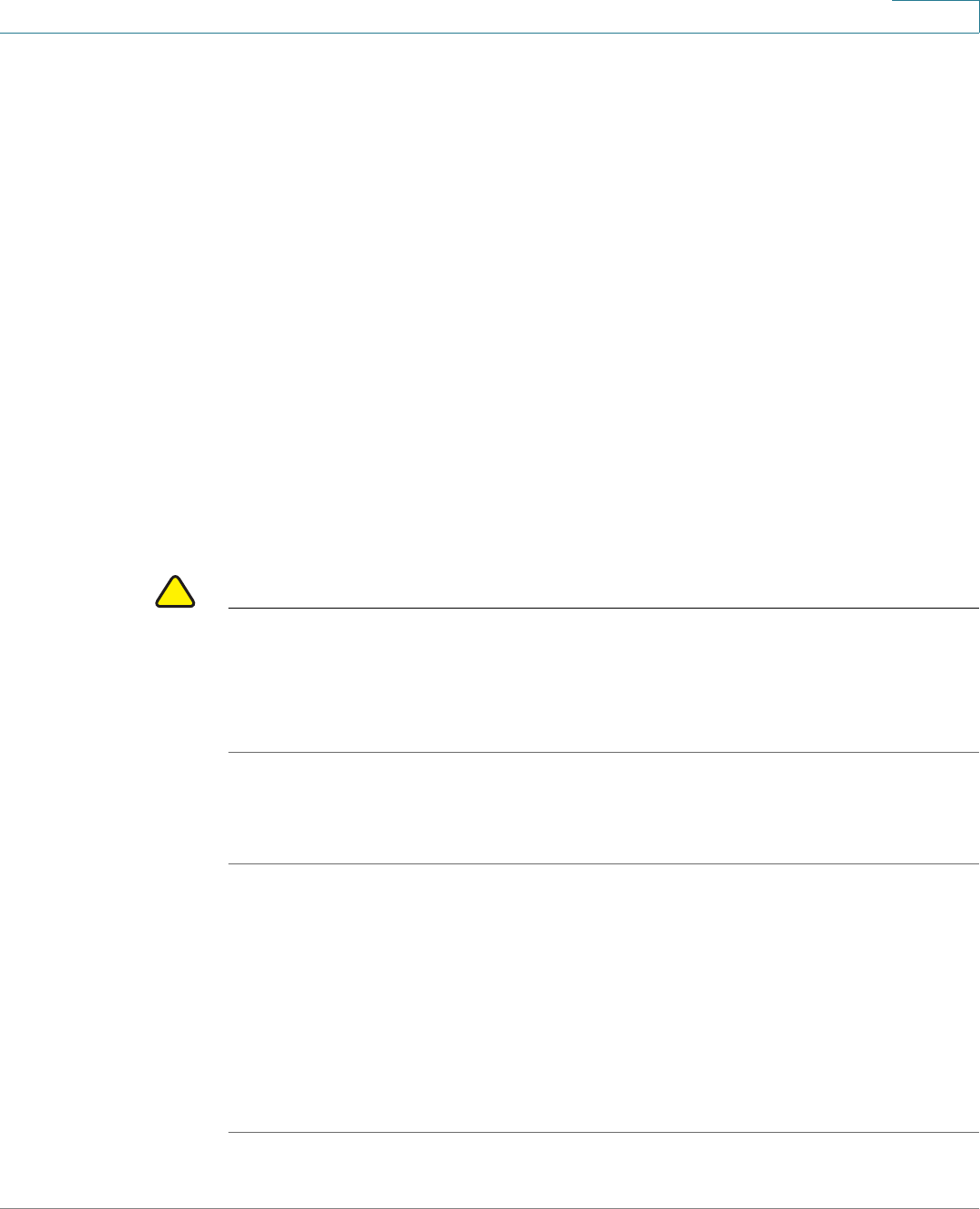
Administering Your Cisco RV180/RV180W
Importing CSV Files
Cisco RV180/RV180W Administration Guide 145
7
DRAFT - CISCO CONFIDENTIAL
Importing CSV Files
You can import VPN client setting files that contain the username and passwords
of clients in a Comma Separated Value (CSV) text file. You can use Excel to create
a CSV file containing the VPN client settings. The file should contain one row for
the headings and one or more rows for the VPN clients. For example, the following
specifies the settings of two users (a PPTP user and a QuickVPN user) to import:
Upgrading Firmware
!
CAUTION During a firmware upgrade, do not try to go online, turn off the device, shut down
the PC, or interrupt the process in any way until the operation is complete. This
process takes about a minute, including the reboot process. Interrupting the
upgrade process at specific points when the flash is being written to may corrupt
the flash memory and render the router unusable.
You can upgrade to a newer firmware version from the Administration > Firmware
Upgrade page. To upgrade:
STEP 1 Click Browse, locate and select the downloaded firmware, and click Upload.
STEP 2 (Optional) Check the box to reset all configuration and settings to the default
values. Do not check this box if you want to keep any settings you have changed
on the router!
STEP 3 Click Start Firmware Upgrade. After the new firmware image is validated, the new
image is written to flash, and the router is automatically rebooted with the new
firmware. Choose Status > System Summary to make sure the router installed the
new firmware version.
PROTOCOL USERNAME PASSWORD
PPTP pptp-user-1 12345678
QuickVPN qv-user-1 12345678
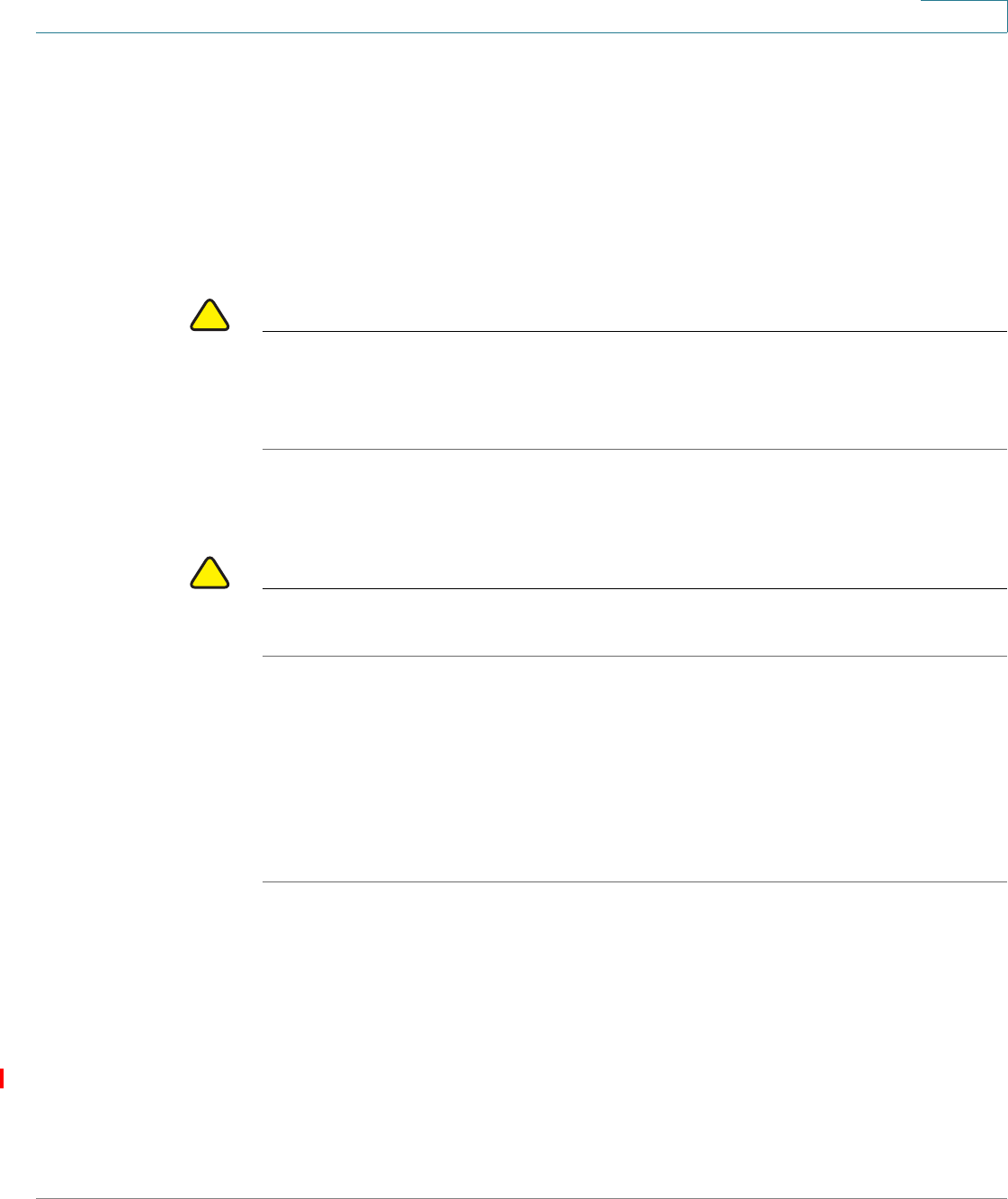
Administering Your Cisco RV180/RV180W
Rebooting the Cisco RV180/RV180W
Cisco RV180/RV180W Administration Guide 146
7
DRAFT - CISCO CONFIDENTIAL
Rebooting the Cisco RV180/RV180W
To reboot the router, choose Administration > Reboot Router. Click Reboot.
Restoring the Factory Defaults
!
CAUTION During a restore operation, do not try to go online, turn off the router, shut down the
PC, or do anything else to the router until the operation is complete. This should
take about a minute. When the test light turns off, wait a few more seconds before
doing anything with the router.
To restore factory defaults to the router, choose Administration > Restore Factory
Defaults. Click Default.
!
CAUTION Do not perform this procedure unless you want to erase all configuration you have
performed on the router.
Choosing the Device Mode (Cisco RV180W)
You can configure the Cisco RV180W device mode to choose how the device
performs in your network. To choose the device mode:
STEP 1 Choose Device Mode.
STEP 2 Click to select the device mode for the Cisco RV180W:
•Router—The Cisco RV180W acts as the wireless router in the network.
•Access Point—The Cisco RV180W acts as the access point in the network.
The WAN port is disabled, and the four Ethernet ports can be used to
connect to another router or switch.
•WDS Bridge—The Cisco RV180W acts as a wireless bridge to another
wireless network.

Administering Your Cisco RV180/RV180W
Choosing the Device Mode (Cisco RV180W)
Cisco RV180/RV180W Administration Guide 147
7
DRAFT - CISCO CONFIDENTIAL
•WDS Repeater—The Cisco RV180W connects using wireless to another
wireless network and repeats the wireless signal to clients behind the Cisco
RV180W.
STEP 3 Click Save.

8
Cisco RV120W Administration Guide 148
Viewing the Cisco RV180/RV180W Status
This chapter describes how to view real-time statistics and other information
about the Cisco RV120W.
•Viewing the Dashboard, page 148
•Viewing the System Summary, page 151
•Viewing the Wireless Statistics (Cisco RV180W), page 154
•IPsec Connection Status, page 155
•Viewing VPN Client Connection Status, page 156
•Viewing Logs, page 157
•Viewing Available LAN Hosts, page 157
•Viewing Port Triggering Status, page 158
•Viewing Port Statistics, page 159
•Viewing Open Ports, page 160
Viewing the Dashboard
The Dashboard page provides you with a view of important router information.
To view the Dashboard:
STEP 1 Choose Status > Dashboard.
STEP 2 To display an interactive view of the router’s back panel, click Show Panel View.

Viewing the Cisco RV180/RV180W Status
Viewing the Dashboard
Cisco RV120W Administration Guide 149
8
The view of the back panel shows you which ports are used (colored in green) and
allows you to click the port to obtain information about the connection.
•To view a port’s connection information, click the port.
•To refresh the port information, click Refresh.
•To close the port information sheet, click Close.
The Dashboard page displays the following:
Device Information
Resource Utilization
Syslog Summary
Indicates whether logging is enabled for these event categories:
•Emergency
•Alert
•Critical
•Error
•Warning
Host Name The name of the device.
To change the name, click Edit. See Configuring
IPv4 LAN (Local Network) Settings, page 32.
Firmware Version The current software version the device is running.
Serial Number The serial number of the device.
CPU CPU utilization.
Memory Memory utilization.
Current Time Time of day.
System Up Time How long the system has been running.

Viewing the Cisco RV180/RV180W Status
Viewing the Dashboard
Cisco RV120W Administration Guide 150
8
To view the logs, click details. For more information see Viewing Logs, page 157.
To m a n a g e l o g s , c l i c k manage logging. For more information see Configuring
Logging, page 138.
LAN (Local Network) Interface
To view the LAN settings, click details. For more information see Viewing Port
Statistics, page 159.
WAN (Internet) Information
To view the WAN settings, click details. For more information see Viewing Port
Statistics, page 159.
Wireless Networks
Lists the status of the four wireless network SSIDs.
To view the router’s wireless settings, click details. For more information see
Viewing the Wireless Statistics (Cisco RV180W), page 154.
MAC Address The MAC address of the router.
IPv4 Address The local IP address of the router.
To change the IP address, see Configuring the
IPv4 WAN (Internet), page 25.
DHCP Server The status of the router’s DHCP server
(enabled or disabled).
To configure the DHCP settings, see Configuring
the IPv4 WAN (Internet), page 25.
IP Address The IP address of the router’s WAN port.
To change the IP address, see Configuring the
WAN (Internet) Settings, page 24.
State The state of the Internet connection (up or down).

Viewing the Cisco RV180/RV180W Status
Viewing the System Summary
Cisco RV120W Administration Guide 151
8
VPN
Viewing the System Summary
The System Summary page displays a summary of the router’s settings.
To view a summary of system settings:
STEP 1 Choose Status > System Summary.
STEP 2 Click Refresh to obtain the latest information.
STEP 3 If applicable, to change a system setting, click its corresponding Edit link.
The System Summary page displays this information:
System Information
Site-to-Site Tunnels Displays the connected IPSec VPN tunnels.
PPTP Users The number of Point-to-Point Tunneling Protocol
(PPTP) users.
QuickVPN Users The number of QuickVPN users.
Host Name The name of the device.
Firmware Version Current software version the device is running.
Firmware MD5
Checksum
The message-digest algorithm used to verify the
integrity of files.
PID VID Product ID and version ID of the device.
Serial Number The serial number of the device.

Viewing the Cisco RV180/RV180W Status
Viewing the System Summary
Cisco RV120W Administration Guide 152
8
LAN (Local Network) Information
WAN (Internet) Information (IPv4)
MAC Address The MAC address of the device.
IPv4 Address The IP address and subnet mask of the device.
IPv6 Address The IP address and subnet mask of the device
(shown only if IPv6 is enabled).
DHCP Server The status of the router’s DHCP server
(enabled or disabled). If it is enabled, DHCP client
machines connected to the LAN port receive their
IP address dynamically.
DHCP Relay Whether the device is acting as a DHCP relay.
DHCPv6 Server Whether the device’s DHCPv6 server is enabled or
disabled. If it is enabled, DHCPv6 client systems
connected to the LAN port receive their IP address
dynamically.
MAC Address The MAC address of the WAN port.
Connection Time The time duration for which the connection is up.
Connection Type Shows weather the WAN IPv4 address is obtained
dynamically through a DHCP server, assigned
statically by the user, or obtained through a PPPoE/
PPTP/L2TP ISP connection.
Connection State Shows weather the WAN port is connected to the
Internet service provider.
DHCP Server The IP address of the DHCP server to which the
WAN por t is connected.
Lease Obtained The the time at which lease is obtained from the
DHCP server.
Lease Duration The duration for which the lease remains active.
IP Address The WAN Address of the device.
Subnet Mask The subnet mask of the WAN port.

Viewing the Cisco RV180/RV180W Status
Viewing the System Summary
Cisco RV120W Administration Guide 153
8
WAN (Internet) Information (IPv6)
Wireless Information
Channel
Gateway The gateway IP address of the WAN port.
Primary DNS Server The IP address of the primary DNS server.
Secondary DNS Server The IP address of the secondary DNS server.
NAT (IPv4 Only Mode)
Connection Time The time duration for which the connection is up.
Connection Type Shows weather the WAN IPv6 address is obtained
dynamically through a DHCP server, assigned
statically by the user, or obtained through a PPPoE/
PPTP/L2TP ISP connection.
Connection State Shows weather the WAN port is connected to the
ISP.
IP Address The IP address of the WAN port.
Gateway The gateway IP address of the WAN port.
DNS Server DNS server IP address of the WAN port.
Operating Frequency Displays the operational frequency band.
Wireless Network Mode Displays the Wi-Fi mode of the radio (for example,
N or N/G).
Channel Displays the current channel in use by the radio.
SSID The name of the SSID.
MAC Address The MAC address of the SSID.
Security The security setting for the SSID.
Encryption The encryption type used by the SSID.
Authentication The authentication type used by the SSID.

Viewing the Cisco RV180/RV180W Status
Viewing the Wireless Statistics (Cisco RV180W)
Cisco RV120W Administration Guide 154
8
Viewing the Wireless Statistics (Cisco RV180W)
The Wireless Statistics page shows a cumulative total of relevant wireless
statistics for the radio on the device.
To v i e w w i r e l e s s s t a t i s t i c s :
STEP 1 Choose Status > Wireless Statistics.
STEP 2 Click Stop.
STEP 3 In the Poll Interval field, enter the number of seconds the router waits before
updating the information on this page.
STEP 4 Click Start to restart automatic refresh at the specified poll interval.
The Wireless Statistics page displays this information:
NOTE The counters are reset when the device is restarted.
SSID The name of the wireless network.
Packets The number of received/sent wireless packets
reported to the radio over all configured and active
SSIDs.
Bytes The number of received/sent bytes of information
reported to the radio, over all configured APs.
Errors The number of received/sent packet errors
reported to the radio, over all configured APs.
Dropped The number of received/sent packets dropped by
the radio, over all configured APs.
Multicast The number of multicast packets sent over this
radio.
Collisions The number of packet collisions reported to the AP.

Viewing the Cisco RV180/RV180W Status
IPsec Connection Status
Cisco RV120W Administration Guide 155
8
IPsec Connection Status
The IPsec Connection Status page displays the status of IPsec connections.
To view the status of IPsec connections:
STEP 1 Choose Status > IPsec Connection Status.
STEP 2 Click Stop.
STEP 3 In the Poll Interval field, enter the number of seconds the router waits before
updating the information on this page.
STEP 4 Click Start to restart automatic refresh at the specified poll interval.
You can change the status of a connection to either establish or disconnect the
configured SAs (Security Associations).
Policy Name The name of the IKE or VPN policy associated with
this SA.
Endpoint Displays the IP address of the remote VPN
gateway or client.
Kbytes The data transmitted (in KB) over this SA.
Packets The number of IP packets transmitted over this SA.
State The current status of the SA for IKE policies. The
status can be IPsec SA Established or IPsec SA
Not Established.
Action Click Connect to establish an inactive SA
connection.
Click Drop to terminate an active SA connection.

Viewing the Cisco RV180/RV180W Status
Viewing VPN Client Connection Status
Cisco RV120W Administration Guide 156
8
Viewing VPN Client Connection Status
The VPN Client Connection Status page displays the status of VPN connections.
To view VPN user connection status:
STEP 1 Choose Status > VPN Client Connection Status.
STEP 2 Click Stop.
STEP 3 In the Poll Interval field, enter the number of seconds the router waits before
updating the information on this page.
STEP 4 Click Start to restart automatic refresh at the specified poll interval.
The VPN Client Connection Status page displays this information:
Username The username of the VPN user associated with the
QuickVPN or PPTP tunnel.
Remote IP Displays the IP address of the remote QuickVPN
client. This could be a NAT/Public IP if the client is
behind the NAT router.
Status Displays the current status of QuickVPN client.
OFFLINE means that QuickVPN tunnel is not
initiated/established by the VPN user. ONLINE
means that QuickVPN Tunnel, initiated/established
by the VPN user, is active.
Start Time The time of the VPN user establishing a connection.
End Time The time of the VPN user ending a connection.
Duration The duration between the VPN user establishing
and ending a connection.
Protocol The protocol the user uses, QuickVPN or PPTP.
Disconnect Click to disconnect this user.

Viewing the Cisco RV180/RV180W Status
Viewing Logs
Cisco RV120W Administration Guide 157
8
Viewing Logs
The View Logs page allows you to view the Cisco RV120W logs.
To view the logs:
STEP 1 Choose Status > View Logs.
STEP 2 Click Refresh Logs to display the latest log entries.
STEP 3 To specify the types of logs to display, choose an option from the Logging Policy
drop-down menu.
To delete all entries in the log window, click Clear Logs.
To email all log messages from the router, click Send Logs.
Viewing Available LAN Hosts
The Available LAN (Local Network) Hosts page displays information about the
devices connected to the Cisco RV120W.
To view a list of all available LAN hosts:
STEP 1 Choose Status > Available Local Network Hosts.
STEP 2 From the Filter drop-down menu, choose the interface type. You can choose one
of the following options:
STEP 3 Click Refresh to display the latest LAN host information.
All Displays a list of all devices connected to the
router.
Wireless Displays a list of all devices connected through the
wireless interface.
Wired Displays a list of all devices connected through the
Ethernet ports on the router.

Viewing the Cisco RV180/RV180W Status
Viewing Port Triggering Status
Cisco RV120W Administration Guide 158
8
The Available LAN (Local Network) Hosts page displays the following fields:
Viewing Port Triggering Status
To view the status of port triggering:
STEP 1 Choose Status > Port Triggering Status.
STEP 2 Click Refresh to display the latest port triggering information.
The Port Triggering Status window provides information on the ports that have
been opened per the port triggering configuration rules. The ports are opened
dynamically whenever traffic that matches the port triggering rules flows through
them.
The Port Triggering Status page displays the following fields:
Click Refresh to refresh the current page and obtain the latest statistics.
Name The name of the connected host.
IP Address The IP address of the host.
MAC Address The MAC address of the host.
Type The type of connection (for example, static or
dynamic).
Interface Type The interface type (Wired or Wireless).
LAN (Local Network)
IP Address
Displays the LAN IP address of the device which
caused the ports to be opened.
Open Ports Displays the ports that have been opened so that
traffic from WAN destined to the LAN IP address
can flow through the router.
Time Remaining
Seconds
This field displays the time for which the port will
remain open when there is no activity on that port.
The time is reset when there is activity on the port.

Viewing the Cisco RV180/RV180W Status
Viewing Port Statistics
Cisco RV120W Administration Guide 159
8
Viewing Port Statistics
The Port Statistics page displays port statistics.
To view port statistics:
STEP 1 Choose Status > Port Statistics.
STEP 2 In the Poll Interval field, enter the auto-refresh time interval in seconds. The
default value is 10.
STEP 3 To start the display of port statistics, click Start.
This page displays the latest port statistics based on the value you enter in the
Poll Interval field. For example, if you enter a poll interval value of 5, the router
refreshes the information on this page every 5 seconds.
This table displays the data transfer statistics for the Dedicated WAN, LAN, and
WLAN ports, including the duration for which they were enabled.
The Port Statistics page displays this information:
Port The name of the port.
Status The status of the port (enabled or disabled).
Operational Mode The bandwidth the port is operating at.
Packets The number of received/sent packets per second.
Bytes The number of received/sent bytes of information
per second.
Frames The number of received/sent frames per second.

Viewing the Cisco RV180/RV180W Status
Viewing Open Ports
Cisco RV120W Administration Guide 160
8
Viewing Open Ports
The View Open Ports page displays a listing of all open ports.
To view open ports, choose Status > View Open Ports.
This page displays this information about open ports:
Proto The protocol (TCP, UDP, and raw) used by the port.
Recv-Q The number of bytes not copied by the program
connected to this port.
Send-Q The number of bytes not acknowledged by the
program connected to this port.
Local Address The address and port number of the local end of
this socket.
Foreign Address The address and port number of the remote end of
this socket.
State The state of the port.
PID/Program name The process ID (PID) and name of the program
using the port (for example, 1654/thttpd, where
1654 is the PID and thttpd is the program’s name).

Viewing the Cisco RV180/RV180W Status
Viewing Open Ports
Cisco RV120W Administration Guide 161
8

A
Cisco RV120W Administration Guide 162
Using Cisco QuickVPN for Windows 7, 2000,
XP, or Vista
Overview
This appendix explains how to install and use the Cisco QuickVPN software that
can be downloaded from www.cisco.com. QuickVPN works with computers
running Windows 7, 2000, XP, or Vista. (Computers using other operating systems
will have to use third-party VPN software.)
This appendix includes the following sections:
•Before You Begin, page162
•Installing the Cisco QuickVPN Software, page 163
•Using the Cisco QuickVPN Software, page 164
Before You Begin
The QuickVPN program only works with a router that is properly configured to
accept a QuickVPN connection. You must perform the following steps:
STEP 1 Enable remote management. See Configuring Remote Management, page 130.
STEP 2 Create Quick VPN user accounts. See Configuring VPN Users, page 115. After a
user account is created, the credentials can be used by the Quick VPN client.

Using Cisco QuickVPN for Windows 7, 2000, XP, or Vista
Installing the Cisco QuickVPN Software
Cisco RV120W Administration Guide 163
A
Installing the Cisco QuickVPN Software
Installing from the CD-ROM
STEP 1 Insert the Cisco RV180/RV180W CD-ROM into your CD-ROM drive. After the
Setup Wizard begins, click the Install QuickVPN link.
The License Agreement window appears.
STEP 2 Click Yes to accept the agreement.
The InstallShield Wizard copies the appropriate files to the computer.
STEP 3 Click Browse and choose where to copy the files to
(for example, C:\Cisco Small Business\QuickVPN Client).
STEP 4 Click Next.
STEP 5 Click Finish to complete the installation.
Downloading and Installing from the Internet
STEP 1 Open a web browser and enter the following URL:
http://tools.cisco.com/support/downloads
STEP 2 Enter RV180/RV180W in the search box and find the QuickVPN software.
STEP 3 Save the zip file to your PC, and extract the .exe file.
STEP 4 Double-click the .exe file, and follow the on-screen instructions.
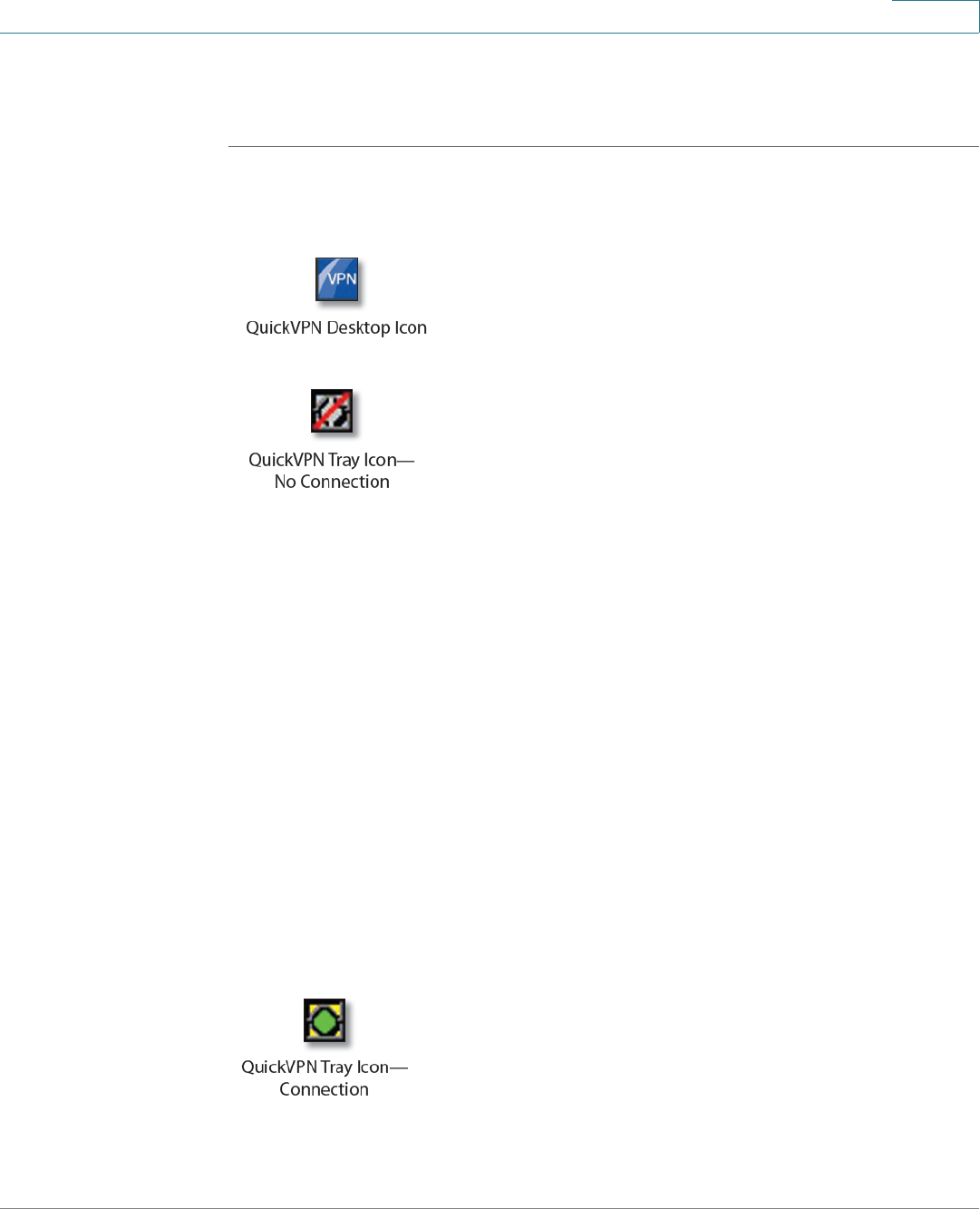
Using Cisco QuickVPN for Windows 7, 2000, XP, or Vista
Using the Cisco QuickVPN Software
Cisco RV120W Administration Guide 164
A
Using the Cisco QuickVPN Software
STEP 1 Double-click the Cisco QuickVPN software icon on your desktop or in the system
tray.
STEP 2 The QuickVPN Login window will appear. In the Profile Name field, enter a name
for your profile. In the User Name and Password fields, enter the User Name and
Password that were created in Configuring VPN Users, page 115. In the Server
Address field, enter the IP address or domain name of the Cisco RV180/RV180W.
In the Port For QuickVPN field, enter the port number that the QuickVPN client will
use to communicate with the remote VPN router, or keep the default setting, Auto.
To save this profile, click Save. (If there are multiple sites to which you will need to
create a tunnel, you can create multiple profiles, but note that only one tunnel can
be active at a time.) To delete this profile, click Delete. For information, click Help.
STEP 3 To begin your QuickVPN connection, click Connect. The connection’s progress is
displayed: Connecting, Provisioning, Activating Policy, and Verifying Network.
STEP 4 When your QuickVPN connection is established, the QuickVPN tray icon turns
green, and the QuickVPN Status window appears. The window displays the IP
address of the remote end of the VPN tunnel, the time and date the VPN tunnel
began, and the total length of time the VPN tunnel has been active.
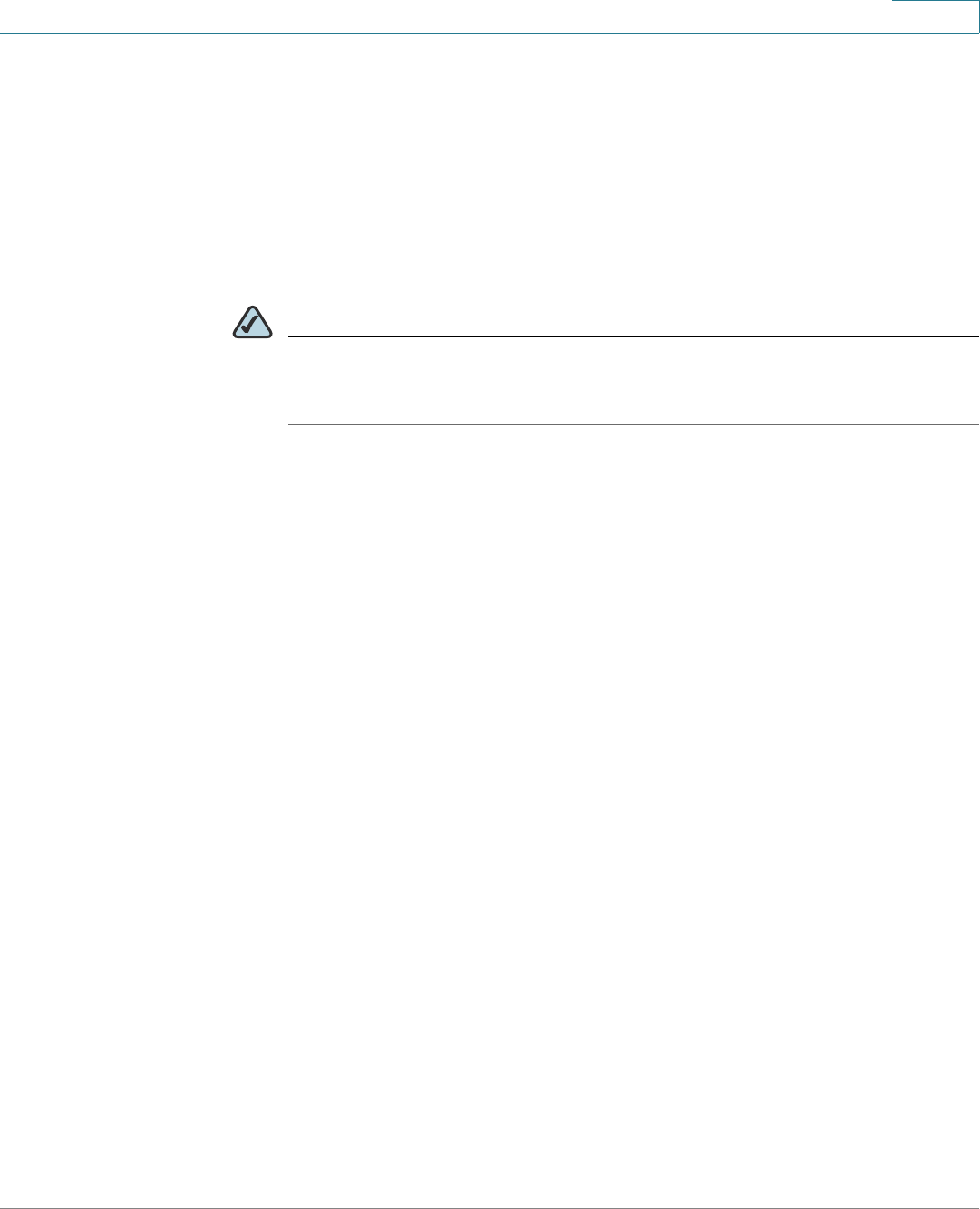
Using Cisco QuickVPN for Windows 7, 2000, XP, or Vista
Using the Cisco QuickVPN Software
Cisco RV120W Administration Guide 165
A
STEP 5 To terminate the VPN tunnel, click Disconnect. To change your password, click
Change Password. For information, click Help.
STEP 6 If you clicked Change Password and have permission to change your own
password, you will see the Connect Virtual Private Connection window. Enter your
password in the Old Password field. Enter your new password in the New
Password field. Then enter the new password again in the Confirm New Password
field. Click OK to save your new password. Click Cancel to cancel your change.
For information, click Help.
NOTE You can change your password only if the Allow User to Change Password
box has been checked for that username. See Configuring VPN Users,
page 115.

B
Cisco RV120W Administration Guide 166
Where to Go From Here
Cisco provides a wide range of resources to help you obtain the full benefits of the
Cisco RV120W.
Product Resources
Support
Cisco Small Business
Support Community
www.cisco.com/go/smallbizsupport
Cisco Small Business
Support and Resources
www.cisco.com/go/smallbizhelp
Phone Support Contacts www.cisco.com/en/US/support/
tsd_cisco_small_business
_support_center_contacts.html
Cisco Small Business
Firmware Downloads
www.cisco.com/go/software
Select a link to download firmware for Cisco Small
Business Products. No login is required.
Cisco Small Business Open
Source Requests
www.cisco.com/go/smallbiz_opensource_request
Product Documentation
Cisco RV180/RV180W www.cisco.com/go/smallbizrouters
Cisco Small Business
Cisco Partner Central for
Small Business (Partner
Login Required)
www.cisco.com/web/partners/sell/smb
Cisco Small Business
Home
www.cisco.com/smb